Paul van Yperen's Blog, page 30
December 11, 2024
Ross Verlag, Part 14: Unsere bunten Filmbilder
Ross Verlag in Berlin created thousands of large and small cigarette cards during the 1920s and 1930s. Around 1935, Ross made for the Cigarettenfabrik (cigarette factory) Josetti in Berlin a series of 275 cigarette cards called 'Unsere bunten Filmbilder' (Our Colourful Film Pictures). The cards were enclosed in the packs of Josetti's various brands of cigarettes, like Juno and Vera Gold. The series contained small cards (6, 5 x 4 cm or 2.5 x 2 inch) with hand-coloured portraits. The series was also distributed by the Cigarettenfabrik Salem in Dresden. Here are 15 of our favourite Colourful Film Pictures.
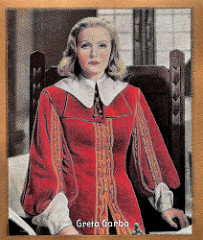
Greta Garbo . German cigarette card in the series Unsere bunten Filmbilder by Ross Verlag for Cigarettenfabrik Josetti, Berlin, no. 23. Photo: Metro-Goldwyn-Mayer. Publicity still for Queen Christina (Rouben Mamoulian, 1933).
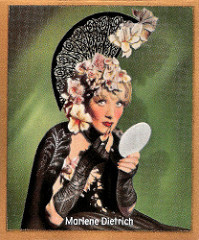
Marlene Dietrich . German cigarette card in the series Unsere bunten Filmbilder by Ross Verlag for Cigarettenfabrik Josetti, Berlin, no. 25. Photo: Paramount. Publicity still for The Devil is a Woman (Josef von Sternberg, 1935).
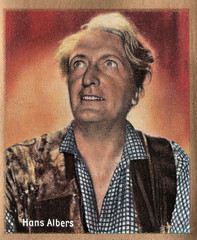
Hans Albers . German cigarette card in the series Unsere bunten Filmbilder by Ross Verlag for Cigarettenfabrik Josetti, Berlin, no. 37. Photo: Bavaria-Tofa. Publicity still for Peer Gynt (Fritz Wendhausen, 1934).
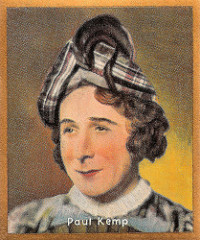
Paul Kemp . German cigarette card in the series Unsere bunten Filmbilder by Ross Verlag for Cigarettenfabrik Josetti, Berlin, no. 99. Photo: Minerva-Tonfilm. Publicity still for in Charleys Tante/Charley's Aunt (Robert A. Stemmle, 1934).
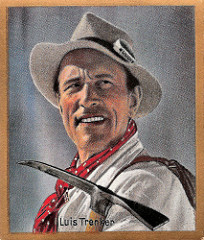
Luis Trenker . German cigarette card in the series Unsere bunten Filmbilder by Ross Verlag for Cigarettenfabrik Josetti, Berlin, no. 107. Photo: Rota-Film.
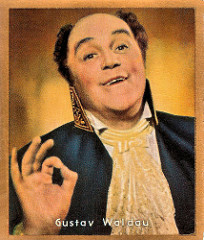
Gustav Waldau. German cigarette card in the series Unsere bunten Filmbilder by Ross Verlag for Cigarettenfabrik Josetti, Berlin, no. 132. Photo: Cine-Allianz.
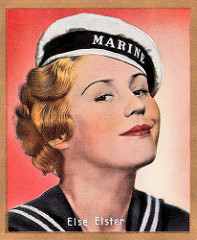
Else Elster . German cigarette card in the series Unsere bunten Filmbilder by Ross Verlag for Cigarettenfabrik Josetti, Berlin, no. 153. Photo: Alex Binder.
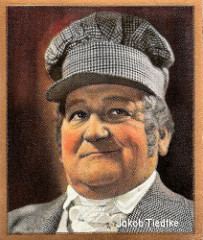
Jakob Tiedtke . German cigarette card in the series Unsere bunten Filmbilder by Ross Verlag for Cigarettenfabrik Josetti, Berlin, no. 179. Photo: Ufa.
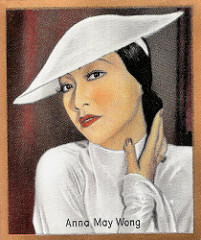
Anna May Wong . German cigarette card in the series Unsere bunten Filmbilder by Ross Verlag for Cigarettenfabrik Josetti, Berlin, no. 187. Photo: Paramount.
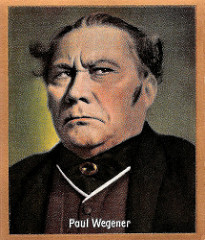
Paul Wegener . German cigarette card in the series Unsere bunten Filmbilder by Ross Verlag for Cigarettenfabrik Josetti, Berlin, no. 193. Photo: Lilenberger.
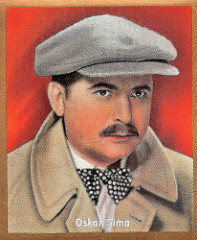
Oskar Sima . German cigarette card in the series Unsere bunten Filmbilder by Ross Verlag for Cigarettenfabrik Josetti, Berlin, no. 198. Photo: Ufa.
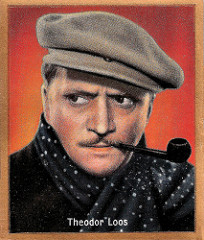
Theodor Loos. German cigarette card in the series Unsere bunten Filmbilder by Ross Verlag for Cigarettenfabrik Josetti, Berlin, no. 200. Photo: Nostra-Film.
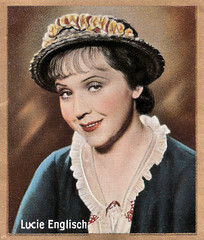
Lucie Englisch . German cigarette card in the series Unsere bunten Filmbilder by Ross Verlag for Cigarettenfabrik Salem, Dresden, no. 221. Photo: Albö-Film.
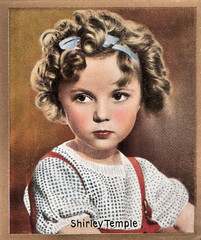
Shirley Temple . German cigarette card in the series Unsere bunten Filmbilder by Ross Verlag for Cigarettenfabrik Josetti, Berlin, no. 229. Photo: Fox.
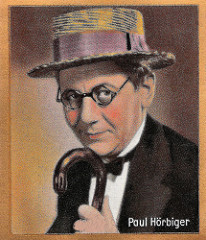
Paul Hörbiger . German cigarette card in the series Unsere bunten Filmbilder by Ross Verlag for Cigarettenfabrik Josetti, Berlin, no. 240. Photo: Patria-Film.
Our Ross Verlag tribute will be continued next week.

Greta Garbo . German cigarette card in the series Unsere bunten Filmbilder by Ross Verlag for Cigarettenfabrik Josetti, Berlin, no. 23. Photo: Metro-Goldwyn-Mayer. Publicity still for Queen Christina (Rouben Mamoulian, 1933).

Marlene Dietrich . German cigarette card in the series Unsere bunten Filmbilder by Ross Verlag for Cigarettenfabrik Josetti, Berlin, no. 25. Photo: Paramount. Publicity still for The Devil is a Woman (Josef von Sternberg, 1935).

Hans Albers . German cigarette card in the series Unsere bunten Filmbilder by Ross Verlag for Cigarettenfabrik Josetti, Berlin, no. 37. Photo: Bavaria-Tofa. Publicity still for Peer Gynt (Fritz Wendhausen, 1934).

Paul Kemp . German cigarette card in the series Unsere bunten Filmbilder by Ross Verlag for Cigarettenfabrik Josetti, Berlin, no. 99. Photo: Minerva-Tonfilm. Publicity still for in Charleys Tante/Charley's Aunt (Robert A. Stemmle, 1934).

Luis Trenker . German cigarette card in the series Unsere bunten Filmbilder by Ross Verlag for Cigarettenfabrik Josetti, Berlin, no. 107. Photo: Rota-Film.

Gustav Waldau. German cigarette card in the series Unsere bunten Filmbilder by Ross Verlag for Cigarettenfabrik Josetti, Berlin, no. 132. Photo: Cine-Allianz.

Else Elster . German cigarette card in the series Unsere bunten Filmbilder by Ross Verlag for Cigarettenfabrik Josetti, Berlin, no. 153. Photo: Alex Binder.

Jakob Tiedtke . German cigarette card in the series Unsere bunten Filmbilder by Ross Verlag for Cigarettenfabrik Josetti, Berlin, no. 179. Photo: Ufa.

Anna May Wong . German cigarette card in the series Unsere bunten Filmbilder by Ross Verlag for Cigarettenfabrik Josetti, Berlin, no. 187. Photo: Paramount.

Paul Wegener . German cigarette card in the series Unsere bunten Filmbilder by Ross Verlag for Cigarettenfabrik Josetti, Berlin, no. 193. Photo: Lilenberger.

Oskar Sima . German cigarette card in the series Unsere bunten Filmbilder by Ross Verlag for Cigarettenfabrik Josetti, Berlin, no. 198. Photo: Ufa.

Theodor Loos. German cigarette card in the series Unsere bunten Filmbilder by Ross Verlag for Cigarettenfabrik Josetti, Berlin, no. 200. Photo: Nostra-Film.

Lucie Englisch . German cigarette card in the series Unsere bunten Filmbilder by Ross Verlag for Cigarettenfabrik Salem, Dresden, no. 221. Photo: Albö-Film.

Shirley Temple . German cigarette card in the series Unsere bunten Filmbilder by Ross Verlag for Cigarettenfabrik Josetti, Berlin, no. 229. Photo: Fox.

Paul Hörbiger . German cigarette card in the series Unsere bunten Filmbilder by Ross Verlag for Cigarettenfabrik Josetti, Berlin, no. 240. Photo: Patria-Film.
Our Ross Verlag tribute will be continued next week.
Published on December 11, 2024 22:00
December 10, 2024
Peplum!
Today, the exhibition 'Antiquité et cinéma' opens in Paris at the Fondation Jérôme Seydoux-Pathé. From the Lumière brothers to Ridley Scott, from Maciste to Asterix, Antiquity has been the setting for various genre films. From its very beginnings, Antiquity in cinema has drawn on classical literature and biblical, mythological and historical stories to create epic frescoes and adventure films. In France, and especially in the United States and Italy, directors and studios redoubled their efforts and resources to bring to life on the screen forgotten worlds, often dazzling and sometimes exotic, whose heroes impressed the image with their stature, sensuality or strength. Above all, the years 1947-1965 left their mark on audiences, the years of the Peplums that were filmed at a frenetic pace in Rome, employing an entire star system. For this post, Ivo Blom selected 26 German and Austrian film programmes about Italian Peplums from his collection.
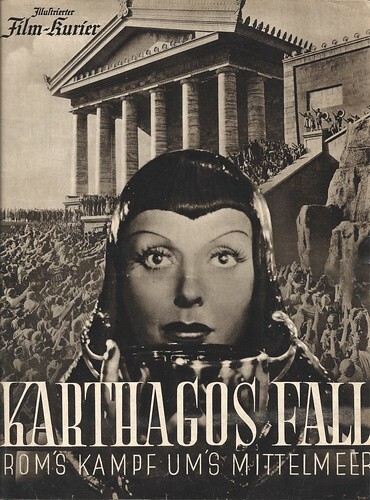
Cover page of a film programme by Illustrierte Film-Kurier, no. 2837. Francesca Braggiotti in Scipione l'Africano/Scipio the African (Carmine Gallone, 1937).
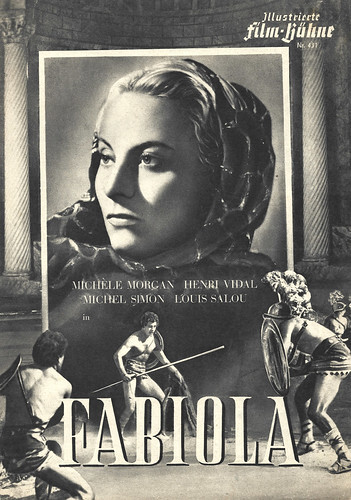
Cover page of a film programme by Illustrierte Film-Bühne, no. 431. Michèle Morgan in Fabiola (Alessandro Blasetti, 1949).
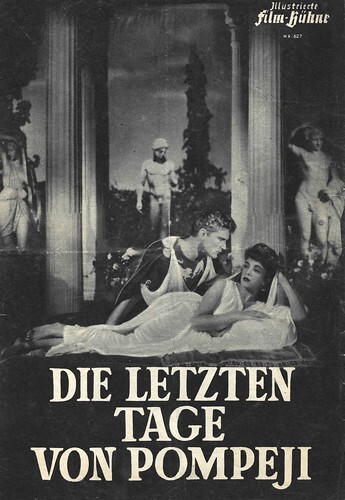
Cover page of a film programme by Illustrierte Film-Bühne, no. 627. Micheline Presle and Georges Marchal in Gli ultimi giorni di Pompei/Les derniers jours de Pompéi/Sins of Pompeii (Marcel L'Herbier, Paolo Moffa, 1950).
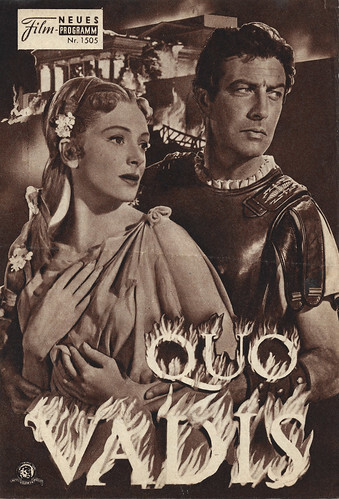
Cover page of a film programme by Neues Film-Programm, no. 1505. Robert Taylor and Deborah Kerr in Quo Vadis (Mervyn LeRoy, 1951).
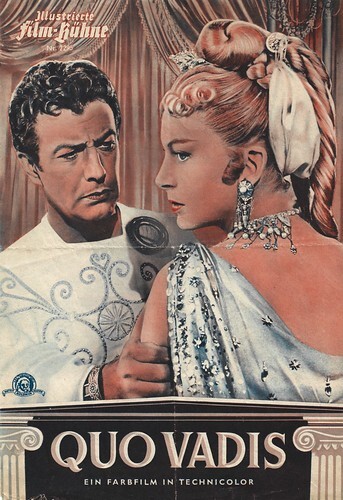
Cover page of a film programme by Illustrierte Film-Bühne, no. 2295. Robert Taylor and Deborah Kerr in Quo Vadis (Mervyn LeRoy, 1951).
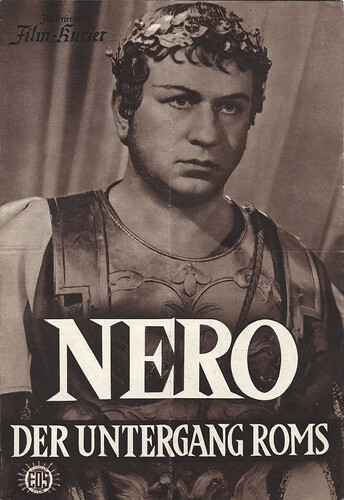
Cover page of a film programme by Illustrierte Film-Kurier, no. 1860. Gino Cervi as Nero in Nerone e Messalina/Nero and the Burning of Rome (Primo Zeglio, 1953).
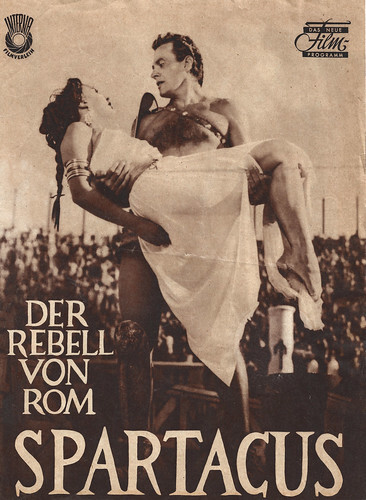
Cover page of a film programme by Das neue Film-Programm, (unnumbered). Massimo Girotti in Spartaco/Sins of Rome, Story of Spartacus (Riccardo Freda, 1953).
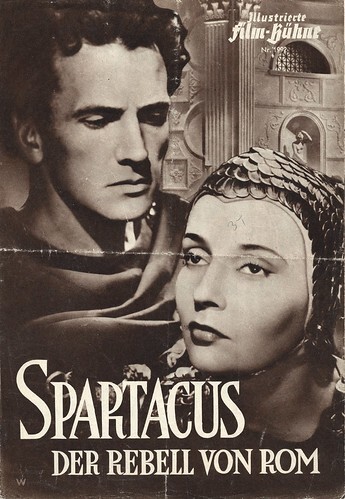
Cover page of a film programme by Illustrierte Film-Bühne, no. 1992. Massimo Girotti and Ludmilla Tchérina in Spartaco/Sins of Rome, Story of Spartacus (Riccardo Freda, 1953).
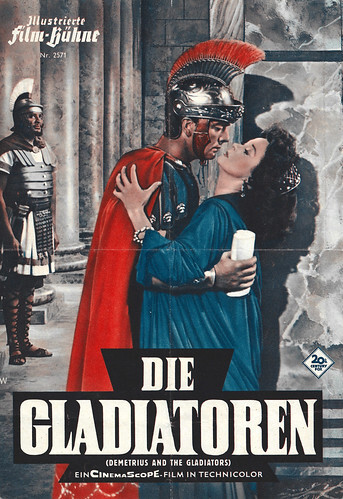
Cover page of a film programme by Illustrierte Film-Bühne, no. 2571. Victor Mature and Susan Hayward in Demetrius and the Gladiators (Delmer Daves, 1954).
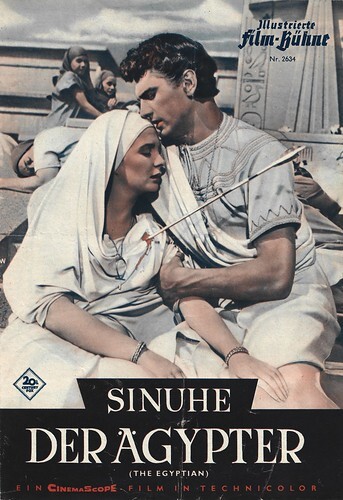
Cover page of a film programme by Illustrierte Film-Bühne, no. 2634. Edmund Purdom and Jean Simmons in The Egyptian (Michael Curtiz, 1954).
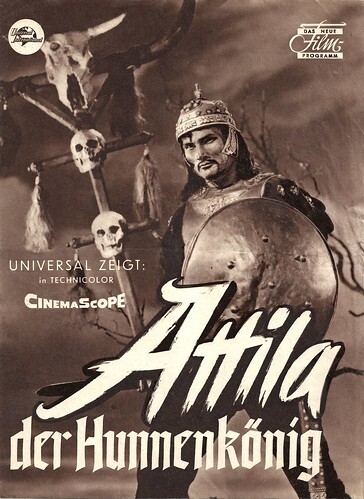
Cover page of a film programme by Das neue Film-Programm, (unnumbered). Jack Palance in Sign of the Pagan/Attila (Douglas Sirk, 1954).
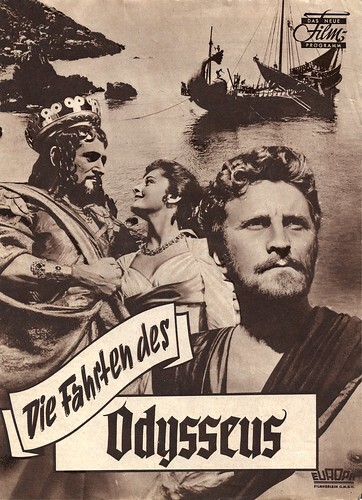
Cover page of a film programme by Das neue Film-Programm, (unnumbered). Kirk Douglas and Rosanna Podestà in Ulisse/Ulysses (Mario Camerini, 1954).
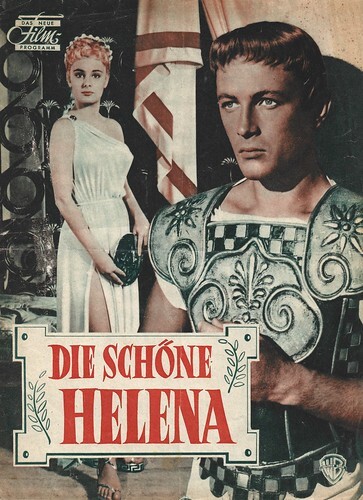
Cover page of a film programme by Das neue Film-Programm, (unnumbered). Jacques Sernas and Rossana Podestà in Helen of Troy (Robert Wise, Raoul Walsh, 1956).
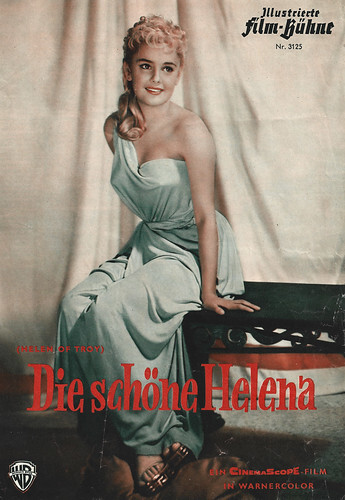
Cover page of a film programme by Illustrierte Film-Bühne, no. 3125. Rossana Podestà in Helen of Troy (Robert Wise, Raoul Walsh, 1956).
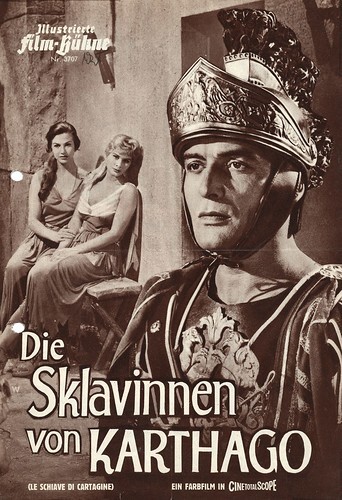
Cover page of a film programme by Illustrierte Film-Bühne, no. 3707. Jorge Mistral and Marisa Allasio in Le schiavi di Cartagine/The Sword and the Cross (Guido Brignone, 1956).
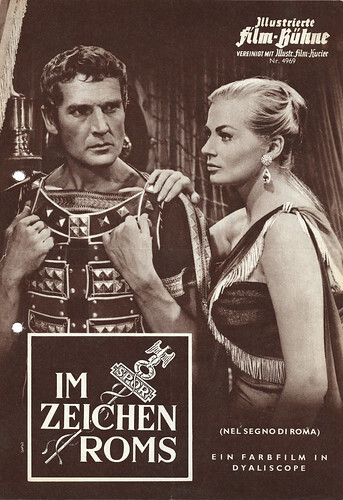
Cover page of a film programme by Illustrierte Film-Bühne, no. 4969. Anita Ekberg and Georges Marchal in Nel segno di Roma/Sign of the Gladiator (Guido Brignone, Michelangelo Antonioni, 1959).
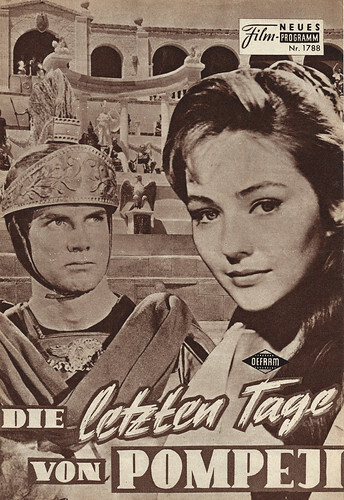
Cover page of an Austrian film programme by Neues Film-Programm, no. 1788. Steve Reeves and Christine Kaufmann in Gli ultimi giorni di Pompei/The Last Days of Pompeii (Mario Bonnard, 1959).
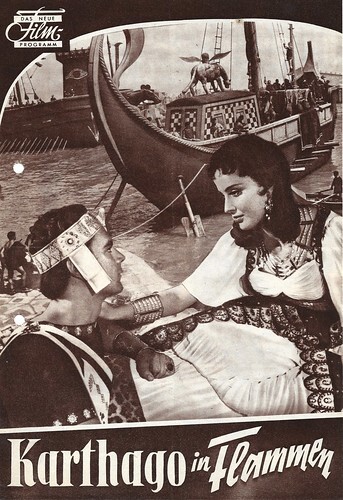
Cover page of an Austrian film programme by Das neue Film-Programm, unnumbered. Anne Heywood and Mario Girotti (Terence Hill) in Cartagine in fiamme/Carthage in Flames (Carmine Gallone, 1960).
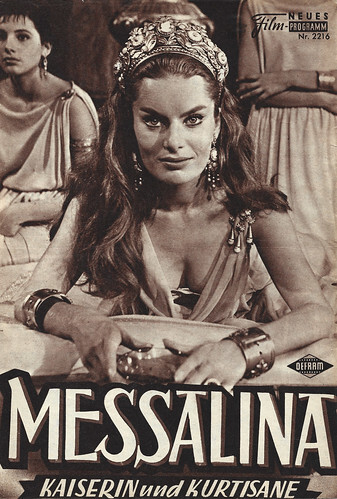
Cover of an Austrian film programme by Neues Filmprogramm, no. 2216. Photo: Oefram / Emo-Bistolfi. Belinda Lee as the notorious Roman Empress Messalina in Messalina Venere Imperatrice/Messalina (Vittorio Cottafavi, 1960). The German distribution title by Oefram-Film was Messalina Kaiserin und Kurtisane.
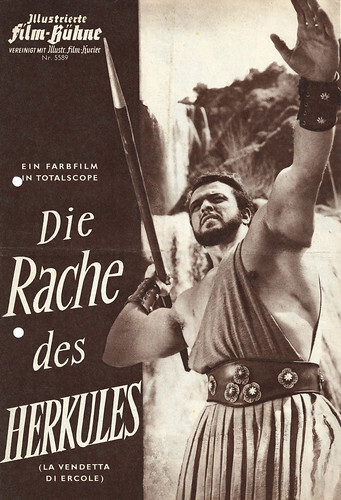
Cover page of a film programme by Illustrierte Film-Bühne, no. 5589. Mark Forest in La vendetta di Ercole/Goliath and the Dragon (Vittorio Cottafavi, 1960).
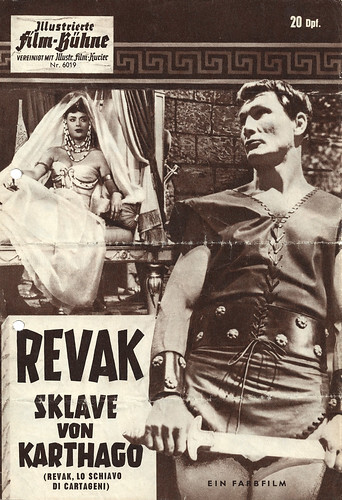
Cover page of a film programme by Illustrierte Film-Bühne, no. 6019. Jack Palance in The Barbarians/Revak, lo schiavo di Cartagine (Rudolph Maté, 1960).
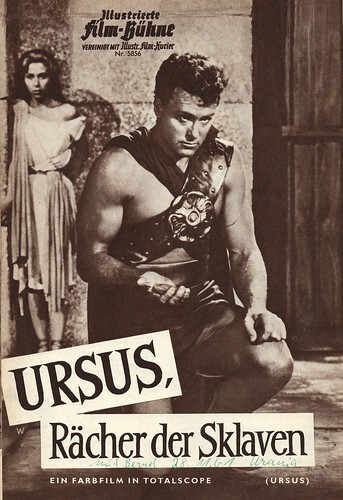
Cover page of a film programme by Illustrierte Film-Bühne, no. 5856. Ed Fury in Ursus/The Mighty Ursus (Carlo Campogalliani, 1961).
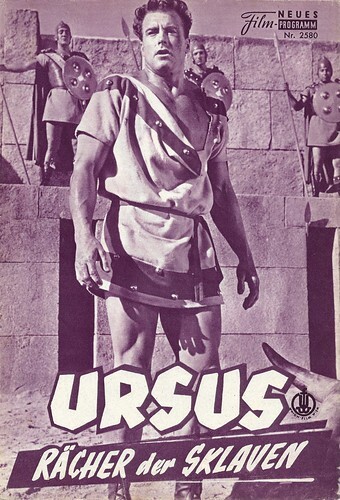
Cover page of an Austrian film programme by Neues Film-Programm, no. 2580. Ed Fury in Ursus/The Mighty Ursus (Carlo Campogalliani, 1961).
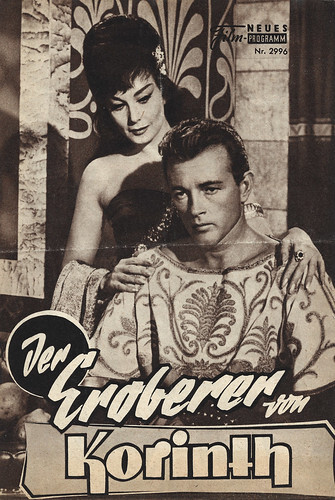
Cover page of an Austrian film programme by Neues Film-Programm, no. 2996. Jacques Sernas and Gianna Maria Canale in Il conquistatore di Corinto/Conqueror of Corinth (Mario Costa, 1961).
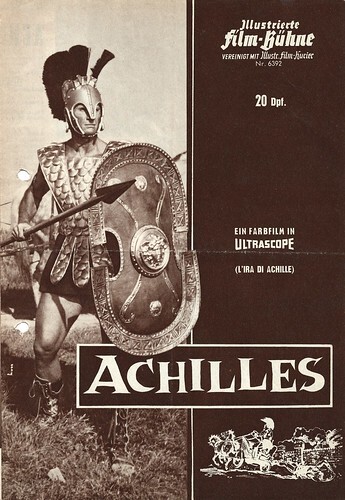
Cover page of a film programme by Illustrierte Film-Bühne, no. 6392. Gordon Mitchell in L'ira di Achille/Fury of Achilles (Marino Girolami, 1962).
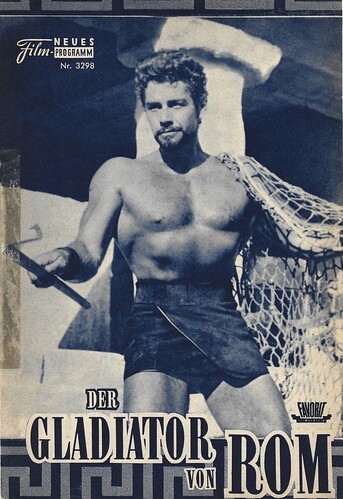
Cover page of an Austrian film programme by Neues Film-Programm, no. 3298. Gordon Scott in Il gladiatore di Roma/Gladiator of Rome (Mario Costa, 1962).
Source: Fondation Jérôme Seydoux-Pathé (French).

Cover page of a film programme by Illustrierte Film-Kurier, no. 2837. Francesca Braggiotti in Scipione l'Africano/Scipio the African (Carmine Gallone, 1937).

Cover page of a film programme by Illustrierte Film-Bühne, no. 431. Michèle Morgan in Fabiola (Alessandro Blasetti, 1949).

Cover page of a film programme by Illustrierte Film-Bühne, no. 627. Micheline Presle and Georges Marchal in Gli ultimi giorni di Pompei/Les derniers jours de Pompéi/Sins of Pompeii (Marcel L'Herbier, Paolo Moffa, 1950).

Cover page of a film programme by Neues Film-Programm, no. 1505. Robert Taylor and Deborah Kerr in Quo Vadis (Mervyn LeRoy, 1951).

Cover page of a film programme by Illustrierte Film-Bühne, no. 2295. Robert Taylor and Deborah Kerr in Quo Vadis (Mervyn LeRoy, 1951).

Cover page of a film programme by Illustrierte Film-Kurier, no. 1860. Gino Cervi as Nero in Nerone e Messalina/Nero and the Burning of Rome (Primo Zeglio, 1953).

Cover page of a film programme by Das neue Film-Programm, (unnumbered). Massimo Girotti in Spartaco/Sins of Rome, Story of Spartacus (Riccardo Freda, 1953).

Cover page of a film programme by Illustrierte Film-Bühne, no. 1992. Massimo Girotti and Ludmilla Tchérina in Spartaco/Sins of Rome, Story of Spartacus (Riccardo Freda, 1953).

Cover page of a film programme by Illustrierte Film-Bühne, no. 2571. Victor Mature and Susan Hayward in Demetrius and the Gladiators (Delmer Daves, 1954).

Cover page of a film programme by Illustrierte Film-Bühne, no. 2634. Edmund Purdom and Jean Simmons in The Egyptian (Michael Curtiz, 1954).

Cover page of a film programme by Das neue Film-Programm, (unnumbered). Jack Palance in Sign of the Pagan/Attila (Douglas Sirk, 1954).

Cover page of a film programme by Das neue Film-Programm, (unnumbered). Kirk Douglas and Rosanna Podestà in Ulisse/Ulysses (Mario Camerini, 1954).

Cover page of a film programme by Das neue Film-Programm, (unnumbered). Jacques Sernas and Rossana Podestà in Helen of Troy (Robert Wise, Raoul Walsh, 1956).

Cover page of a film programme by Illustrierte Film-Bühne, no. 3125. Rossana Podestà in Helen of Troy (Robert Wise, Raoul Walsh, 1956).

Cover page of a film programme by Illustrierte Film-Bühne, no. 3707. Jorge Mistral and Marisa Allasio in Le schiavi di Cartagine/The Sword and the Cross (Guido Brignone, 1956).

Cover page of a film programme by Illustrierte Film-Bühne, no. 4969. Anita Ekberg and Georges Marchal in Nel segno di Roma/Sign of the Gladiator (Guido Brignone, Michelangelo Antonioni, 1959).

Cover page of an Austrian film programme by Neues Film-Programm, no. 1788. Steve Reeves and Christine Kaufmann in Gli ultimi giorni di Pompei/The Last Days of Pompeii (Mario Bonnard, 1959).

Cover page of an Austrian film programme by Das neue Film-Programm, unnumbered. Anne Heywood and Mario Girotti (Terence Hill) in Cartagine in fiamme/Carthage in Flames (Carmine Gallone, 1960).

Cover of an Austrian film programme by Neues Filmprogramm, no. 2216. Photo: Oefram / Emo-Bistolfi. Belinda Lee as the notorious Roman Empress Messalina in Messalina Venere Imperatrice/Messalina (Vittorio Cottafavi, 1960). The German distribution title by Oefram-Film was Messalina Kaiserin und Kurtisane.

Cover page of a film programme by Illustrierte Film-Bühne, no. 5589. Mark Forest in La vendetta di Ercole/Goliath and the Dragon (Vittorio Cottafavi, 1960).

Cover page of a film programme by Illustrierte Film-Bühne, no. 6019. Jack Palance in The Barbarians/Revak, lo schiavo di Cartagine (Rudolph Maté, 1960).

Cover page of a film programme by Illustrierte Film-Bühne, no. 5856. Ed Fury in Ursus/The Mighty Ursus (Carlo Campogalliani, 1961).

Cover page of an Austrian film programme by Neues Film-Programm, no. 2580. Ed Fury in Ursus/The Mighty Ursus (Carlo Campogalliani, 1961).

Cover page of an Austrian film programme by Neues Film-Programm, no. 2996. Jacques Sernas and Gianna Maria Canale in Il conquistatore di Corinto/Conqueror of Corinth (Mario Costa, 1961).

Cover page of a film programme by Illustrierte Film-Bühne, no. 6392. Gordon Mitchell in L'ira di Achille/Fury of Achilles (Marino Girolami, 1962).

Cover page of an Austrian film programme by Neues Film-Programm, no. 3298. Gordon Scott in Il gladiatore di Roma/Gladiator of Rome (Mario Costa, 1962).
Source: Fondation Jérôme Seydoux-Pathé (French).
Published on December 10, 2024 22:00
December 9, 2024
Brad Pitt
Attractive American actor and producer Brad Pitt (1963) has received multiple awards and nominations. Pitt wildly varies his film choices, appearing in everything from high-concept popcorn flicks such as Troy (2004) to adventurous critic-bait like Inglourious Basterds (2009) and The Tree of Life (2011). He has received two Best Actor Oscar nominations, for The Curious Case of Benjamin Button (2008) and Moneyball (2011). Pitt won the Oscar for Best Supporting Actor for Once Upon a Time... in Hollywood (2019). He previously won an Oscar for Best Film with 12 Years a Slave (2013), which was produced by him.
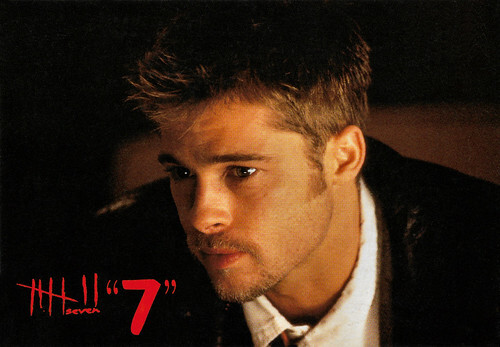
Turkish freecard by See You. Photo: United International Pictures / New Line Cinema. Brad Pitt in Se7en (David Fincher, 1995).
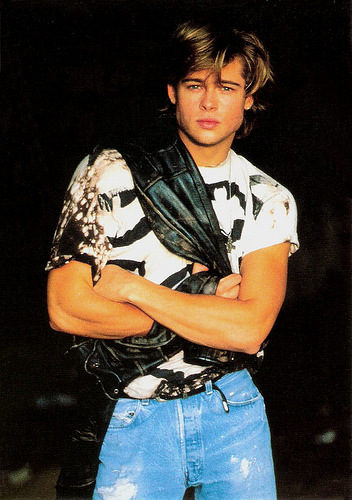
British postcard by Heroes Publishing LTD., London, no. SPC 2617.
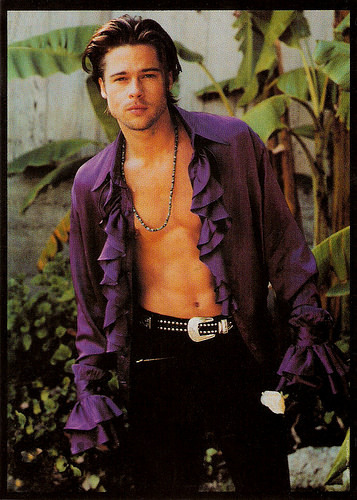
British postcard by Box Office, no. BO 034.

British postcard by Heroes Publishing LTD., London, no. SPC 2569.
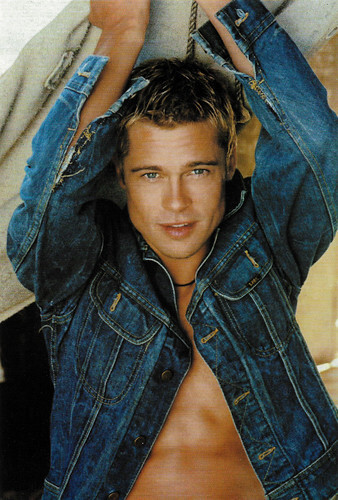
British postcard by Music Factory, no. 069. Photo: Herb Ritts.
A wickedly sexy hitchhiker
William Bradley ‘Brad’ Pitt was born in 1963 in Shawnee, Oklahoma, and brought up in a strict Baptist household. His parents were William Alvin Pitt, who ran a trucking company, and Jane Etta (née Hillhouse), a school counsellor. He has a younger brother, Douglas (Doug) Pitt, and a younger sister, Julie Neal Pitt. Following his graduation from high school, Pitt enrolled in the University of Missouri in 1982, majoring in journalism. Two weeks before earning his degree, he left the university and moved to Los Angeles, where he took acting lessons and worked odd jobs. Reportedly he chauffeured strippers to private parties, waited tables, and wore a giant chicken suit for a local restaurant chain. Pitt's acting career began with uncredited parts in such films as Less Than Zero (Marek Kanievska, 1987).
His television debut came in May 1987 with a two-episode role on the soap opera Another World. In November of the same year, Pitt had a guest appearance on the sitcom Growing Pains. He appeared in four episodes of the legendary prime-time soap opera Dallas (1987-1988). In 1989 he made his film debut with a featured role in the slasher Cutting Class (Rospo Pallenberg, 1989) with Donovan Leitch. Pitt first gained recognition as a wickedly sexy hitchhiker in the road movie Thelma & Louise (Ridley Scott, 1991), who seduces Thelma (Geena Davis) and robs her blind. Biography.com : “Pitt's combination of charming bad boy charisma and sensual playfulness — particularly in a fiery love scene with Geena Davis— made him a genuine sex symbol (and wore out the rewind button on many a VCR).“
His first leading roles in big-budget productions came with the dramas A River Runs Through It (Robert Redford, 1992) and Legends of the Fall (Edward Zwick, 1994), for which Pitt received his first Golden Globe Award nomination, in the Best Actor category. Both films gave the actor a much-needed chance to prove that he had talent in addition to his handsome looks. He then starred opposite Tom Cruise and Antonio Banderas as the brooding, gothic vampire Louis de Pointe du Lac in the romantic horror film Interview with the Vampire (Neil Jordan, 1994), based on the novel by Anne Rice.
Pitt also garnered attention for a brief appearance in the cult hit True Romance (Tony Scott, 1993) as a stoner named Floyd, providing comic relief to the action film written by Quentin Tarantino . Pitt gave critically acclaimed performances as an emotionally tortured detective investigating a series of gruesome crimes in the Horror-thriller Se7en (David Fincher, 1995) and as visionary mental patient Jeffrey Goines in 12 Monkeys (Terry Gilliam, 1995). This latter role got him a Golden Globe Award for Best Supporting Actor and an Academy Award nomination. Se7en earned $327 million at the international box office. He also starred in the legal drama Sleepers (Barry Levinson, 1996).
Pitt then played Tyler Durden, the mysterious and anti-materialistic soap salesman in Fight Club (David Fincher, 1999) about a bloody diversion for young professional males. This unglamorous, disturbing role was an interesting but odd choice for a man voted 'Most Sexy Actor Alive' by entertainment publications, but the film became a cult. Jason Clark in his review at AllMovie (now defunct): "A definitive case of a movie that has yet to find its time, David Fincher's unnerving and cataclysmic look at the male psyche takes no prisoners and makes no apologies, which is precisely why the film is so powerful. A kind of stepchild to Stanley Kubrick's A Clockwork Orange in terms of its thematic relevancy and misunderstood nature, Fight Club looks and feels like almost nothing that has preceded it. Brad Pitt, Edward Norton, and Helena Bonham Carter all successfully subvert their onscreen personas, and give fully committed portrayals that never get buried in the film's dazzling set pieces."
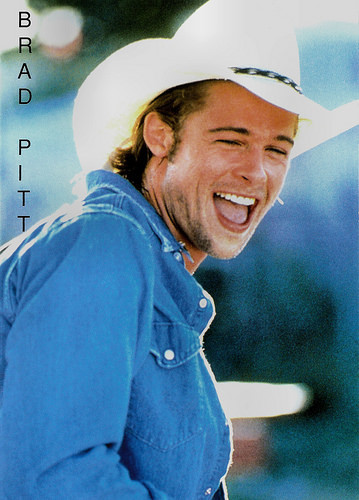
British postcard by Heroes Publishing Ltd, London, no. SPC 2506. Publicity still for Thelma & Louise (Ridley Scott, 1991).
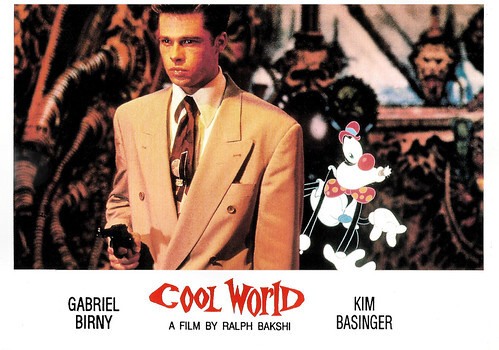
French postcard by Editions Mercuri, no. 781. Lobby Card for Brad Pitt in Cool World (Ralph Bakshi, 1992).
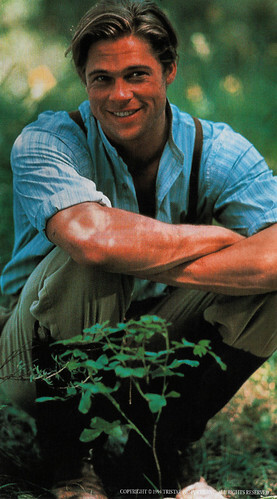
Vintage postcard. Photo: TriStar Pictures. Brad Pitt in Legends of the Fall (Edward Zwick, 1994).
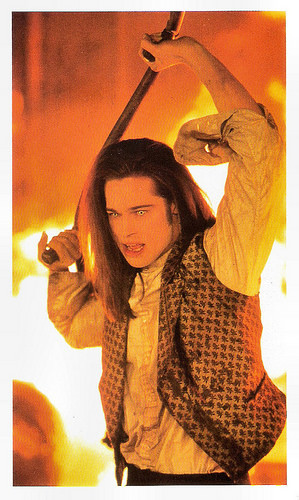
British Exclusive Collectors' Artcard. Photo: Geffen Pictures. Publicity still for Interview with the Vampire (Neil Jordan, 1994). Caption: Louis de Pointe Du Lac (Brad Pitt) is a broken man, devastated by the loss of his beloved wife and infant daughter. Becoming a vampire is his only relief.
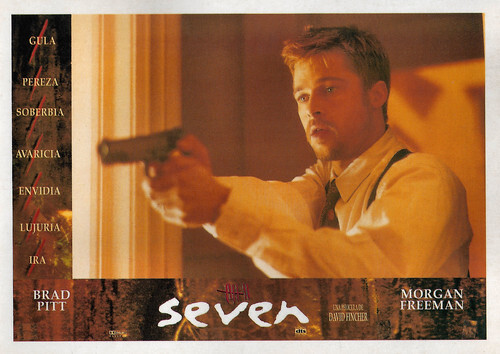
Vintage postcard by Memory Card, no. 168. Spanish lobby card of Brad Pitt in Seven (David Fincher, 1995).
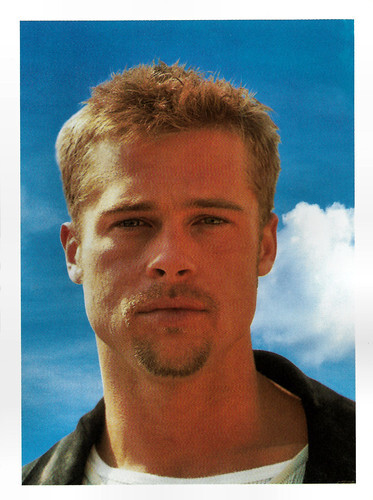
English Athena postcard by Cartel, no. E2204570.
Male chemistry
Brad Pitt was cast as an Irish Gypsy boxer with a barely intelligible accent in the British gangster film Snatch (2000), Guy Ritchie's eagerly anticipated follow-up to Lock, Stock and Two Smoking Barrels. He then played Rusty Ryan in Ocean's Eleven (Steven Soderbergh, 2001) with George Clooney . It was a remake of the Rat Pack classic about a group of criminals who plot to rob a string of casinos. Well-received by critics, Ocean's Eleven was highly successful at the box office, earning $450 million worldwide. The heist film had two sequels, Ocean's Twelve (Steven Soderbergh, 2004) and Ocean's Thirteen (Steven Soderbergh, 2007). Ocean's Twelve earned $362 million worldwide, and the third sequel earned $311 million at the international box office. CNN 's Paul Clinton: "Plus, Clooney and Pitt have the best male chemistry since Paul Newman and Robert Redford ."
Another commercial success was Troy (Wolfgang Petersen, 2004), based on 'The Iliad' by Homer. For his part as Achilles, Pitt spent six months sword training and it helped establish his appeal as an action star. Troy was the first film produced by Plan B Entertainment, a film production company he had founded two years earlier with Jennifer Aniston and Brad Grey, CEO of Paramount Pictures.
Pitt then had a hit with the stylish action-comedy Mr. & Mrs. Smith (Doug Liman, 2005), opposite Angelina Jolie . Mr. & Mrs. Smith earned $478 million worldwide, making it one of the biggest hits of 2005. Pitt starred opposite Cate Blanchett in Alejandro González Iñárritu's multi-narrative drama Babel (2006). His performance was critically well-received. Babel received seven Academy and Golden Globe award nominations, winning the Best Drama Golden Globe, and earning a nomination for the Best Supporting Actor Golden Globe.
Pitt then appeared in the black comedy Burn After Reading (Joel and Ethan Coen, 2008), his first collaboration with the Coen brothers. The film and Pitt's supporting role received a positive reception from critics. Andrew Pulver at The Guardian: "Clocking in at a crisp 95 minutes, Burn After Reading is a tightly wound, slickly plotted spy comedy (...) Pitt, in fact, gets the best of the funny stuff, but has by some way the least screen time of all the principal cast." The actor received his second Academy Award nomination for his leading performances in The Curious Case of Benjamin Button (David Fincher, 2008). Pitt played the title character, who is born as a 70-year-old man and ages in reverse. The Curious Case of Benjamin Button received thirteen Academy Award nominations in total and grossed $329 million at the box office worldwide.
Pitt's next leading role came in the blistering war film Inglourious Basterds (Quentin Tarantino, 2009) which premiered at the Cannes Film Festival. Pitt played Lieutenant Aldo Raine, an American resistance fighter battling Nazis in German-occupied France. The film was a box office hit, taking $311 million worldwide, and garnered generally favourable reviews. Perry Seibert at AllMovie (now defunct): "Tarantino has always cast his films to perfection, and the performers here know how to get the most out of the ornate language. Brad Pitt uses a hilarious Southern drawl, and his attempts at speaking Italian are a comic highlight."
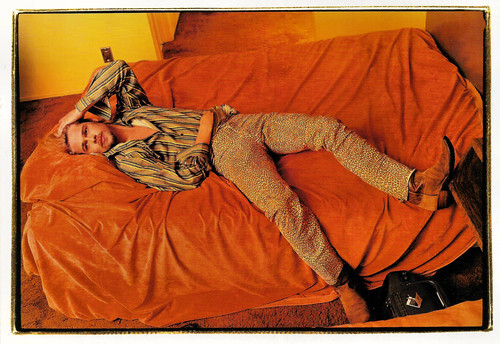
American postcard by Fotofolio, no. Z 1134. Photo: Annie Leibovitz. Caption: Brad Pitt, Las Vegas, 1994.
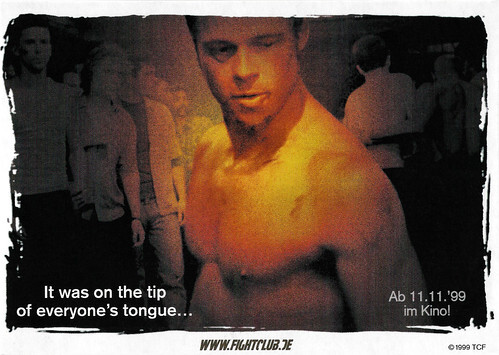
German postcard by Edgar Movie Card. Photo: TCF, 1999. Brad Pitt in Fightclub (David Fincher, 1999). Caption: It was on the Tip of Everyone's tongue.
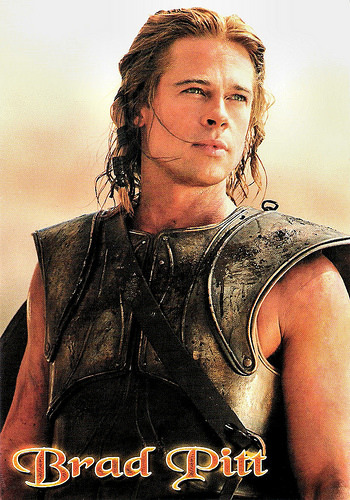
Italian postcard by EdiBas S.r.l., Torino, no. Pc 1.338. Photo: Grazia Neri. Publicity still for Troy (Wolfgang Petersen, 2004).
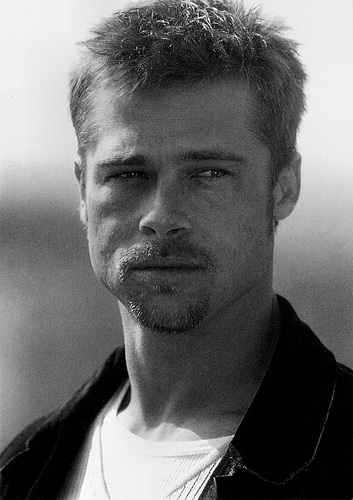
British postcard by Heroes Publishing Ltd, London, no. SPC 2742.
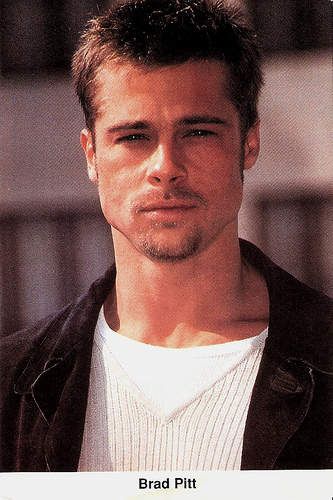
British postcard by A Bigger Splash, Manchester, no. X743, 1997.
Brangelina
Brad Pitt had another commercial success with World War Z (Marc Forster, 2013), a thriller about a zombie apocalypse. Pitt produced the film which grossed $540 million against a production budget of $190 million. He also produced The Departed (Martin Scorsese, 2006) and 12 Years a Slave (Steve McQueen, 2013), both of which won the Academy Award for Best Picture. Another success as a producer and as an actor was The Tree of Life (Terrence Malick, 2009), based on the autobiography of Solomon Northup. In this experimental drama, he gave one of the best performances of his career, playing a disciplinarian father. At AllMovie , Rebecca Flint Marx describes The Tree of Life as "a sprawling, cerebral phantasmagoria on the meaning of life and death". The film became one of the critical sensations of the year."
Pitt's list of successes seems endless. His productions Moneyball (Bennett Miller, 2011) and the comedy-drama The Big Short (Adam McKay, 2015), garnered Best Picture nominations too. Moneyball received six Academy Award nominations including Best Actor for Pitt. Besides this Oscar nomination, his role as Billy Beane in Moneyball also earned him Best Actor nominations from the BAFTA, the Broadcast Film Association, and the Golden Globes, and won him the New York Film Critics Circle award (the award was also for his role in Tree of Life). Not only his work, but his personal life is also the subject of wide publicity. In the late 1980s and early 1990s, Pitt was involved in successive relationships with several of his co-stars, including Robin Givens, Jill Schoelen and Juliette Lewis. In addition, Pitt had a much-publicised romance and engagement with his Se7en co-star Gwyneth Paltrow, whom he dated from 1994 to 1997.
From 2000 to 2005, he was married to actress Jennifer Aniston. During their divorce, he fell in love with actress Angelina Jolie on the set of Mr. & Mrs. Smith. The entertainment media dubbed the couple 'Brangelina' and they married in 2014. They have six children together, three of whom were adopted internationally. In 2015, Pitt starred opposite Jolie, in her third directorial effort, By the Sea, a romantic drama about a marriage in crisis, based on her screenplay. In September 2016, Angelina Jolie filed in real life for divorce from Pitt.
Pitt starred in the the World War II romantic thriller Allied (Robert Zemeckis, 2016) in which he and Marion Cotillard play an intelligence officer and resistance fighter, respectively, who fall in love during a mission to kill a German official. In 2017 Brad Pitt appeared with Tilda Swinton in War Machine (David Michôd, 2017), a satire of America's war with Afghanistan with a focus on the people running the campaign. As an executive producer, Pitt had another success with Moonlight (2016), directed by Barry Jenkins. The film about the life of a young black and gay man struggling to find his place in the world while growing up in a rough neighbourhood of Miami, was nominated for eight Academy Awards. The film won the Academy Award for Best Picture—along with Best Supporting Actor (Ali) and Best Adapted Screenplay.
In 2019, Brad Pitt starred in Quentin Tarantino 's Once Upon a Time... in Hollywood (2019) with Leonardo DiCaprio and Margot Robbie. He won the Oscar for Best Supporting Actor for his portrayal of Cliff Booth. He reunited with Margot Robbie in the Hollywood fresco Babylon (Damien Chazelle, 2023), about the transition from silent to talking films. He played Jack Conrad, the last great star of silent cinema, inspired by historical figures such as John Gilbert and Buster Keaton. This year, he reteamed with George Clooney in the comedy thriller Wolfs (Jon Watts, 2024).
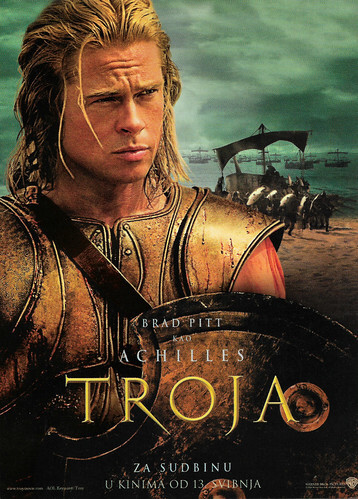
Serbian promotion card. Photo: Warner Bros. Brad Pitt as Achilles in Troy (Wolfgang Petersen, 2004).
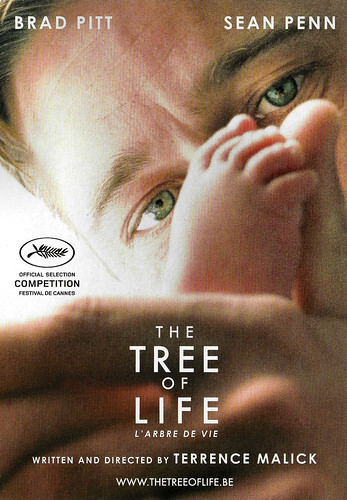
Belgian poster postcard. Brad Pitt in The Tree of Life (Terrence Malick, 2011).
Trailer 12 Monkeys (Terry Gilliam, 1995). Source: Movieclips (YouTube).
Trailer Snatch (Guy Ritchie, 2000). Source: Juliana Mendes Mendonça (YouTube).
Trailer Inglourious Basterds (Quentin Tarantino, 2009), Source: Movieclips Trailer Vault (YouTube).
Sources: Rebecca Flint Marx (AllMovie - Page now defunct), Jason Clark (AllMovie - Page now defunct), Perry Seibert (AllMovie - Page now defunct), Paul Clinton (CNN - Page now defunct), Andrew Pulver (The Guardian), Biography.com, Wikipedia, and .

Turkish freecard by See You. Photo: United International Pictures / New Line Cinema. Brad Pitt in Se7en (David Fincher, 1995).

British postcard by Heroes Publishing LTD., London, no. SPC 2617.

British postcard by Box Office, no. BO 034.

British postcard by Heroes Publishing LTD., London, no. SPC 2569.

British postcard by Music Factory, no. 069. Photo: Herb Ritts.
A wickedly sexy hitchhiker
William Bradley ‘Brad’ Pitt was born in 1963 in Shawnee, Oklahoma, and brought up in a strict Baptist household. His parents were William Alvin Pitt, who ran a trucking company, and Jane Etta (née Hillhouse), a school counsellor. He has a younger brother, Douglas (Doug) Pitt, and a younger sister, Julie Neal Pitt. Following his graduation from high school, Pitt enrolled in the University of Missouri in 1982, majoring in journalism. Two weeks before earning his degree, he left the university and moved to Los Angeles, where he took acting lessons and worked odd jobs. Reportedly he chauffeured strippers to private parties, waited tables, and wore a giant chicken suit for a local restaurant chain. Pitt's acting career began with uncredited parts in such films as Less Than Zero (Marek Kanievska, 1987).
His television debut came in May 1987 with a two-episode role on the soap opera Another World. In November of the same year, Pitt had a guest appearance on the sitcom Growing Pains. He appeared in four episodes of the legendary prime-time soap opera Dallas (1987-1988). In 1989 he made his film debut with a featured role in the slasher Cutting Class (Rospo Pallenberg, 1989) with Donovan Leitch. Pitt first gained recognition as a wickedly sexy hitchhiker in the road movie Thelma & Louise (Ridley Scott, 1991), who seduces Thelma (Geena Davis) and robs her blind. Biography.com : “Pitt's combination of charming bad boy charisma and sensual playfulness — particularly in a fiery love scene with Geena Davis— made him a genuine sex symbol (and wore out the rewind button on many a VCR).“
His first leading roles in big-budget productions came with the dramas A River Runs Through It (Robert Redford, 1992) and Legends of the Fall (Edward Zwick, 1994), for which Pitt received his first Golden Globe Award nomination, in the Best Actor category. Both films gave the actor a much-needed chance to prove that he had talent in addition to his handsome looks. He then starred opposite Tom Cruise and Antonio Banderas as the brooding, gothic vampire Louis de Pointe du Lac in the romantic horror film Interview with the Vampire (Neil Jordan, 1994), based on the novel by Anne Rice.
Pitt also garnered attention for a brief appearance in the cult hit True Romance (Tony Scott, 1993) as a stoner named Floyd, providing comic relief to the action film written by Quentin Tarantino . Pitt gave critically acclaimed performances as an emotionally tortured detective investigating a series of gruesome crimes in the Horror-thriller Se7en (David Fincher, 1995) and as visionary mental patient Jeffrey Goines in 12 Monkeys (Terry Gilliam, 1995). This latter role got him a Golden Globe Award for Best Supporting Actor and an Academy Award nomination. Se7en earned $327 million at the international box office. He also starred in the legal drama Sleepers (Barry Levinson, 1996).
Pitt then played Tyler Durden, the mysterious and anti-materialistic soap salesman in Fight Club (David Fincher, 1999) about a bloody diversion for young professional males. This unglamorous, disturbing role was an interesting but odd choice for a man voted 'Most Sexy Actor Alive' by entertainment publications, but the film became a cult. Jason Clark in his review at AllMovie (now defunct): "A definitive case of a movie that has yet to find its time, David Fincher's unnerving and cataclysmic look at the male psyche takes no prisoners and makes no apologies, which is precisely why the film is so powerful. A kind of stepchild to Stanley Kubrick's A Clockwork Orange in terms of its thematic relevancy and misunderstood nature, Fight Club looks and feels like almost nothing that has preceded it. Brad Pitt, Edward Norton, and Helena Bonham Carter all successfully subvert their onscreen personas, and give fully committed portrayals that never get buried in the film's dazzling set pieces."

British postcard by Heroes Publishing Ltd, London, no. SPC 2506. Publicity still for Thelma & Louise (Ridley Scott, 1991).

French postcard by Editions Mercuri, no. 781. Lobby Card for Brad Pitt in Cool World (Ralph Bakshi, 1992).

Vintage postcard. Photo: TriStar Pictures. Brad Pitt in Legends of the Fall (Edward Zwick, 1994).

British Exclusive Collectors' Artcard. Photo: Geffen Pictures. Publicity still for Interview with the Vampire (Neil Jordan, 1994). Caption: Louis de Pointe Du Lac (Brad Pitt) is a broken man, devastated by the loss of his beloved wife and infant daughter. Becoming a vampire is his only relief.

Vintage postcard by Memory Card, no. 168. Spanish lobby card of Brad Pitt in Seven (David Fincher, 1995).

English Athena postcard by Cartel, no. E2204570.
Male chemistry
Brad Pitt was cast as an Irish Gypsy boxer with a barely intelligible accent in the British gangster film Snatch (2000), Guy Ritchie's eagerly anticipated follow-up to Lock, Stock and Two Smoking Barrels. He then played Rusty Ryan in Ocean's Eleven (Steven Soderbergh, 2001) with George Clooney . It was a remake of the Rat Pack classic about a group of criminals who plot to rob a string of casinos. Well-received by critics, Ocean's Eleven was highly successful at the box office, earning $450 million worldwide. The heist film had two sequels, Ocean's Twelve (Steven Soderbergh, 2004) and Ocean's Thirteen (Steven Soderbergh, 2007). Ocean's Twelve earned $362 million worldwide, and the third sequel earned $311 million at the international box office. CNN 's Paul Clinton: "Plus, Clooney and Pitt have the best male chemistry since Paul Newman and Robert Redford ."
Another commercial success was Troy (Wolfgang Petersen, 2004), based on 'The Iliad' by Homer. For his part as Achilles, Pitt spent six months sword training and it helped establish his appeal as an action star. Troy was the first film produced by Plan B Entertainment, a film production company he had founded two years earlier with Jennifer Aniston and Brad Grey, CEO of Paramount Pictures.
Pitt then had a hit with the stylish action-comedy Mr. & Mrs. Smith (Doug Liman, 2005), opposite Angelina Jolie . Mr. & Mrs. Smith earned $478 million worldwide, making it one of the biggest hits of 2005. Pitt starred opposite Cate Blanchett in Alejandro González Iñárritu's multi-narrative drama Babel (2006). His performance was critically well-received. Babel received seven Academy and Golden Globe award nominations, winning the Best Drama Golden Globe, and earning a nomination for the Best Supporting Actor Golden Globe.
Pitt then appeared in the black comedy Burn After Reading (Joel and Ethan Coen, 2008), his first collaboration with the Coen brothers. The film and Pitt's supporting role received a positive reception from critics. Andrew Pulver at The Guardian: "Clocking in at a crisp 95 minutes, Burn After Reading is a tightly wound, slickly plotted spy comedy (...) Pitt, in fact, gets the best of the funny stuff, but has by some way the least screen time of all the principal cast." The actor received his second Academy Award nomination for his leading performances in The Curious Case of Benjamin Button (David Fincher, 2008). Pitt played the title character, who is born as a 70-year-old man and ages in reverse. The Curious Case of Benjamin Button received thirteen Academy Award nominations in total and grossed $329 million at the box office worldwide.
Pitt's next leading role came in the blistering war film Inglourious Basterds (Quentin Tarantino, 2009) which premiered at the Cannes Film Festival. Pitt played Lieutenant Aldo Raine, an American resistance fighter battling Nazis in German-occupied France. The film was a box office hit, taking $311 million worldwide, and garnered generally favourable reviews. Perry Seibert at AllMovie (now defunct): "Tarantino has always cast his films to perfection, and the performers here know how to get the most out of the ornate language. Brad Pitt uses a hilarious Southern drawl, and his attempts at speaking Italian are a comic highlight."

American postcard by Fotofolio, no. Z 1134. Photo: Annie Leibovitz. Caption: Brad Pitt, Las Vegas, 1994.

German postcard by Edgar Movie Card. Photo: TCF, 1999. Brad Pitt in Fightclub (David Fincher, 1999). Caption: It was on the Tip of Everyone's tongue.

Italian postcard by EdiBas S.r.l., Torino, no. Pc 1.338. Photo: Grazia Neri. Publicity still for Troy (Wolfgang Petersen, 2004).

British postcard by Heroes Publishing Ltd, London, no. SPC 2742.

British postcard by A Bigger Splash, Manchester, no. X743, 1997.
Brangelina
Brad Pitt had another commercial success with World War Z (Marc Forster, 2013), a thriller about a zombie apocalypse. Pitt produced the film which grossed $540 million against a production budget of $190 million. He also produced The Departed (Martin Scorsese, 2006) and 12 Years a Slave (Steve McQueen, 2013), both of which won the Academy Award for Best Picture. Another success as a producer and as an actor was The Tree of Life (Terrence Malick, 2009), based on the autobiography of Solomon Northup. In this experimental drama, he gave one of the best performances of his career, playing a disciplinarian father. At AllMovie , Rebecca Flint Marx describes The Tree of Life as "a sprawling, cerebral phantasmagoria on the meaning of life and death". The film became one of the critical sensations of the year."
Pitt's list of successes seems endless. His productions Moneyball (Bennett Miller, 2011) and the comedy-drama The Big Short (Adam McKay, 2015), garnered Best Picture nominations too. Moneyball received six Academy Award nominations including Best Actor for Pitt. Besides this Oscar nomination, his role as Billy Beane in Moneyball also earned him Best Actor nominations from the BAFTA, the Broadcast Film Association, and the Golden Globes, and won him the New York Film Critics Circle award (the award was also for his role in Tree of Life). Not only his work, but his personal life is also the subject of wide publicity. In the late 1980s and early 1990s, Pitt was involved in successive relationships with several of his co-stars, including Robin Givens, Jill Schoelen and Juliette Lewis. In addition, Pitt had a much-publicised romance and engagement with his Se7en co-star Gwyneth Paltrow, whom he dated from 1994 to 1997.
From 2000 to 2005, he was married to actress Jennifer Aniston. During their divorce, he fell in love with actress Angelina Jolie on the set of Mr. & Mrs. Smith. The entertainment media dubbed the couple 'Brangelina' and they married in 2014. They have six children together, three of whom were adopted internationally. In 2015, Pitt starred opposite Jolie, in her third directorial effort, By the Sea, a romantic drama about a marriage in crisis, based on her screenplay. In September 2016, Angelina Jolie filed in real life for divorce from Pitt.
Pitt starred in the the World War II romantic thriller Allied (Robert Zemeckis, 2016) in which he and Marion Cotillard play an intelligence officer and resistance fighter, respectively, who fall in love during a mission to kill a German official. In 2017 Brad Pitt appeared with Tilda Swinton in War Machine (David Michôd, 2017), a satire of America's war with Afghanistan with a focus on the people running the campaign. As an executive producer, Pitt had another success with Moonlight (2016), directed by Barry Jenkins. The film about the life of a young black and gay man struggling to find his place in the world while growing up in a rough neighbourhood of Miami, was nominated for eight Academy Awards. The film won the Academy Award for Best Picture—along with Best Supporting Actor (Ali) and Best Adapted Screenplay.
In 2019, Brad Pitt starred in Quentin Tarantino 's Once Upon a Time... in Hollywood (2019) with Leonardo DiCaprio and Margot Robbie. He won the Oscar for Best Supporting Actor for his portrayal of Cliff Booth. He reunited with Margot Robbie in the Hollywood fresco Babylon (Damien Chazelle, 2023), about the transition from silent to talking films. He played Jack Conrad, the last great star of silent cinema, inspired by historical figures such as John Gilbert and Buster Keaton. This year, he reteamed with George Clooney in the comedy thriller Wolfs (Jon Watts, 2024).

Serbian promotion card. Photo: Warner Bros. Brad Pitt as Achilles in Troy (Wolfgang Petersen, 2004).

Belgian poster postcard. Brad Pitt in The Tree of Life (Terrence Malick, 2011).
Trailer 12 Monkeys (Terry Gilliam, 1995). Source: Movieclips (YouTube).
Trailer Snatch (Guy Ritchie, 2000). Source: Juliana Mendes Mendonça (YouTube).
Trailer Inglourious Basterds (Quentin Tarantino, 2009), Source: Movieclips Trailer Vault (YouTube).
Sources: Rebecca Flint Marx (AllMovie - Page now defunct), Jason Clark (AllMovie - Page now defunct), Perry Seibert (AllMovie - Page now defunct), Paul Clinton (CNN - Page now defunct), Andrew Pulver (The Guardian), Biography.com, Wikipedia, and .
Published on December 09, 2024 22:00
December 8, 2024
Tortilla Flat (1942)
Tortilla Flat (1942) is an American drama film directed by Victor Fleming and starring Spencer Tracy, John Garfield and Hedy Lamarr. The screenplay is based on the 1935 novel by John Steinbeck about a group of work-shirking, wine-guzzling tramps.
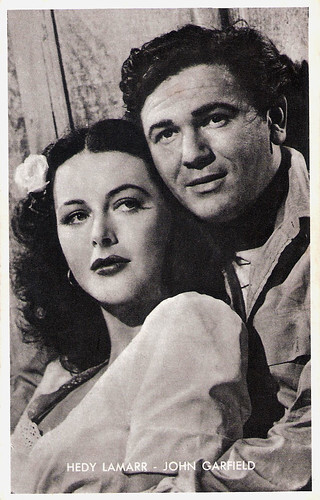
Belgian collectors card by Kwatta, Series C, no. 154 Photo: MGM. Hedy Lamarr and John Garfield in Tortilla Flat (Victor Fleming, 1942).
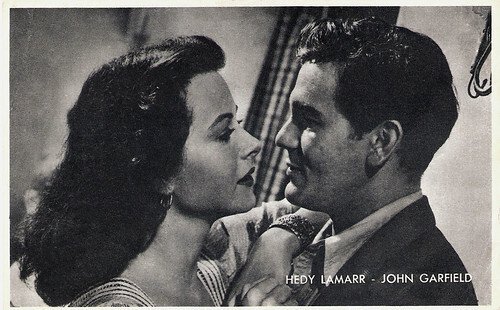
Belgian collector card by Kwatta, Series C, no. 166. Photo: MGM. Hedy Lamarr and John Garfield in Tortilla Flat (Victor Fleming, 1942).

Belgian collectors card by Kwatta, Series C, no. 174. Photo: MGM. John Garfield and Spencer Tracy in Tortilla Flat (Victor Fleming, 1942).
A little idyll filled with solid humour and compassion
Crafty Pilon ( Spencer Tracy ) lies in the sun and thinks beautiful thoughts, especially about how to take advantage, nicely, of his pals. Their biggest concern each day is how they're going to acquire wine. pilon is one of the poor but lazy paisanos, living along the coast of California. His young and magnetic sidekick Danny Alvarez ( John Garfield ) inherits from his grandfather two houses in Tortilla Flat, in the central coastal area of California, just outside the old seaport town of Monterey. So Pilon decides to take advantage of him and brings in all his friends to live in one of the houses.
One of the friends, the Pirate (Frank Morgan), is a paisano who goes around with a bunch of dogs. He lives like a tramp but has plenty of money hidden in the woods. He is the only one in the group who does odd jobs. The Pirate is trying to save money to buy a silver golden stick for the Statue of St. Francis in the local Catholic Church. Pilon endeavors to steal the money, until he discovers that the Pirate intends to honour St. Francis for healing his sick dog. The dog is later run over and killed.
When the house of the paisanos burns down, Danny offers his friends to move into the other house with him. In gratitude, Pilon tries to make life better for his friend. Things are fine at first until Danny meets a pretty girl named Dolores ( Hedy Lamarr ). Then Danny begins to grow less irresponsible, to the horrified disgust of Pilon. Danny actually goes to work in a fishing business.
A misunderstanding caused by Pilon about a vacuum cleaner that Danny had bought for the girl enrages Danny. He becomes drunk and a bit crazy. He almost dies in an accident while interrupting the girl at her work in a cannery, but through Pilon's prayers, he is restored to health. Danny marries his sweetheart, with the promise that he will become a fisherman, now that Pilon has raised the money to buy a boat.
The film's happy ending is different from the novel's ending, in which Danny dies after a fall. Film critic Bosley Crowther of The New York Times gave the film a positive review, writing that the film "is really a little idyll which turns its back on a workaday world...it is filled with solid humour and compassion — and that is pleasant, even for folks who have to work". Frank Morgan received an Academy Award nomination for Best Supporting Actor for his poignant portrayal of The Pirate.
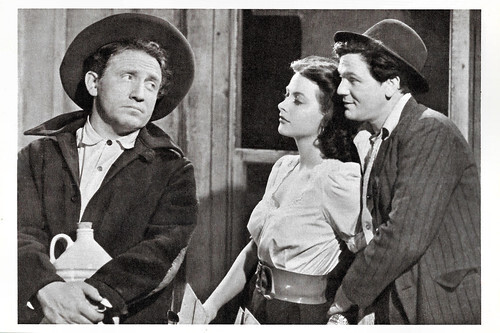
French postcard by Editions La Malibran, Saint-Dié, no. CA 22. Photo: M.G.M. Spencer Tracy , Hedy Lamarr and John Garfield in Tortilla Flat (Victor Fleming, 1942).

Spanish postcard, no. 4072. Photo: M.G.M. Hedy Lamarr and John Garfield in Tortilla Flat (Victor Fleming, 1942). The Spanish title is La vida es asi.
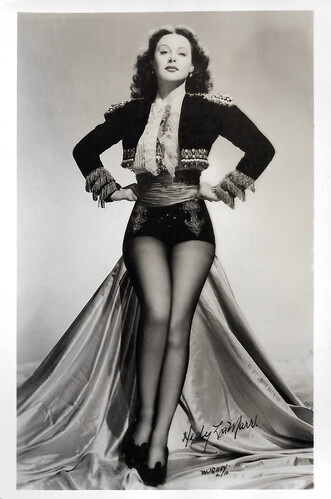
American postcard by EKC. Photo: W.T. Gray, Los Angeles. Hedy Lamarr .
Sources: Bosley Crowther (The New York Times), Wikipedia (Dutch, German and English) and IMDb.

Belgian collectors card by Kwatta, Series C, no. 154 Photo: MGM. Hedy Lamarr and John Garfield in Tortilla Flat (Victor Fleming, 1942).

Belgian collector card by Kwatta, Series C, no. 166. Photo: MGM. Hedy Lamarr and John Garfield in Tortilla Flat (Victor Fleming, 1942).

Belgian collectors card by Kwatta, Series C, no. 174. Photo: MGM. John Garfield and Spencer Tracy in Tortilla Flat (Victor Fleming, 1942).
A little idyll filled with solid humour and compassion
Crafty Pilon ( Spencer Tracy ) lies in the sun and thinks beautiful thoughts, especially about how to take advantage, nicely, of his pals. Their biggest concern each day is how they're going to acquire wine. pilon is one of the poor but lazy paisanos, living along the coast of California. His young and magnetic sidekick Danny Alvarez ( John Garfield ) inherits from his grandfather two houses in Tortilla Flat, in the central coastal area of California, just outside the old seaport town of Monterey. So Pilon decides to take advantage of him and brings in all his friends to live in one of the houses.
One of the friends, the Pirate (Frank Morgan), is a paisano who goes around with a bunch of dogs. He lives like a tramp but has plenty of money hidden in the woods. He is the only one in the group who does odd jobs. The Pirate is trying to save money to buy a silver golden stick for the Statue of St. Francis in the local Catholic Church. Pilon endeavors to steal the money, until he discovers that the Pirate intends to honour St. Francis for healing his sick dog. The dog is later run over and killed.
When the house of the paisanos burns down, Danny offers his friends to move into the other house with him. In gratitude, Pilon tries to make life better for his friend. Things are fine at first until Danny meets a pretty girl named Dolores ( Hedy Lamarr ). Then Danny begins to grow less irresponsible, to the horrified disgust of Pilon. Danny actually goes to work in a fishing business.
A misunderstanding caused by Pilon about a vacuum cleaner that Danny had bought for the girl enrages Danny. He becomes drunk and a bit crazy. He almost dies in an accident while interrupting the girl at her work in a cannery, but through Pilon's prayers, he is restored to health. Danny marries his sweetheart, with the promise that he will become a fisherman, now that Pilon has raised the money to buy a boat.
The film's happy ending is different from the novel's ending, in which Danny dies after a fall. Film critic Bosley Crowther of The New York Times gave the film a positive review, writing that the film "is really a little idyll which turns its back on a workaday world...it is filled with solid humour and compassion — and that is pleasant, even for folks who have to work". Frank Morgan received an Academy Award nomination for Best Supporting Actor for his poignant portrayal of The Pirate.

French postcard by Editions La Malibran, Saint-Dié, no. CA 22. Photo: M.G.M. Spencer Tracy , Hedy Lamarr and John Garfield in Tortilla Flat (Victor Fleming, 1942).

Spanish postcard, no. 4072. Photo: M.G.M. Hedy Lamarr and John Garfield in Tortilla Flat (Victor Fleming, 1942). The Spanish title is La vida es asi.

American postcard by EKC. Photo: W.T. Gray, Los Angeles. Hedy Lamarr .
Sources: Bosley Crowther (The New York Times), Wikipedia (Dutch, German and English) and IMDb.
Published on December 08, 2024 22:00
December 7, 2024
Christel Bodenstein (1936-2024)
On 5 December 2024, German film and television actress Christel Bodenstein (1938-2024) passed away. She appeared in many East German (GDR) productions and is best known for her leading role as the beautiful but haughty princess in the fairytale film Das singende, klingende Bäumchen / The Singing Ringing Tree (1957). She was 86.
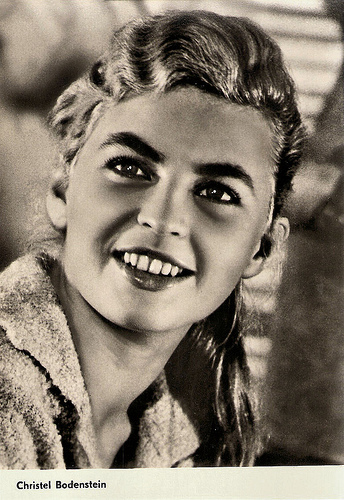
East German postcard by VEB Progress Film-Vertrieb, no. 1582, 1961.
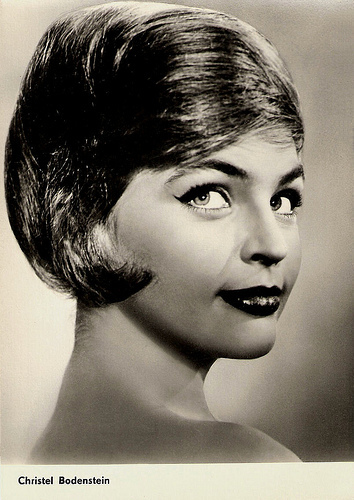
East German postcard by VEB Progress Film-Vertrieb, no. 1893, 1963. Photo: DEFA / Blümel.
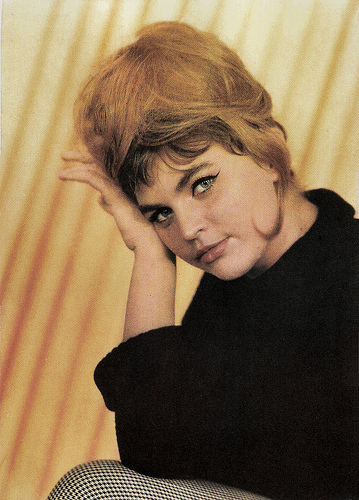
East German postcard by VEB Progress Film-Vertrieb, no. 2250, 1965. Photo: DEWAG / Herbst / Mücke.
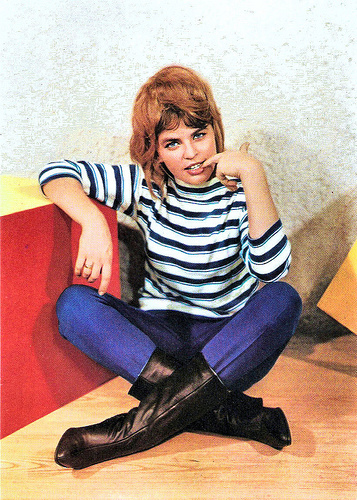
East German postcard by VEB Progress Film-Vertrieb, no. 2252, 1965. Photo: DEWAG / Herbst / Mücke.

East German postcard by VEB Progress Film-Vertrieb, Berlin, no. 3106, 1968. Photo: Balinski.
The singing ringing tree
Christel Bodenstein was born Christa Bodenstein in 1938 in Munich, Germany. In 1949, she moved to Leipzig in the GDR with her mother. She attended the ballet school of the Leipzig Opera and the State Ballet School, Berlin. In 1955, she graduated there and became a ballet dancer at the Landestheater Halle.
The then 17-year-old met DEFA director Kurt Maetzig at the Ostseestrand. He suggested her to do a screen test for the part of Annegret in his DEFA film Schlösser und Katen/Castles and Cottages (1957), but she did not get the role. Instead, actress Karla Runkehl was chosen to play Annegret.
Despite this failure, Bodenstein studied until 1959 at the Academy of Film and Television in Potsdam. She made her film debut as student Hannelore Ulrich in the satire Das Hauptmann von Köln/The Captain from Cologne (Slatan Dudow, 1956) starring Rolf Ludwig, followed by the fairy-tale film Das tapfere Schneiderlein/The Brave Little Tailor (Helmut Spieß, 1956) with Kurt Schmidtchen. The film was the first of 19 adaptations of Grimm fairy tales, which the East German studio DEFA realised until 1990.
Bodenstein’s breakthrough was another fairy-tale film by the DEFA, Das singende, klingende Bäumchen/The Singing Ringing Tree (Francesco Stefani, 1957). The story, written by Anne Geelhaar, was based on a variation of Hurleburlebutz by the Grimm Brothers. Bodenstein played a beautiful but selfish and haughty princess who rejects the proposal of a wealthy prince (Eckart Dux). After its release in East Germany, the film sold almost 6 million tickets in the country of about 17 million. Das singende, klingende Bäumchen was then purchased by the BBC and cut into three parts to create a mini-series which was shown many times during the 1960s and 1970s.
Other popular successes were the DEFA musical Maibowle/The Punch Bowl (Günter Reisch, 1959) and its sequel Silvesterpunsch/New Year's Eve Punch (Günter Reisch, 1960), in which she co-starred with Erich Franz, Friedel Nowack and Erika Dunkelmann. In these films, she could show off her dancing talent.

East-German postcard by VEB DEFA-Studio für Spielfilme, Potsdam-Babelsberg, no. 72, 1956. Photo: DEFA / Wenzel.
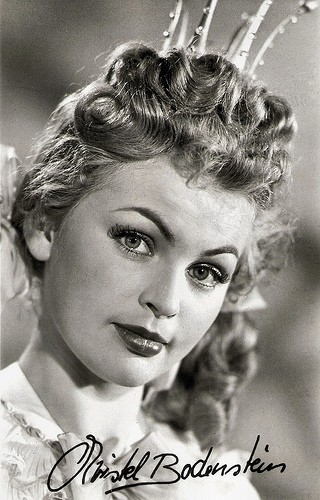
East German postcard by VEB Progress Film-Vertrieb, no. 4213/447, 1957. Photo: DEFA / Wunsch. Publicity still for Das singende, klingende Bäumchen/The Singing Ringing Tree (Francesco Stefani, 1957).
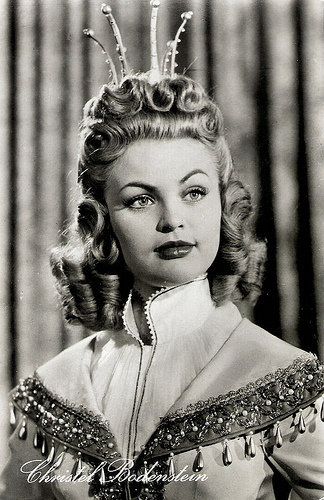
East German postcard by VEB Progress Film-Vertrieb, no. 4219/463, 1958. Photo: DEFA / Wunsch. Publicity still for Das singende, klingende Bäumchen/The Singing Ringing Tree (Francesco Stefani, 1957).
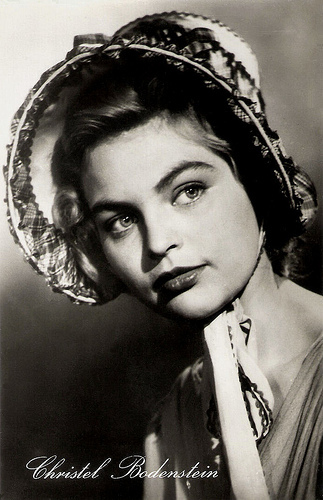
East German postcard by VEB Progress Film-Vertrieb, no. 659, 1958. Photo: Jochen Diestelmann.
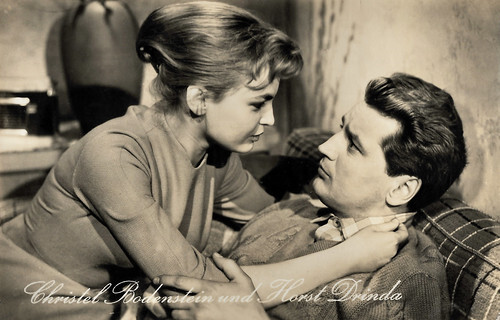
East German postcard by VEB Progress Film-Vertrieb, no. 69/910. Photo: Meister / DEFA. Christel Bodenstein and Horst Drinda in Klotz am Bein / Block on the leg (Frank Vogel, 1958)
.
One of the great romantic couples of the GDR
In 1960, Christel Bodenstein was voted the most popular actress of the GDR by the youth magazine Neues Leben. Through her popularity, she became a member of the DEFA ensemble from 1959 to 1973 and she worked with renowned film directors such as Frank Vogel, Herbert Ballmann and Martin Hellberg.
Bodenstein married director Konrad Wolf in 1960 and they had a son Mirko in 1961. In the 1960s, she appeared in some musicals and revue films such as Revue um Mitternacht/Midnight Review (Gottfried Kolditz, 1962) alongside Manfred Krug . Bodenstein and Krug reunited in Beschreibung eines Sommers/Description of a summer (Ralf Kirsten, 1963). The film made them one of the great romantic couples of the GDR. This was followed by the fairy-tale film Der kleine Prinz/The Little Prince (Konrad Wolf, 1966) based on the story by Antoine de Saint-Exupéry. Bodenstein played the prince and Eberhard Esche the pilot.
In the 1970s, good and interesting film roles for the DEFA and the television of the GDR failed to materialise. She decided to return to the stage. From 1973 to 1976 she performed as a chanson singer and was a temporary guest actress at the Maxim Gorki Theater in Berlin and the Hans Otto Theater in Potsdam.
In 1976, she started to work for the small theatre Das Ei at the Friedrichstadt-Palast in Berlin. After the Wende, the German reunification of 1990, she worked as an assistant director and in 1994 she became a director at Berlin’s Friedrichstadtpalast. Since then, her productions included a Claire Waldorff revue and the revue 'Sommernachtsträume' (Summer Night Dreams) (1995).
Bodenstein and Wolf divorced in 1978. Her second marriage was to the actor and playwright Hasso von Lenski. In 2016, Christel Bodenstein returned to the screen in a new TV version of Das singende, klingende Bäumchen/The Singing Ringing Tree (Wolfgang Eißler, 2016), now with Jytte-Merle Böhrnsen as the princess and with Bodenstein in a supporting part as a herbalist. A portrait of the actress in her role as the princess in the original film was used as a prop during the scenes in the castle. The 2017 edition of the MDR documentary ‘Lebensläufe’ (CVs) about her and the artist's photo book from 2006, in which she presents sculptural images and figures, was given the title ‘Einmal Prinzessin, immer Prinzessin’ (Once a Princess, Always a Princess), clearly describing her importance to German film. The popular actress died on 5 December 2024 at the age of 86.
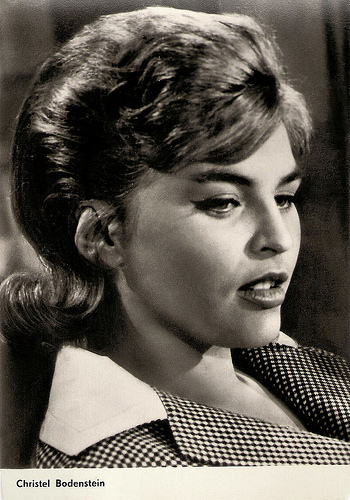
East-German postcard by VEB Progress Film-Vertrieb, no. 1658, 1962.
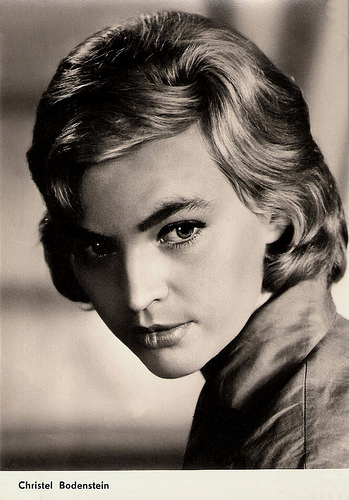
East-German postcard by VEB Progress Film-Vertrieb, no. 1817, 1963. Photo: Karin Blasig.
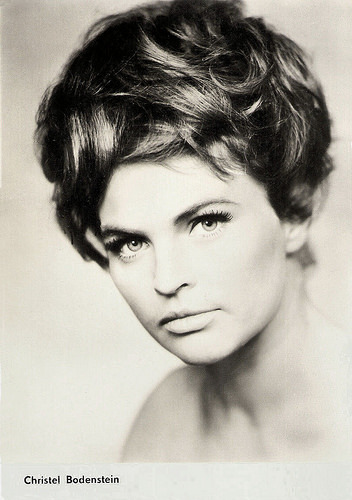
East-German postcard by VEB Progress Film-Vertrieb, no. 2333, 1966. Photo: Karin Blasig.
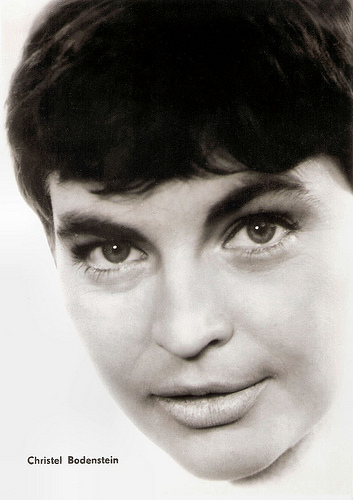
East-German postcard by VEB Progress Film-Vertrieb, no. 3312, 1968. Photo: Karin Blasig.
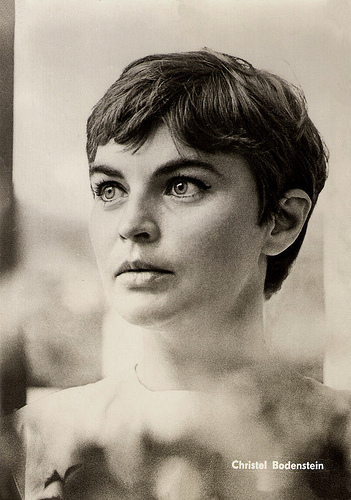
East-German postcard by VEB Progress Film-Vertrieb, no. 55/69, 1969. Photo: Klaus D. Schwarz.
Sources: Ines Walk (Film-Zeit.de – now defunct), Filmportal.de, Wikipedia (English and German), and .

East German postcard by VEB Progress Film-Vertrieb, no. 1582, 1961.

East German postcard by VEB Progress Film-Vertrieb, no. 1893, 1963. Photo: DEFA / Blümel.

East German postcard by VEB Progress Film-Vertrieb, no. 2250, 1965. Photo: DEWAG / Herbst / Mücke.

East German postcard by VEB Progress Film-Vertrieb, no. 2252, 1965. Photo: DEWAG / Herbst / Mücke.

East German postcard by VEB Progress Film-Vertrieb, Berlin, no. 3106, 1968. Photo: Balinski.
The singing ringing tree
Christel Bodenstein was born Christa Bodenstein in 1938 in Munich, Germany. In 1949, she moved to Leipzig in the GDR with her mother. She attended the ballet school of the Leipzig Opera and the State Ballet School, Berlin. In 1955, she graduated there and became a ballet dancer at the Landestheater Halle.
The then 17-year-old met DEFA director Kurt Maetzig at the Ostseestrand. He suggested her to do a screen test for the part of Annegret in his DEFA film Schlösser und Katen/Castles and Cottages (1957), but she did not get the role. Instead, actress Karla Runkehl was chosen to play Annegret.
Despite this failure, Bodenstein studied until 1959 at the Academy of Film and Television in Potsdam. She made her film debut as student Hannelore Ulrich in the satire Das Hauptmann von Köln/The Captain from Cologne (Slatan Dudow, 1956) starring Rolf Ludwig, followed by the fairy-tale film Das tapfere Schneiderlein/The Brave Little Tailor (Helmut Spieß, 1956) with Kurt Schmidtchen. The film was the first of 19 adaptations of Grimm fairy tales, which the East German studio DEFA realised until 1990.
Bodenstein’s breakthrough was another fairy-tale film by the DEFA, Das singende, klingende Bäumchen/The Singing Ringing Tree (Francesco Stefani, 1957). The story, written by Anne Geelhaar, was based on a variation of Hurleburlebutz by the Grimm Brothers. Bodenstein played a beautiful but selfish and haughty princess who rejects the proposal of a wealthy prince (Eckart Dux). After its release in East Germany, the film sold almost 6 million tickets in the country of about 17 million. Das singende, klingende Bäumchen was then purchased by the BBC and cut into three parts to create a mini-series which was shown many times during the 1960s and 1970s.
Other popular successes were the DEFA musical Maibowle/The Punch Bowl (Günter Reisch, 1959) and its sequel Silvesterpunsch/New Year's Eve Punch (Günter Reisch, 1960), in which she co-starred with Erich Franz, Friedel Nowack and Erika Dunkelmann. In these films, she could show off her dancing talent.

East-German postcard by VEB DEFA-Studio für Spielfilme, Potsdam-Babelsberg, no. 72, 1956. Photo: DEFA / Wenzel.

East German postcard by VEB Progress Film-Vertrieb, no. 4213/447, 1957. Photo: DEFA / Wunsch. Publicity still for Das singende, klingende Bäumchen/The Singing Ringing Tree (Francesco Stefani, 1957).

East German postcard by VEB Progress Film-Vertrieb, no. 4219/463, 1958. Photo: DEFA / Wunsch. Publicity still for Das singende, klingende Bäumchen/The Singing Ringing Tree (Francesco Stefani, 1957).

East German postcard by VEB Progress Film-Vertrieb, no. 659, 1958. Photo: Jochen Diestelmann.

East German postcard by VEB Progress Film-Vertrieb, no. 69/910. Photo: Meister / DEFA. Christel Bodenstein and Horst Drinda in Klotz am Bein / Block on the leg (Frank Vogel, 1958)
.
One of the great romantic couples of the GDR
In 1960, Christel Bodenstein was voted the most popular actress of the GDR by the youth magazine Neues Leben. Through her popularity, she became a member of the DEFA ensemble from 1959 to 1973 and she worked with renowned film directors such as Frank Vogel, Herbert Ballmann and Martin Hellberg.
Bodenstein married director Konrad Wolf in 1960 and they had a son Mirko in 1961. In the 1960s, she appeared in some musicals and revue films such as Revue um Mitternacht/Midnight Review (Gottfried Kolditz, 1962) alongside Manfred Krug . Bodenstein and Krug reunited in Beschreibung eines Sommers/Description of a summer (Ralf Kirsten, 1963). The film made them one of the great romantic couples of the GDR. This was followed by the fairy-tale film Der kleine Prinz/The Little Prince (Konrad Wolf, 1966) based on the story by Antoine de Saint-Exupéry. Bodenstein played the prince and Eberhard Esche the pilot.
In the 1970s, good and interesting film roles for the DEFA and the television of the GDR failed to materialise. She decided to return to the stage. From 1973 to 1976 she performed as a chanson singer and was a temporary guest actress at the Maxim Gorki Theater in Berlin and the Hans Otto Theater in Potsdam.
In 1976, she started to work for the small theatre Das Ei at the Friedrichstadt-Palast in Berlin. After the Wende, the German reunification of 1990, she worked as an assistant director and in 1994 she became a director at Berlin’s Friedrichstadtpalast. Since then, her productions included a Claire Waldorff revue and the revue 'Sommernachtsträume' (Summer Night Dreams) (1995).
Bodenstein and Wolf divorced in 1978. Her second marriage was to the actor and playwright Hasso von Lenski. In 2016, Christel Bodenstein returned to the screen in a new TV version of Das singende, klingende Bäumchen/The Singing Ringing Tree (Wolfgang Eißler, 2016), now with Jytte-Merle Böhrnsen as the princess and with Bodenstein in a supporting part as a herbalist. A portrait of the actress in her role as the princess in the original film was used as a prop during the scenes in the castle. The 2017 edition of the MDR documentary ‘Lebensläufe’ (CVs) about her and the artist's photo book from 2006, in which she presents sculptural images and figures, was given the title ‘Einmal Prinzessin, immer Prinzessin’ (Once a Princess, Always a Princess), clearly describing her importance to German film. The popular actress died on 5 December 2024 at the age of 86.

East-German postcard by VEB Progress Film-Vertrieb, no. 1658, 1962.

East-German postcard by VEB Progress Film-Vertrieb, no. 1817, 1963. Photo: Karin Blasig.

East-German postcard by VEB Progress Film-Vertrieb, no. 2333, 1966. Photo: Karin Blasig.

East-German postcard by VEB Progress Film-Vertrieb, no. 3312, 1968. Photo: Karin Blasig.

East-German postcard by VEB Progress Film-Vertrieb, no. 55/69, 1969. Photo: Klaus D. Schwarz.
Sources: Ines Walk (Film-Zeit.de – now defunct), Filmportal.de, Wikipedia (English and German), and .
Published on December 07, 2024 22:00
December 6, 2024
Emil Jannings
If Weimar cinema had one film star, it would be Emil Jannings (1884-1950). He was one of the greatest actors in the silent era. In 1929, he received the first Oscar in the Best Actor category. It's too bad that during the Third Reich, he worked as a board member for the Ufa propaganda machine.
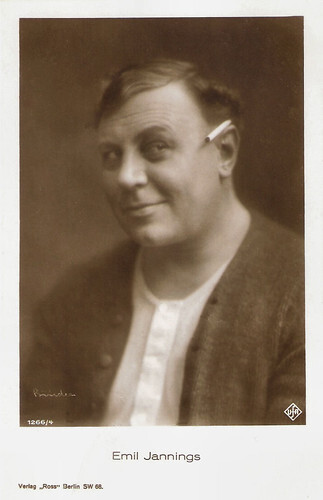
German postcard by Ross Verlag, no. 1266/4, 1927-1928. Photo: Alex Binder / Ufa. Emil Jannings in Varieté (E.A. Dupont, 1925).
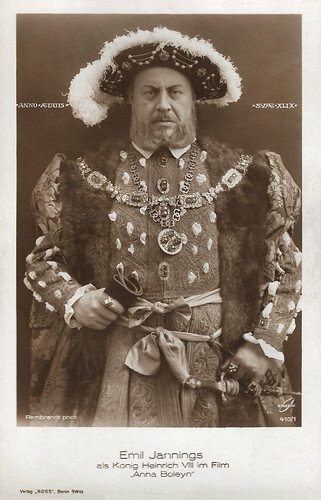
German postcard by Ross Verlag, no. 410/1. Photo: Union-Film. Emil Jannings as Henry VIII in Anna Boleyn (Ernst Lubitsch, 1920).
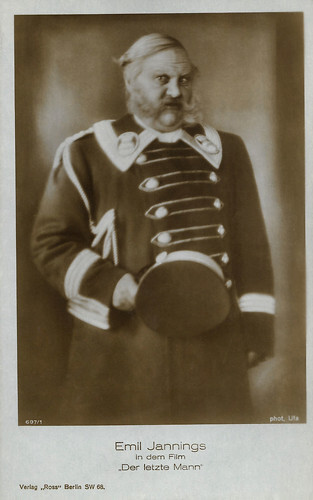
German postcard by Verlag Ross, Berlin., no. 697/1, 1919-1924. Photo: Ufa. Emil Jannings in Der letzte Mann/The Last Laugh (Friedrich Wilhelm Murnau, 1924).

German postcard by Ross Verlag, no. 698/1. Photo: Filmhaus Bruckmann. Emil Jannings as Nero in Quo vadis? (Gabriellino D'Annunzio, Georg Jacoby, 1924).
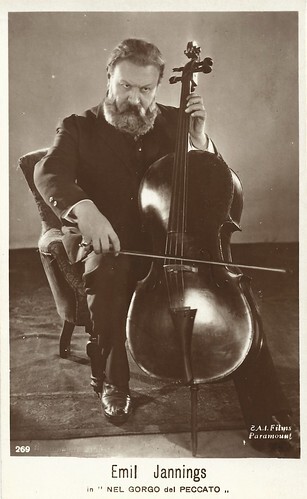
Italian postcard by G.B. Falci, Milano, no. 269. Photo: S.A.I. Films / Paramount. Emil Jannings in The Way of All Flesh (Victor Fleming, 1927). The Italian release title was Nel gorgo del peccato.
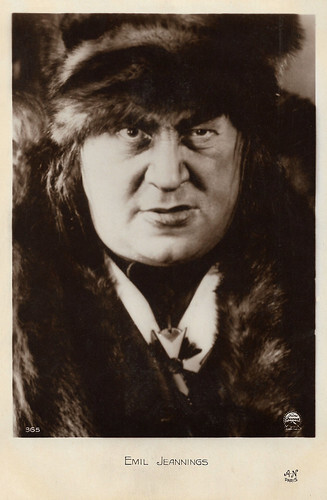
French postcard by A.N., no. 365. Photo: Paramount. Emil Jannings in The Patriot (Ernst Lubitsch, 1928).
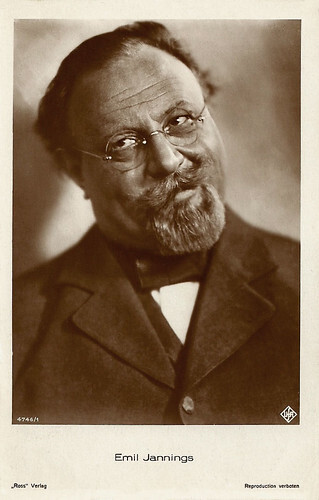
German postcard by Ross Verlag, no. 4746/1, 1929-1930. Photo: Ufa. Publicity still for Der blaue Engel/The Blue Angel (1930).
In the trenches
Emil Jannings was born Theodor Friedrich Emil Janenz in Rorschach, Switzerland, in 1884. He was the son of German-American merchant Emil Janenz and his wife Margarethe Schwabe. He grew up in Leipzig in the German Empire and further in Görlitz after the early death of his father. Emil had two brothers and a sister.
He left grammar school in the ninth grade. His mother initially forbade him from becoming an actor, so he went to sea as a ship's boy for a year. On his return to Görlitz, she allowed him to begin a traineeship in acting at the Görlitz theatre. He did not show any talent though, but Jannings did not give up. From 1901 on, he played in several provincial theatres and with travelling companies.
From 1907 to 1908, he performed in Stettin, from 1908 to 1911 in Bonn where he also directed several productions, from 1911 to 1912 in Königsberg, from 1912 to 1913 in Nuremberg (together with Werner Krauß ), and from 1913 to 1914 in Darmstadt and in Bremen. In 1914, he reached Berlin. Jannings had his first film role in the War Propaganda film Im Schützengraben/In the Trenches (Walter Schmidthässler, 1914). He did not see film work as his fulfilment. Artistically, it was not an adequate medium for his acting, as he was unable to use his versatile voice in silent films.
In 1915-1916, he was engaged at Max Reinhardt 's Deutsches Theater. At Reinhardt's theatre, he at first mainly played smaller and mid-size roles. In 1916, he directed Gustav Kaltenbach's comedy 'Familie Schimek' at Deutsches Theater. Through Reinhardt, Jannings met author Karl Gustav Vollmoeller and Ernst Lubitsch. Both were important cultural figures in Berlin society in the Golden Twenties. Berlin society photographer Frieda Riess took portraits of him.
From 1917 on, he played larger roles, for instance, the role of Wehrhahn in 'Der Biberpelz' (The Beaver Coat") by Gerhart Hauptmann, or the role of Gustav Hein in Hermann Bahr's 'Das Konzert' (The Concert). In the summer of 1918, he went to Königliches Schauspielhaus where he made his first performance in the role of the village judge Adam in Heinrich von Kleist's 'Der zerbrochene Krug' (The Broken Jug). It became his greatest stage triumph. At the end of 1918, he returned to Deutsches Theater, getting bigger and bigger roles. He left the ensemble in June 1920.
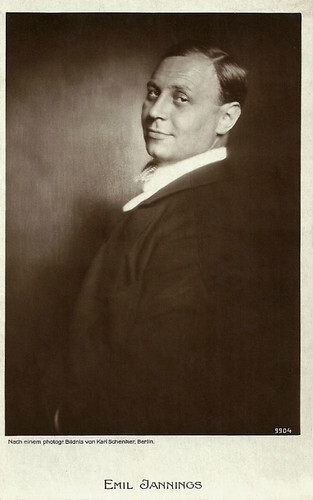
German postcard, no. 9904. Photo: Karl Schenker, Berlin.
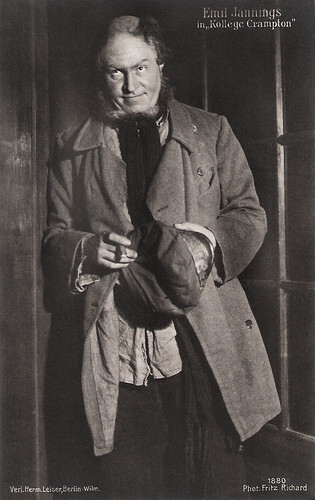
German postcard by Verlag Hermann Leiser, Berlin-Wilm., no. 1880. Photo: Fritz Richard. Emil Jannings in 'Kollege Crampton' by Gerhart Hauptmann.
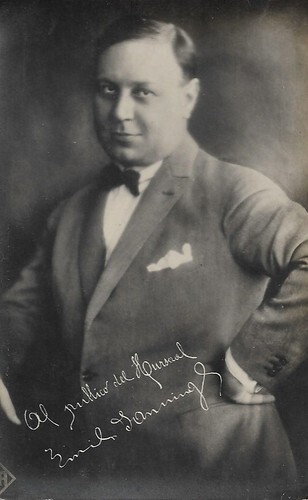
Spanish postcard. Photo: Ufa. Written dedication: "To the audience of the Kursaal." This could refer to the Kursaal in Barcelona or the Kursaal in Madrid.
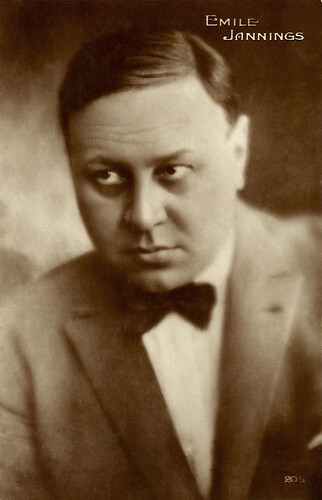
French postcard by Editions Cinémagazine, no. 205.
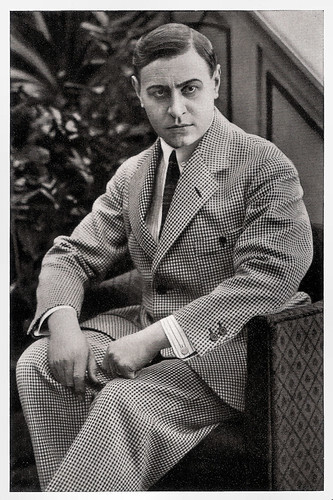
German collectors card by Ross Verlag in the series Vom Werden Deutscher Filmkunst - Der Stumme Film, picture, no, 29, Group 43. Photo: publicity still for Arme Eva (Robert Wiene, 1914). Caption: Emil Jannings, jung und schön, in seinem ersten Film, Fromont junior, Risler senior. (Emil Jannings, young and handsome, in his first film Fromont junior, Risler senior. According to other sources, Arme Eva (Robert Wiene, 1914) was his first film.
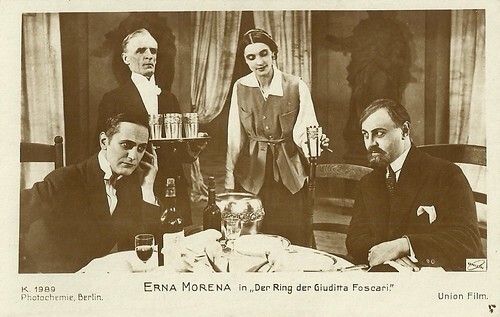
German postcard by Photochemie, Berlin, no. K. 1989. Photo: Union Film. Erna Morena , Emil Jannings and Harry Liedtke in Der Ring der Giuditta Foscari (Alfred Halm, 1917).
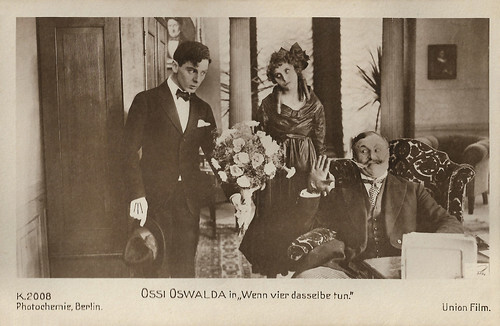
German postcard by Photochemie, Berlin, no. K. 2008. Photo: Union-Film. Ossi Oswalda in the German silent comedy Wenn vier dasselbe tun (Ernst Lubitsch, 1917), starring Ossi Oswalda as the girl, Fritz Schulz (here on the left) as her lover, and Emil Jannings as her father (here on the right).
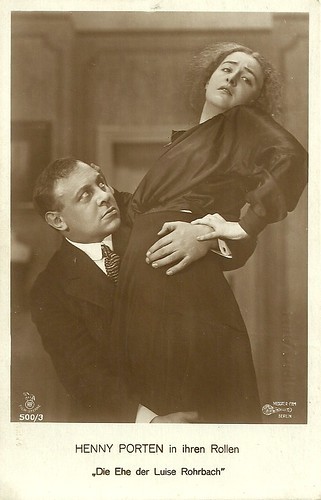
German postcard by Rotophot in the Film-Sterne series, no. 500/3. Photo: Messter Film, Berlin. Henny Porten and Emil Jannings in Die Ehe der Luise Rohrbach/The Marriage of Luise Rohrbach (Rudolf Biebrach 1917), based on a novel by Emmi Elert.
Ernst Lubitsch
From 1916 on, Emil Jannings played more and more in film, mostly in quickly staged melodramas and crime stories. From 1916 on, Jannings regularly appeared in films, mostly in quickly filmed melodramas that covered the topics of love and passion, money and crime.
In 1919 he had his big breakthrough as Louis XV in the lavish period piece Madame DuBarry, directed by his former theatre colleague Ernst Lubitsch .
It became a turning point in his career. The film was such an international hit that former war adversaries such as the United States embraced German cinema. Jannings and his co-star Pola Negri became instant celebrities.
He focused on his film career instead of the theatre. For a while, he continued to play debauched rulers such as Henry VIII in Anna Boleyn/Deception (Ernst Lubitsch, 1920), Amenes in Das Weib des Pharao/Pharoah's Wife (Ernst Lubitsch, 1922) and Czar Peter the Great in Peter der Grosse (Dimitri Buchowetzki, 1922).
Again and again, Jannings embodied this type of character in his films of the early 1920s. Other strong historical characters were the title roles in Danton/All for a Woman (1921) and Othello (1922), both directed by Dimitri Buchowetzki.
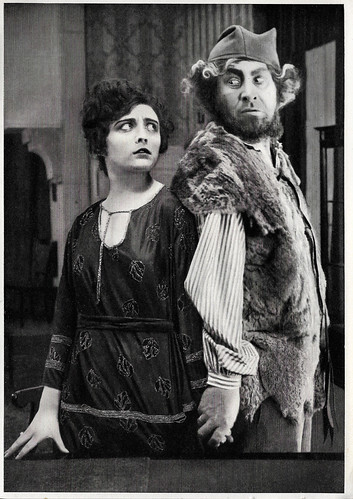
German collectors card by Ross Verlag in the series Vom Werden Deutscher Filmkunst - Der Stumme Film, picture no. 10, group 40. Photo: Ufa. Publicity still with Pola Negri and Emil Jannings in Vendetta (Georg Jacoby, 1919).
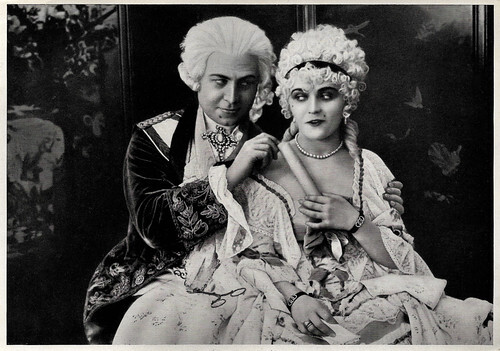
German collectors card by Ross Verlag in the series Vom Werden Deutscher Filmkunst - Der Stumme Film, picture no. 60, group 42. Photo: Ufa. Pola Negri and Emil Jannings in Madame Dubarry/Passion (Ernst Lubitsch, 1919).
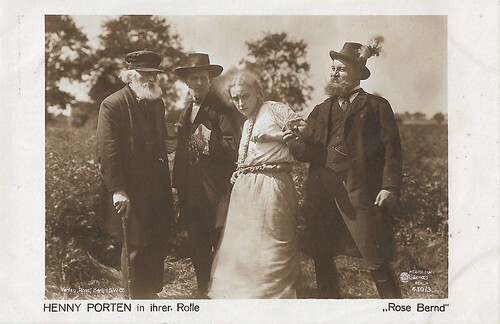
German postcard by Ross Verlag, no. 630/3. Henny Porten as Rose Bernd, and Emil Jannings as the brutal suitor Arthur Streckmann in Rose Bernd (Alfred Halm, 1919), adapted from the eponymous play by Gerhard Hauptmann. The man with the white beard may be Werner Krauß as Rose's father.
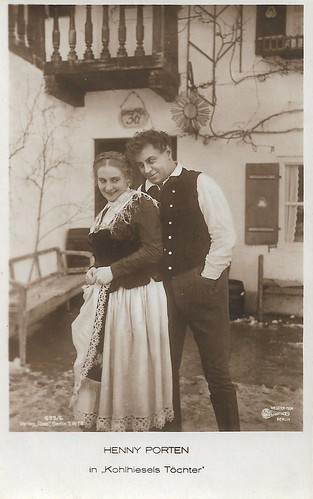
German postcard by Ross Verlag, no. 639/6. Photo: Messter Film, Berlin. Henny Porten and Emil Jannings in Kohlhiesels Töchter/Kohlhiesel's Daughters (Ernst Lubitsch, 1920).
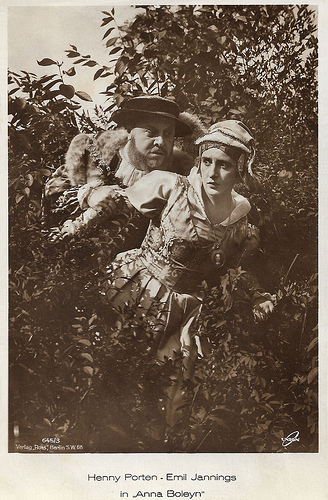
German postcard by Ross Verlag, Berlin, no. 645/3, 1919-1924. Photo: Union Film. Emil Jannings and Henny Porten in Anna Boleyn (Ernst Lubitsch, 1920).
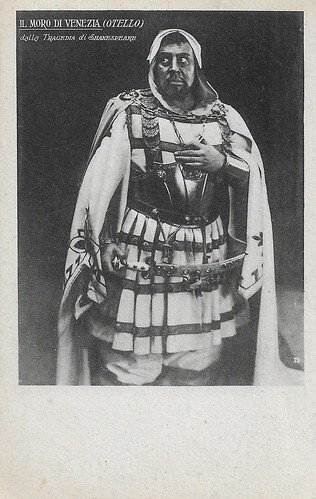
Italian postcard for BAM Cinema Capranica, Rome, no. 19. Emil Jannings as Othello in Othello (Dimitri Buchowetzki, 1922), adapted from William Shakespeare's play. The Italian release titles were Il Moro di Venezia and Otello.
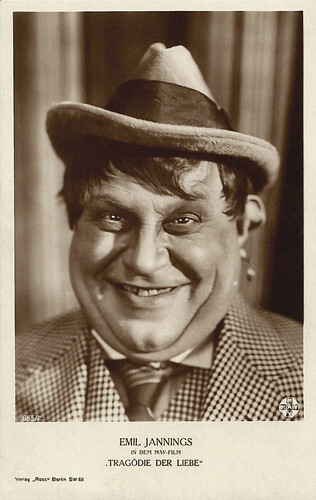
German postcard by Ross Verlag, no. 665/2, 1919-1924. Photo: May Film. Publicity still for Tragödie der Liebe/Love Tragedy (1923).
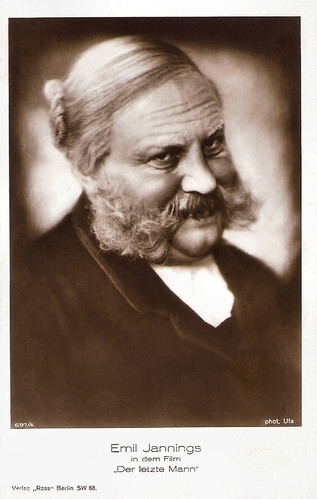
German postcard by Ross Verlag, no. 697/4, 1919-1924. Photo: Ufa. Emil Jannings in Der Letzte Mann/The Last Laugh (F.W. Murnau, 1924).
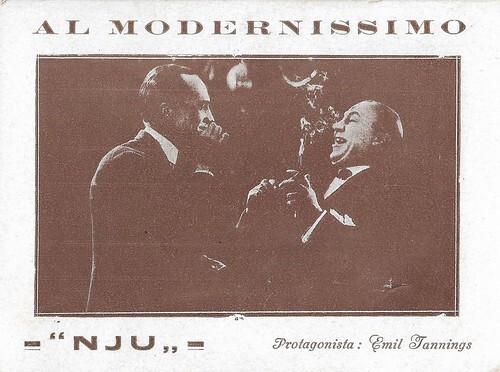
Italian postcard by Ifas for the Palermo-based cinema Modernissimo. Photo: Emil Jannings and Conrad Veidt in Nju - Eine unverstandene Frau/Husbands or Lovers (Paul Czinner, 1924).
Quo vadis?
Emil Jannings starred as Emperor Nero in the Italo-German coproduction Quo vadis? , which was shot in Rome with an international cast including Lilian Hall-Davis, Alphons Fryland , Elga Brink , Elena Sangro , Rina de Liguoro and Raimondo Van Riel .
The producer was grand old man Arturo Ambrosio of the Unione Cinematografica Italiana, a Universal-like merger of many Italian prewar companies. The film had its Roman premiere in March 1925. Quo vadis? tried to equal the earlier version of 1913, adding enormous sets, designed by architect Brasini, and streaks of sadism and nudity, but it didn't have the worldwide success of Enrico Guazzoni's 1913 version.
People were a bit bored with epic films and the censor ordered cuts. The producer almost went bankrupt over copyright claims. It didn't help that the lion tamer Alfred Schneider was convicted because one of his circus lions had killed an extra. But Quo vadis? is a fascinating film, especially for Jannings's performance as the evil emperor. In 2002, the film was restored by Eye Filmmuseum in the Netherlands, based on various existing copies. This restored version had its 're-premiere' at the Cinema Ritrovato film festival in Bologna. In 2024, the film was shown again at Cinema Ritrovato to a large audience.
After his return from Italy, Jannings managed to turn away from period pieces in two films that were produced by Ufa. In Friedrich Wilhelm Murnau 's Der letzte Mann/The Last Laugh (1924), he played a proud hotel doorman who loses his self-esteem and the esteem of others when he is reduced to a toilet man, working in the basement of the hotel. In Varieté/Variety (Ewald André Dupont, 1925), he is the strong acrobat, who kills his rival out of jealousy. In these two films, he succeeded in arousing sympathy and understanding for characters who at first belie their fears and despair with rough behaviour.
Emil Jannings magnificently expressed the fears and doubts of proud and big-hearted men, who are cheated by their surroundings. F.W. Murnau directed him in two more silent classics Tartüff/Tartuffe (Friedrich Wilhelm Murnau, 1925) with Lil Dagover , and Faust (Friedrich Wilhelm Murnau, 1925) as Mephisto opposite Gösta Ekman as Faust. The international success of his films brought Jannings a three-year contract with Paramount, where Ernst Lubitsch and Pola Negri were already working.
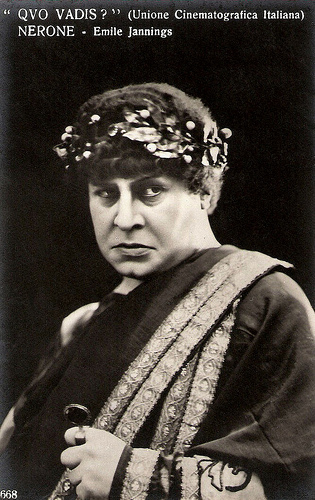
Italian card by editor A. Traldi, Milano. On the back is an ink stamp for the Politeama Cesare Rossi, Fano. Photo: Emil Jannings as Emperor Nero in Quo vadis? (Georg Jacoby, Gabriellino D'Annunzio, 1925).
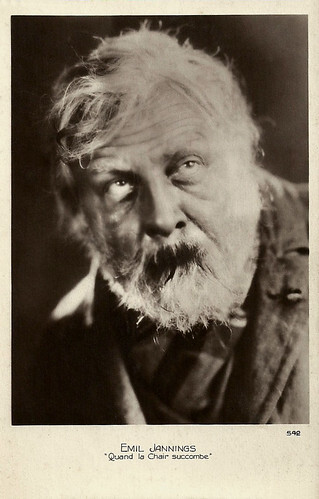
French postcard by Editions Cinémagazine, no. 542. Photo: publicity still for Quand la Chair succombe/The Way of All Flesh (1927), now a famous lost film.
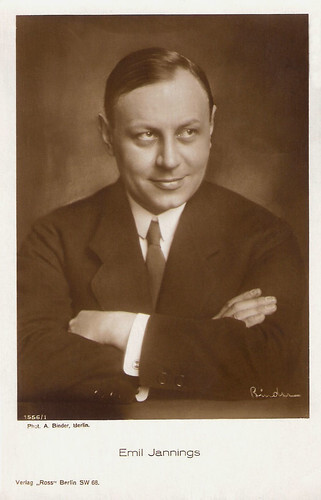
German postcard by Ross Verlag, no. 1556/1, 1927-1928. Photo: Alex Binder.
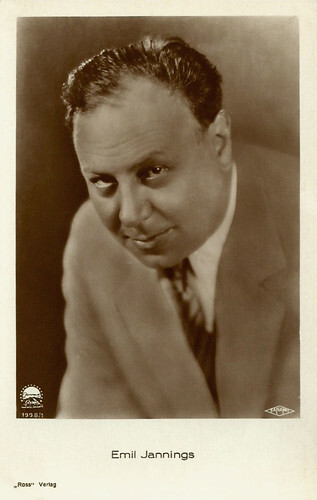
German postcard by Ross Verlag, no. 1998/1, no. 1927-1928. Photo: Paramount / ParUfaMet.
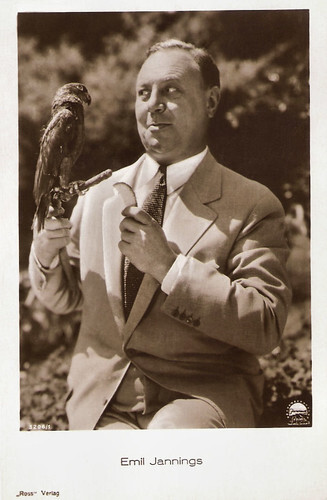
German postcard by Ross Verlag, no. 3206/1, 1928-1929. Photo: Paramount.
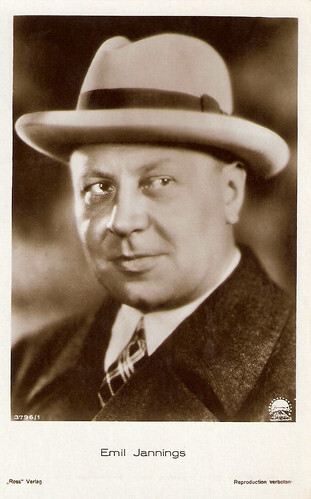
German postcard by Ross Verlag, no. 3796/1, 1928-1929. Photo: Paramount.
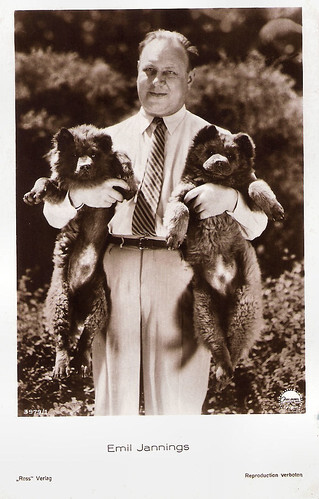
German postcard by Ross Verlag, no. 3979/1, 1928-1929. Photo: Paramount.
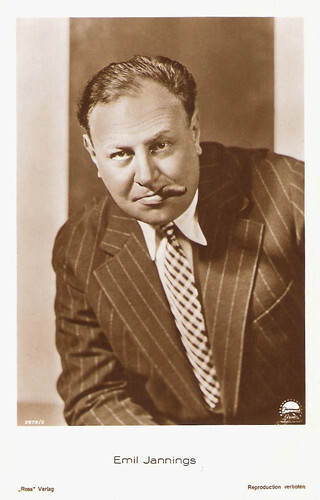
German postcard by Ross Verlag, no. 3979/2, 1928-1929. Photo: Paramount.
Paramount
In October 1926, Emil Jannings went with his wife to Hollywood. His Paramount films were mostly made according to Der letzte Mann/The Last Laugh (1924) and Varieté/Variety (1925). He played characters who lose their place in society and end in misery, men who perish by love. In The Way of All Flesh (Victor Fleming, 1927) he played a bank teller who leaves his job and his family for an adventuress. The Way of All Flesh was a great financial success. In The Last Command (Josef von Sternberg, 1928), Jannings played a former White-Russian general who was hired out as an extra in Hollywood. The two films earned him the first Oscar ever awarded to an actor.
His next film, The Street of Sin (Mauritz Stiller, Ludwig Berger, 1928) was not well received by critics or audiences. Together with Ernst Lubitsch , he tried to repeat their German successes in The Patriot (Ernst Lubitsch, 1928) in which he played the mad Czar Paul I, who is murdered at the end by Lewis Stone , the patriot of the title, for the betterment of Russia.
Jannings' first sound film project was a film version of the comedy 'Das Konzert' by Hermann Bahr, but he feared that he would not be able to match the requirements of English-language films. With the switch from silent films to talkies, public taste changed rapidly and Jannings' rather exalted acting style was quickly considered outdated. Of the five silent films Jannings made for Paramount, only The Last Command (1928) has survived intact. Of two films, The Way of All Flesh (1927) and The Patriot (1928), only brief clips remain. The other two, Street of Sin (1928) and Betrayal (1929) also starring a young Gary Cooper, are thought to be completely lost.
Emil Jannings left Hollywood and returned to Berlin, where he was launched in his first sound film Der blaue Engel/The Blue Angel (1930), directed by Josef von Sternberg . It was based on a novel by Heinrich Mann, 'Professor Unrat'. Jannings played the local university professor Immanuel Rath who falls in love with cabaret singer Lola Lola ( Marlene Dietrich ). Once married to him, she shamelessly exploits and humiliates him. When the film came out, Dietrich's popularity overshadowed Jannings's. The film was her ticket to Hollywood.
Emil Jannings returned to the stage. From 1930 on, he performed at the theatre again, multiple times in plays by Gerhart Hauptmann. In 1930, he played the role of Wehrhahn in 'Der Biberpelz', in 1932 the title role in 'Fuhrmann Henschel', and the role of privy council Clausen in 'Vor Sonnenuntergang', a role he resumed in the film Der Herrscher/The Ruler (1937). In 1933, he again played the role of Judge Adam on stage. In May 1934, he became a cast member of Staatliches Schauspielhaus where he made his last stage performance in 1936 in the role of Bismarck in 'Der Ministerpräsident' by Wolfgang Goetz.
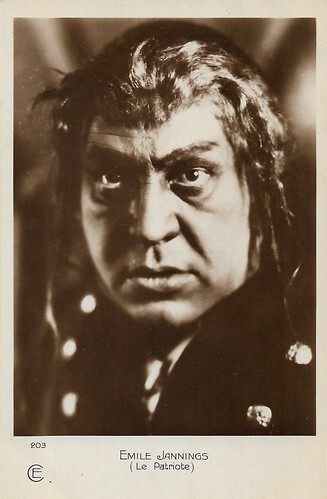
French postcard by Cinémagazine-Edition, no. 203. Photo: Paramount. Emil Jannings in The Patriot (Ernst Lubitsch, 1928).
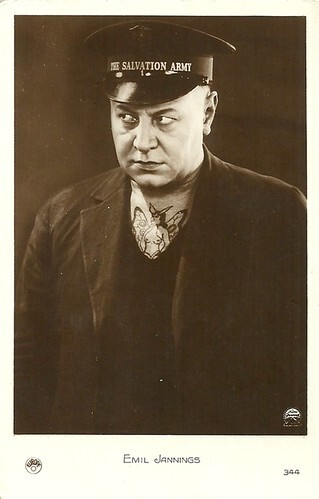
French postcard by Europe, no. 344. Emil Jannings in The Street of Sin (Mauritz Stiller, Ludwig Berger, 1928).
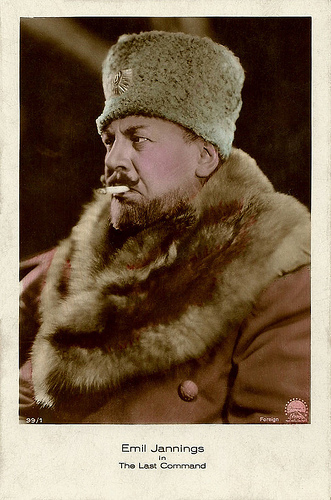
German postcard by Ross Verlag, Foreign, no. 99/1. Photo: Paramount. Publicity still for The Last Command (1928).
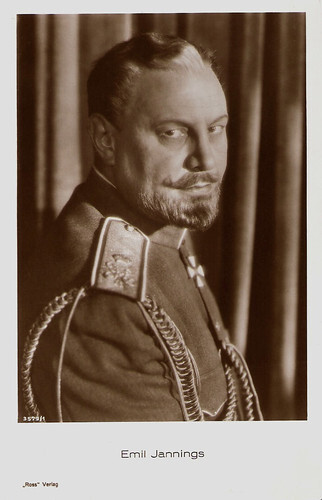
German postcard by Ross Verlag, no. 3579/1, 1928-1929.
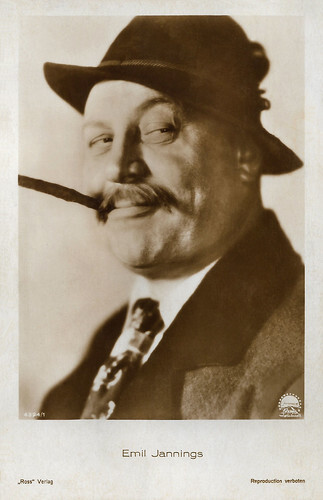
German postcard by Ross Verlag, no. 4324/1, 1929-1930. Photo: Paramount. Emil Jannings in Betrayal (Lewis Milestone, 1929).
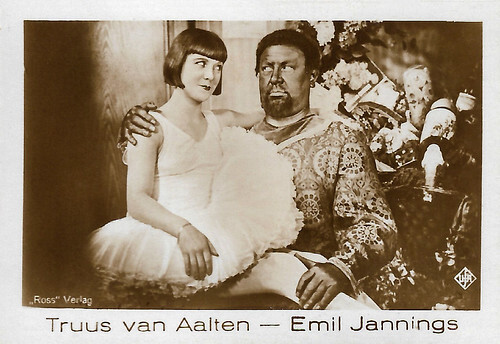
German collector card by Ross Verlag. Photo: Ufa. Truus van Aalten and Emil Jannings in Liebling der Götter/Darling of the Gods (Hanns Schwarz, 1930).
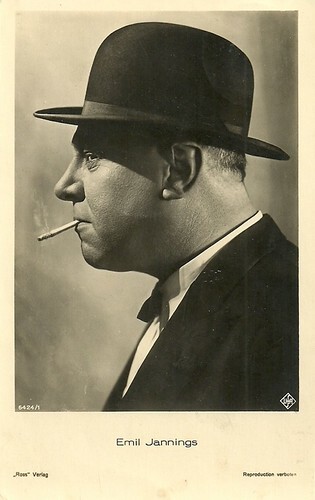
German postcard by Ross Verlag, no. 6424/1, 1931-1932. Photo: Ufa. Emil Jannings in Stürme der Leidenschaft/The Tempest (Robert Siodmak, 1931).
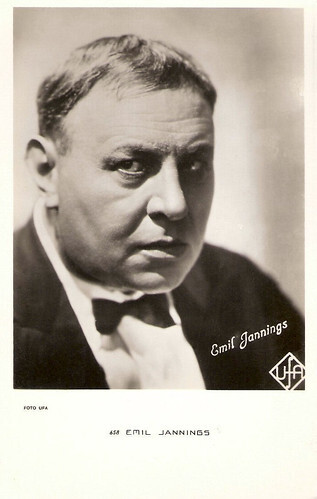
Dutch postcard, no. 658, ca. 1933. Photo: Ufa.
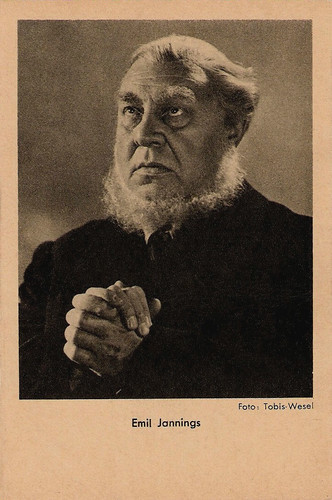
German postcard by Das Programm von Heute, Zeitschrift für Film und Theater G.m.b.H., Berlin. Licensed by Ross Verlag, Berlin. Photo: Terra-Sandau. Emil Jannings as Paul Kruger in Ohm Krüger (Hans Steinhoff, 1941).
Rulers
With his sound films of the early 1930s, Emil Jannings could not compete with his earlier successes. Only after the Nazis came to power, his star rose again. He played rulers, just like in the early 1920s, but this time, not the decadent versions anymore. He performed historical characters such as Friedrich Wilhelm I in Der Alte und der junge König/The Making of a King (Hans Steinhoff, 1935), Geheimrat Clausen in Der Herrscher/The Ruler (Veit Harlan, 1937), the title roles in Robert Koch (Hans Steinhoff, 1939) and Ohm Kruger/Uncle Kruger (Hans Steinhoff, 1941), and Bismarck in Die Entlassung/The Dismissal (Wolfgang Liebeneiner, 1942). German Wikipedia : "His films from this period were not on the same level as his earlier works; his performance in Der zerbrochene Krug/The Broken Jug (Gustav Ucicky, 1937) in particular came across more like a filmed stage performance and left the viewer with a static impression. However, the film can still be regarded as one of the most successful popular adaptations of the play, especially in terms of the humorous side of Jannings that was expressed here."
In 1936 he became a board member of Ufa and in 1938 he became chairman. He was allowed to direct his own films and thus was the main responsible for Ohm Kruger, one of the most expensive films of the Nazi era. His historical films contributed to the legitimisation of Nazi politics. These rulers were all historic predecessors to Adolph Hitler. Filmportal.de : "This film marked the pinnacle of the attempt to interpret history in terms of National socialism, and to justify current politics with historic models. In the film, the Boer War serves as a pretence to illustrate the inevitability of war against England, the politician Paul ('Ohm') Krüger is over-magnified as a Führer character."
In January 1945, Emil Jannings broke up work to the film Wo ist Herr Belling?/Where Is Mr. Belling? (Erich Engel, 1945), because of an illness. The film, never finished, was his last work. After the war, the occupational forces banned him from performing for life. Jannings reportedly carried his Oscar statuette with him as proof of his former association with Hollywood. However, his active role in Nazi propaganda meant that he was subject to denazification, effectively ending his career.
Emil Jannings became a citizen of Austria in 1947 and retired to Strobl near Salzburg. He had been married to his fourth wife, the singer and actress Gussy Noll, since 1923. He had a daughter, Ruth, from his first marriage with Erna Hennings. In the early 1920s, Jannings had been married twice, to the actresses Hanna Ralph and Lucie Höflich, respectively. In 1950, Emil Jannings died, aged 65, from liver cancer in his residence at Wolfgangsee in the Salzkammergut region. He is buried in the St. Wolfgang cemetery. His Best Actor Oscar is now on display at the Berlin Filmmuseum.
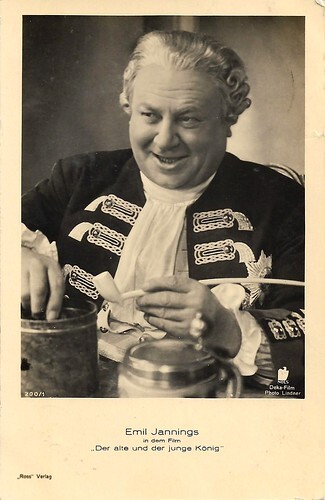
German postcard by Ross Verlag, no. 200/1. Photo: Lindner / Deka-Film / NDLS. Emil Jannings in Der alte und der junge König/The Making of a King (Hans Steinhoff, 1935).
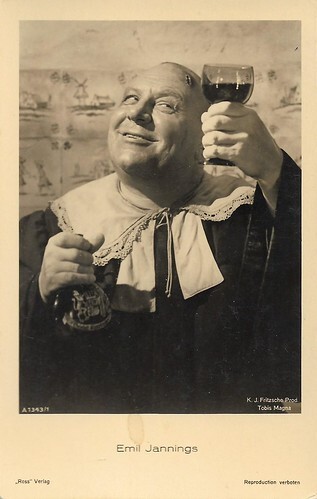
German postcard by Ross Verlag, no. A 1343/1, 1937-1938. Photo: K.J. Fritzsche Prod. / Tobis Magna. Emil Jannings in Der zerbrochene Krug/The Broken Jug (Gustav Ucicky, Emil Jannings, 1935).
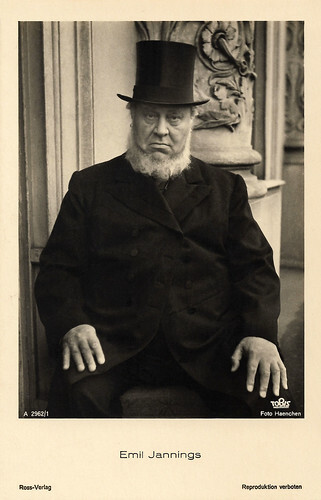
German postcard by Ross Verlag, no. A 2962/1, 1939-1940. Photo: Haenchen / Tobis. Emil Jannings as Paul Kruger in Ohm Krüger (Hans Steinhoff, 1941).
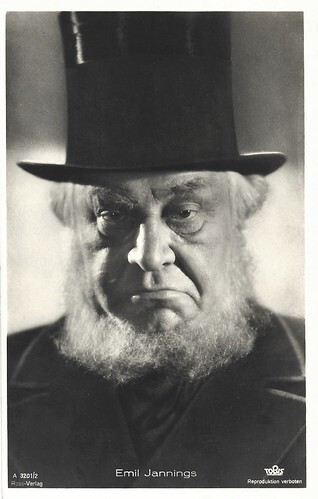
German postcard by Ross Verlag, no. A 3201/2, 1941-1944. Photo: Tobis. Emil Jannings as Paul Kruger in Ohm Kruger (Hans Steinhoff, 1941).
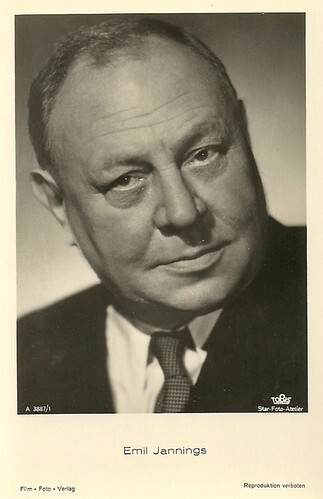
German postcard by Film-Foto-Verlag, no. A 3887/1, 1941-1944. Photo: Tobis / Star-Foto-Atelier.
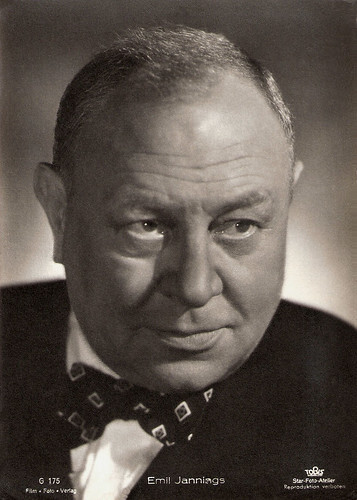
German postcard by Film-Foto-Verlag, no. G 175, 1941-1944. Photo: Star-Foto-Atelier / Tobis.
Trailer for Danton (Dimitri Buchowetzki, 1921). Source: Brian Pinette (YouTube).
Scene from Das Wachsfigurenkabinett/Waxworks (Paul Leni, 1924) with Emil Jannings as the Grand Vizier. Source: Flickr Alley Clips (YouTube).
Original trailer for Der blaue Engel/The Blue Angel (Josef von Sternberg, 1930). Source: Eurekaentertainment (YouTube).
1960s Re-release trailer for Der blaue Engel/The Blue Angel (Josef von Sternberg, 1930). Source: Eurekaentertainment (YouTube).
Sources: Filmportal.de, Wikipedia (German and English), and .

German postcard by Ross Verlag, no. 1266/4, 1927-1928. Photo: Alex Binder / Ufa. Emil Jannings in Varieté (E.A. Dupont, 1925).

German postcard by Ross Verlag, no. 410/1. Photo: Union-Film. Emil Jannings as Henry VIII in Anna Boleyn (Ernst Lubitsch, 1920).

German postcard by Verlag Ross, Berlin., no. 697/1, 1919-1924. Photo: Ufa. Emil Jannings in Der letzte Mann/The Last Laugh (Friedrich Wilhelm Murnau, 1924).

German postcard by Ross Verlag, no. 698/1. Photo: Filmhaus Bruckmann. Emil Jannings as Nero in Quo vadis? (Gabriellino D'Annunzio, Georg Jacoby, 1924).

Italian postcard by G.B. Falci, Milano, no. 269. Photo: S.A.I. Films / Paramount. Emil Jannings in The Way of All Flesh (Victor Fleming, 1927). The Italian release title was Nel gorgo del peccato.

French postcard by A.N., no. 365. Photo: Paramount. Emil Jannings in The Patriot (Ernst Lubitsch, 1928).

German postcard by Ross Verlag, no. 4746/1, 1929-1930. Photo: Ufa. Publicity still for Der blaue Engel/The Blue Angel (1930).
In the trenches
Emil Jannings was born Theodor Friedrich Emil Janenz in Rorschach, Switzerland, in 1884. He was the son of German-American merchant Emil Janenz and his wife Margarethe Schwabe. He grew up in Leipzig in the German Empire and further in Görlitz after the early death of his father. Emil had two brothers and a sister.
He left grammar school in the ninth grade. His mother initially forbade him from becoming an actor, so he went to sea as a ship's boy for a year. On his return to Görlitz, she allowed him to begin a traineeship in acting at the Görlitz theatre. He did not show any talent though, but Jannings did not give up. From 1901 on, he played in several provincial theatres and with travelling companies.
From 1907 to 1908, he performed in Stettin, from 1908 to 1911 in Bonn where he also directed several productions, from 1911 to 1912 in Königsberg, from 1912 to 1913 in Nuremberg (together with Werner Krauß ), and from 1913 to 1914 in Darmstadt and in Bremen. In 1914, he reached Berlin. Jannings had his first film role in the War Propaganda film Im Schützengraben/In the Trenches (Walter Schmidthässler, 1914). He did not see film work as his fulfilment. Artistically, it was not an adequate medium for his acting, as he was unable to use his versatile voice in silent films.
In 1915-1916, he was engaged at Max Reinhardt 's Deutsches Theater. At Reinhardt's theatre, he at first mainly played smaller and mid-size roles. In 1916, he directed Gustav Kaltenbach's comedy 'Familie Schimek' at Deutsches Theater. Through Reinhardt, Jannings met author Karl Gustav Vollmoeller and Ernst Lubitsch. Both were important cultural figures in Berlin society in the Golden Twenties. Berlin society photographer Frieda Riess took portraits of him.
From 1917 on, he played larger roles, for instance, the role of Wehrhahn in 'Der Biberpelz' (The Beaver Coat") by Gerhart Hauptmann, or the role of Gustav Hein in Hermann Bahr's 'Das Konzert' (The Concert). In the summer of 1918, he went to Königliches Schauspielhaus where he made his first performance in the role of the village judge Adam in Heinrich von Kleist's 'Der zerbrochene Krug' (The Broken Jug). It became his greatest stage triumph. At the end of 1918, he returned to Deutsches Theater, getting bigger and bigger roles. He left the ensemble in June 1920.

German postcard, no. 9904. Photo: Karl Schenker, Berlin.

German postcard by Verlag Hermann Leiser, Berlin-Wilm., no. 1880. Photo: Fritz Richard. Emil Jannings in 'Kollege Crampton' by Gerhart Hauptmann.

Spanish postcard. Photo: Ufa. Written dedication: "To the audience of the Kursaal." This could refer to the Kursaal in Barcelona or the Kursaal in Madrid.

French postcard by Editions Cinémagazine, no. 205.

German collectors card by Ross Verlag in the series Vom Werden Deutscher Filmkunst - Der Stumme Film, picture, no, 29, Group 43. Photo: publicity still for Arme Eva (Robert Wiene, 1914). Caption: Emil Jannings, jung und schön, in seinem ersten Film, Fromont junior, Risler senior. (Emil Jannings, young and handsome, in his first film Fromont junior, Risler senior. According to other sources, Arme Eva (Robert Wiene, 1914) was his first film.

German postcard by Photochemie, Berlin, no. K. 1989. Photo: Union Film. Erna Morena , Emil Jannings and Harry Liedtke in Der Ring der Giuditta Foscari (Alfred Halm, 1917).

German postcard by Photochemie, Berlin, no. K. 2008. Photo: Union-Film. Ossi Oswalda in the German silent comedy Wenn vier dasselbe tun (Ernst Lubitsch, 1917), starring Ossi Oswalda as the girl, Fritz Schulz (here on the left) as her lover, and Emil Jannings as her father (here on the right).

German postcard by Rotophot in the Film-Sterne series, no. 500/3. Photo: Messter Film, Berlin. Henny Porten and Emil Jannings in Die Ehe der Luise Rohrbach/The Marriage of Luise Rohrbach (Rudolf Biebrach 1917), based on a novel by Emmi Elert.
Ernst Lubitsch
From 1916 on, Emil Jannings played more and more in film, mostly in quickly staged melodramas and crime stories. From 1916 on, Jannings regularly appeared in films, mostly in quickly filmed melodramas that covered the topics of love and passion, money and crime.
In 1919 he had his big breakthrough as Louis XV in the lavish period piece Madame DuBarry, directed by his former theatre colleague Ernst Lubitsch .
It became a turning point in his career. The film was such an international hit that former war adversaries such as the United States embraced German cinema. Jannings and his co-star Pola Negri became instant celebrities.
He focused on his film career instead of the theatre. For a while, he continued to play debauched rulers such as Henry VIII in Anna Boleyn/Deception (Ernst Lubitsch, 1920), Amenes in Das Weib des Pharao/Pharoah's Wife (Ernst Lubitsch, 1922) and Czar Peter the Great in Peter der Grosse (Dimitri Buchowetzki, 1922).
Again and again, Jannings embodied this type of character in his films of the early 1920s. Other strong historical characters were the title roles in Danton/All for a Woman (1921) and Othello (1922), both directed by Dimitri Buchowetzki.

German collectors card by Ross Verlag in the series Vom Werden Deutscher Filmkunst - Der Stumme Film, picture no. 10, group 40. Photo: Ufa. Publicity still with Pola Negri and Emil Jannings in Vendetta (Georg Jacoby, 1919).

German collectors card by Ross Verlag in the series Vom Werden Deutscher Filmkunst - Der Stumme Film, picture no. 60, group 42. Photo: Ufa. Pola Negri and Emil Jannings in Madame Dubarry/Passion (Ernst Lubitsch, 1919).

German postcard by Ross Verlag, no. 630/3. Henny Porten as Rose Bernd, and Emil Jannings as the brutal suitor Arthur Streckmann in Rose Bernd (Alfred Halm, 1919), adapted from the eponymous play by Gerhard Hauptmann. The man with the white beard may be Werner Krauß as Rose's father.

German postcard by Ross Verlag, no. 639/6. Photo: Messter Film, Berlin. Henny Porten and Emil Jannings in Kohlhiesels Töchter/Kohlhiesel's Daughters (Ernst Lubitsch, 1920).

German postcard by Ross Verlag, Berlin, no. 645/3, 1919-1924. Photo: Union Film. Emil Jannings and Henny Porten in Anna Boleyn (Ernst Lubitsch, 1920).

Italian postcard for BAM Cinema Capranica, Rome, no. 19. Emil Jannings as Othello in Othello (Dimitri Buchowetzki, 1922), adapted from William Shakespeare's play. The Italian release titles were Il Moro di Venezia and Otello.

German postcard by Ross Verlag, no. 665/2, 1919-1924. Photo: May Film. Publicity still for Tragödie der Liebe/Love Tragedy (1923).

German postcard by Ross Verlag, no. 697/4, 1919-1924. Photo: Ufa. Emil Jannings in Der Letzte Mann/The Last Laugh (F.W. Murnau, 1924).

Italian postcard by Ifas for the Palermo-based cinema Modernissimo. Photo: Emil Jannings and Conrad Veidt in Nju - Eine unverstandene Frau/Husbands or Lovers (Paul Czinner, 1924).
Quo vadis?
Emil Jannings starred as Emperor Nero in the Italo-German coproduction Quo vadis? , which was shot in Rome with an international cast including Lilian Hall-Davis, Alphons Fryland , Elga Brink , Elena Sangro , Rina de Liguoro and Raimondo Van Riel .
The producer was grand old man Arturo Ambrosio of the Unione Cinematografica Italiana, a Universal-like merger of many Italian prewar companies. The film had its Roman premiere in March 1925. Quo vadis? tried to equal the earlier version of 1913, adding enormous sets, designed by architect Brasini, and streaks of sadism and nudity, but it didn't have the worldwide success of Enrico Guazzoni's 1913 version.
People were a bit bored with epic films and the censor ordered cuts. The producer almost went bankrupt over copyright claims. It didn't help that the lion tamer Alfred Schneider was convicted because one of his circus lions had killed an extra. But Quo vadis? is a fascinating film, especially for Jannings's performance as the evil emperor. In 2002, the film was restored by Eye Filmmuseum in the Netherlands, based on various existing copies. This restored version had its 're-premiere' at the Cinema Ritrovato film festival in Bologna. In 2024, the film was shown again at Cinema Ritrovato to a large audience.
After his return from Italy, Jannings managed to turn away from period pieces in two films that were produced by Ufa. In Friedrich Wilhelm Murnau 's Der letzte Mann/The Last Laugh (1924), he played a proud hotel doorman who loses his self-esteem and the esteem of others when he is reduced to a toilet man, working in the basement of the hotel. In Varieté/Variety (Ewald André Dupont, 1925), he is the strong acrobat, who kills his rival out of jealousy. In these two films, he succeeded in arousing sympathy and understanding for characters who at first belie their fears and despair with rough behaviour.
Emil Jannings magnificently expressed the fears and doubts of proud and big-hearted men, who are cheated by their surroundings. F.W. Murnau directed him in two more silent classics Tartüff/Tartuffe (Friedrich Wilhelm Murnau, 1925) with Lil Dagover , and Faust (Friedrich Wilhelm Murnau, 1925) as Mephisto opposite Gösta Ekman as Faust. The international success of his films brought Jannings a three-year contract with Paramount, where Ernst Lubitsch and Pola Negri were already working.

Italian card by editor A. Traldi, Milano. On the back is an ink stamp for the Politeama Cesare Rossi, Fano. Photo: Emil Jannings as Emperor Nero in Quo vadis? (Georg Jacoby, Gabriellino D'Annunzio, 1925).

French postcard by Editions Cinémagazine, no. 542. Photo: publicity still for Quand la Chair succombe/The Way of All Flesh (1927), now a famous lost film.

German postcard by Ross Verlag, no. 1556/1, 1927-1928. Photo: Alex Binder.

German postcard by Ross Verlag, no. 1998/1, no. 1927-1928. Photo: Paramount / ParUfaMet.

German postcard by Ross Verlag, no. 3206/1, 1928-1929. Photo: Paramount.

German postcard by Ross Verlag, no. 3796/1, 1928-1929. Photo: Paramount.

German postcard by Ross Verlag, no. 3979/1, 1928-1929. Photo: Paramount.

German postcard by Ross Verlag, no. 3979/2, 1928-1929. Photo: Paramount.
Paramount
In October 1926, Emil Jannings went with his wife to Hollywood. His Paramount films were mostly made according to Der letzte Mann/The Last Laugh (1924) and Varieté/Variety (1925). He played characters who lose their place in society and end in misery, men who perish by love. In The Way of All Flesh (Victor Fleming, 1927) he played a bank teller who leaves his job and his family for an adventuress. The Way of All Flesh was a great financial success. In The Last Command (Josef von Sternberg, 1928), Jannings played a former White-Russian general who was hired out as an extra in Hollywood. The two films earned him the first Oscar ever awarded to an actor.
His next film, The Street of Sin (Mauritz Stiller, Ludwig Berger, 1928) was not well received by critics or audiences. Together with Ernst Lubitsch , he tried to repeat their German successes in The Patriot (Ernst Lubitsch, 1928) in which he played the mad Czar Paul I, who is murdered at the end by Lewis Stone , the patriot of the title, for the betterment of Russia.
Jannings' first sound film project was a film version of the comedy 'Das Konzert' by Hermann Bahr, but he feared that he would not be able to match the requirements of English-language films. With the switch from silent films to talkies, public taste changed rapidly and Jannings' rather exalted acting style was quickly considered outdated. Of the five silent films Jannings made for Paramount, only The Last Command (1928) has survived intact. Of two films, The Way of All Flesh (1927) and The Patriot (1928), only brief clips remain. The other two, Street of Sin (1928) and Betrayal (1929) also starring a young Gary Cooper, are thought to be completely lost.
Emil Jannings left Hollywood and returned to Berlin, where he was launched in his first sound film Der blaue Engel/The Blue Angel (1930), directed by Josef von Sternberg . It was based on a novel by Heinrich Mann, 'Professor Unrat'. Jannings played the local university professor Immanuel Rath who falls in love with cabaret singer Lola Lola ( Marlene Dietrich ). Once married to him, she shamelessly exploits and humiliates him. When the film came out, Dietrich's popularity overshadowed Jannings's. The film was her ticket to Hollywood.
Emil Jannings returned to the stage. From 1930 on, he performed at the theatre again, multiple times in plays by Gerhart Hauptmann. In 1930, he played the role of Wehrhahn in 'Der Biberpelz', in 1932 the title role in 'Fuhrmann Henschel', and the role of privy council Clausen in 'Vor Sonnenuntergang', a role he resumed in the film Der Herrscher/The Ruler (1937). In 1933, he again played the role of Judge Adam on stage. In May 1934, he became a cast member of Staatliches Schauspielhaus where he made his last stage performance in 1936 in the role of Bismarck in 'Der Ministerpräsident' by Wolfgang Goetz.

French postcard by Cinémagazine-Edition, no. 203. Photo: Paramount. Emil Jannings in The Patriot (Ernst Lubitsch, 1928).

French postcard by Europe, no. 344. Emil Jannings in The Street of Sin (Mauritz Stiller, Ludwig Berger, 1928).

German postcard by Ross Verlag, Foreign, no. 99/1. Photo: Paramount. Publicity still for The Last Command (1928).

German postcard by Ross Verlag, no. 3579/1, 1928-1929.

German postcard by Ross Verlag, no. 4324/1, 1929-1930. Photo: Paramount. Emil Jannings in Betrayal (Lewis Milestone, 1929).

German collector card by Ross Verlag. Photo: Ufa. Truus van Aalten and Emil Jannings in Liebling der Götter/Darling of the Gods (Hanns Schwarz, 1930).

German postcard by Ross Verlag, no. 6424/1, 1931-1932. Photo: Ufa. Emil Jannings in Stürme der Leidenschaft/The Tempest (Robert Siodmak, 1931).

Dutch postcard, no. 658, ca. 1933. Photo: Ufa.

German postcard by Das Programm von Heute, Zeitschrift für Film und Theater G.m.b.H., Berlin. Licensed by Ross Verlag, Berlin. Photo: Terra-Sandau. Emil Jannings as Paul Kruger in Ohm Krüger (Hans Steinhoff, 1941).
Rulers
With his sound films of the early 1930s, Emil Jannings could not compete with his earlier successes. Only after the Nazis came to power, his star rose again. He played rulers, just like in the early 1920s, but this time, not the decadent versions anymore. He performed historical characters such as Friedrich Wilhelm I in Der Alte und der junge König/The Making of a King (Hans Steinhoff, 1935), Geheimrat Clausen in Der Herrscher/The Ruler (Veit Harlan, 1937), the title roles in Robert Koch (Hans Steinhoff, 1939) and Ohm Kruger/Uncle Kruger (Hans Steinhoff, 1941), and Bismarck in Die Entlassung/The Dismissal (Wolfgang Liebeneiner, 1942). German Wikipedia : "His films from this period were not on the same level as his earlier works; his performance in Der zerbrochene Krug/The Broken Jug (Gustav Ucicky, 1937) in particular came across more like a filmed stage performance and left the viewer with a static impression. However, the film can still be regarded as one of the most successful popular adaptations of the play, especially in terms of the humorous side of Jannings that was expressed here."
In 1936 he became a board member of Ufa and in 1938 he became chairman. He was allowed to direct his own films and thus was the main responsible for Ohm Kruger, one of the most expensive films of the Nazi era. His historical films contributed to the legitimisation of Nazi politics. These rulers were all historic predecessors to Adolph Hitler. Filmportal.de : "This film marked the pinnacle of the attempt to interpret history in terms of National socialism, and to justify current politics with historic models. In the film, the Boer War serves as a pretence to illustrate the inevitability of war against England, the politician Paul ('Ohm') Krüger is over-magnified as a Führer character."
In January 1945, Emil Jannings broke up work to the film Wo ist Herr Belling?/Where Is Mr. Belling? (Erich Engel, 1945), because of an illness. The film, never finished, was his last work. After the war, the occupational forces banned him from performing for life. Jannings reportedly carried his Oscar statuette with him as proof of his former association with Hollywood. However, his active role in Nazi propaganda meant that he was subject to denazification, effectively ending his career.
Emil Jannings became a citizen of Austria in 1947 and retired to Strobl near Salzburg. He had been married to his fourth wife, the singer and actress Gussy Noll, since 1923. He had a daughter, Ruth, from his first marriage with Erna Hennings. In the early 1920s, Jannings had been married twice, to the actresses Hanna Ralph and Lucie Höflich, respectively. In 1950, Emil Jannings died, aged 65, from liver cancer in his residence at Wolfgangsee in the Salzkammergut region. He is buried in the St. Wolfgang cemetery. His Best Actor Oscar is now on display at the Berlin Filmmuseum.

German postcard by Ross Verlag, no. 200/1. Photo: Lindner / Deka-Film / NDLS. Emil Jannings in Der alte und der junge König/The Making of a King (Hans Steinhoff, 1935).

German postcard by Ross Verlag, no. A 1343/1, 1937-1938. Photo: K.J. Fritzsche Prod. / Tobis Magna. Emil Jannings in Der zerbrochene Krug/The Broken Jug (Gustav Ucicky, Emil Jannings, 1935).

German postcard by Ross Verlag, no. A 2962/1, 1939-1940. Photo: Haenchen / Tobis. Emil Jannings as Paul Kruger in Ohm Krüger (Hans Steinhoff, 1941).

German postcard by Ross Verlag, no. A 3201/2, 1941-1944. Photo: Tobis. Emil Jannings as Paul Kruger in Ohm Kruger (Hans Steinhoff, 1941).

German postcard by Film-Foto-Verlag, no. A 3887/1, 1941-1944. Photo: Tobis / Star-Foto-Atelier.

German postcard by Film-Foto-Verlag, no. G 175, 1941-1944. Photo: Star-Foto-Atelier / Tobis.
Trailer for Danton (Dimitri Buchowetzki, 1921). Source: Brian Pinette (YouTube).
Scene from Das Wachsfigurenkabinett/Waxworks (Paul Leni, 1924) with Emil Jannings as the Grand Vizier. Source: Flickr Alley Clips (YouTube).
Original trailer for Der blaue Engel/The Blue Angel (Josef von Sternberg, 1930). Source: Eurekaentertainment (YouTube).
1960s Re-release trailer for Der blaue Engel/The Blue Angel (Josef von Sternberg, 1930). Source: Eurekaentertainment (YouTube).
Sources: Filmportal.de, Wikipedia (German and English), and .
Published on December 06, 2024 22:00
December 5, 2024
Dümmatzen
We discovered this series of Spanish postcards of international film stars published in the early 1930s. The publisher's name is written prominently on the cards: Dümmatzen. But what - or better, who - was Dümmatzen? On his Spanish postcard blog 'El Cartofilo Empedernido', Carlos Pascual del Cose explains that Pablo Dümmatzen can be considered the longest-lived publisher of Spanish cartophily. Dümmatzen died in Barcelona in 1971, at the age of 93. He had by then dedicated more than 70 years of his life to the production of postcards. We selected 20 postcards with lesser-known stars of Dümmatzen's incredible production.
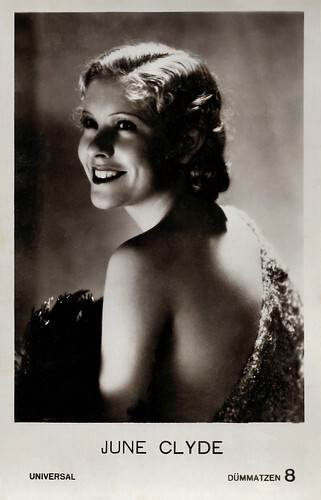
Spanish postcard by Dümmatzen, no. 8. Photo: Universal.
Vivacious blonde June Clyde (1909-1987) was an American actress, singer and dancer. She was known for roles in such pre-Code films as A Strange Adventure (1932), Tess of the Storm Country (1932) and A Study in Scarlet (1933), with Reginald Owen as Sherlock Holmes. In 1934, Clyde moved to England with her husband Thornton Freeland and appeared in several British films and stage productions.
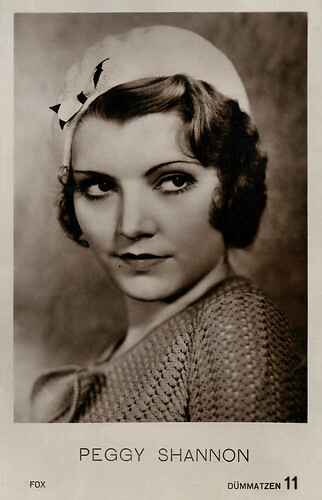
Spanish postcard by Dümmatzen, no. 11. Photo: Fox.
American actress and Ziegfeld Girl Peggy Shannon (1907- 1941) was promoted as 'the New Clara Bow'' but her Hollywood career was soon over and she moved to Broadway. A serious drinking problem finished her career and ended her life at only 34.
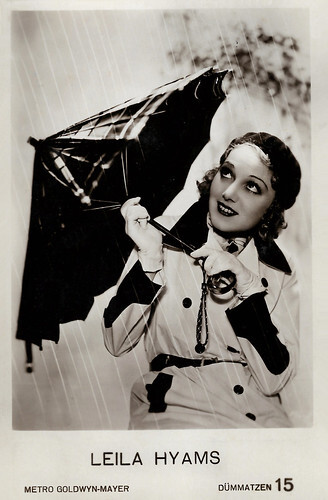
German postcard by Dümmatzen, no. 15. Photo: Metro-Goldwyn-Mayer.
Charming American model, vaudeville and film actress Leila Hyams (1905-1977) was one of Hollywood's top leading ladies of the early talkie pre-code years. She had spark, personality, charisma, and a touch of down-to-earthness and naturalness that won over movie fans; they could relate to her. She is best known for her roles in the classic horror features Freaks (1932) and Island of Lost Souls (1932). Her career lasted little more than a decade.
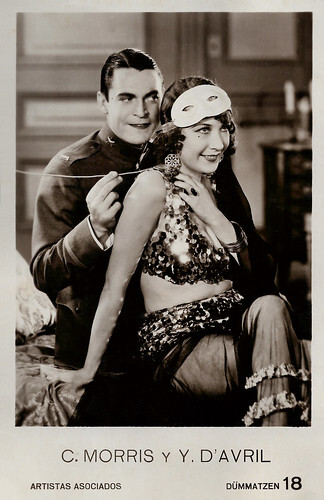
Spanish postcard by Dümmatzen, no. 18. Photo: United Artists.
American actor Chester Morris (1901-1970) was a Broadway star who billed himself as "the youngest leading man in the country". With his dark, good looks and chiselled jaw, he became a film star in the sound era. Morris was Oscar-nominated for Alibi (1929), but his greatest success was The Big House (1930). However, his star dimmed and by the end of the decade, he was appearing in B-pictures, From 1941, the Boston Blackie series at Columbia Pictures revived his career. In all, he appeared in 14 films as the detective.
French-born actress Yola d'Avril (1907-1984) arrived in Hollywood at the end of the silent era. She became close friends with Gloria Swanson, who guided her career. First National dropped her due to her French accent. Still, she co-starred with Joan Blondell in God's Gift to Women (1931) and worked with Spencer Tracy in Sky Devils (1932). Although she appeared in more than seventy films, she never became a major star.
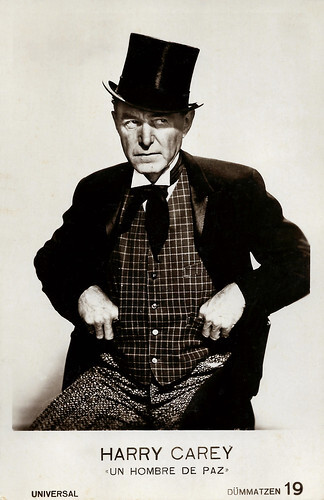
Spanish postcard by Dümmatzen, no. 19. Photo: Universal. Harry Carey in Law and Order (Edward L. Cahn, 1932).
American actor and cowboy Harry Carey (1878-1947) was one of the silent film's earliest superstars. He was the father of Harry Carey Jr., who was also a prominent actor.
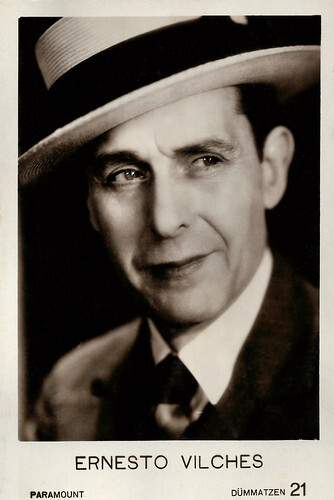
Spanish postcard by Dümmatzen, no. 21. Photo: Paramount. Ernesto Vilches.
Spanish artist, theatre director and actor Ernesto Vilches (1879-1954) worked in Spain, Argentina, Mexico and other Latin American countries. He had his own company and was one of the first Spanish actors who became a star in Hollywood.
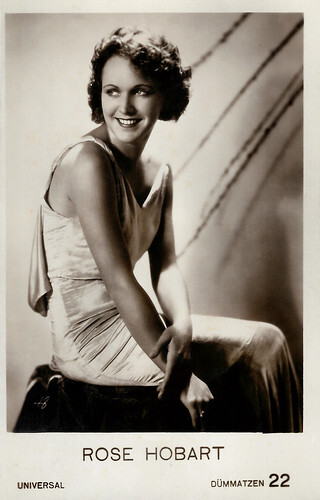
Spanish postcard by Dümmatzen, no. 22. Photo: Universal.
Blue-eyed, dark-haired Rose Hobart (1906-2000) was an American stage and film actress and a Screen Actors Guild official. She appeared in more than 40 films. Her career screeched to a halt after she was questioned by the House Un-American Activities Committee and black-listed in 1949.
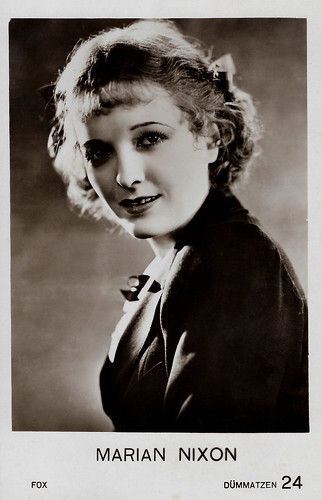
Spanish postcard by Dümmatzen, no. 24. Photo: Fox.
Marian Nixon (1904-1983), aka Marion Nixon, was an American actress, who acted in over 70 films.
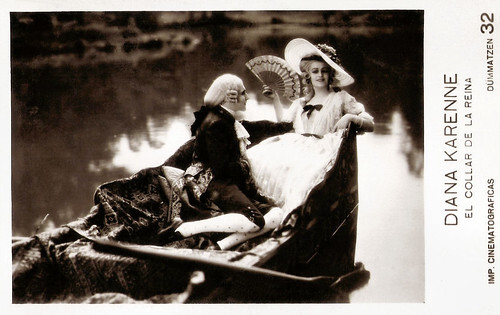
Spanish postcard by PD / Imp. Cinematograficas Dümmatzen, no. 32. Diana Karenne in Le Collier de la reine/The Queen's Necklace (Tony Lekain, Gaston Ravel, 1929).
Polish actress Diana Karenne (1888-1940) was one of the divas of Italian silent cinema. Between 1916 and 1920, Karenne fascinated audiences with her eccentric dresses and make-up, and with her primadonna behaviour. Afterwards, she had a career in German and French silent cinema.
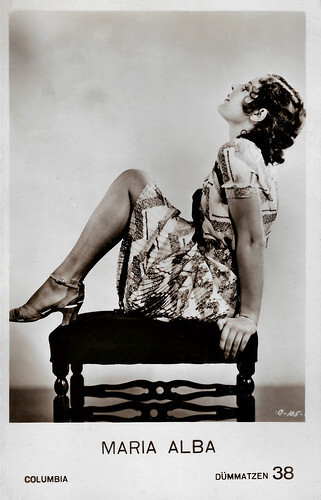
Spanish postcard by Dümmatzen, no. 38. Photo: Columbia.
Spanish-American film actress and Flamenco dancer Maria Alba (1905-1999) was one of Hollywood's Latin stars. She appeared in Hollywood films between 1927 and 1935.
One of the most beautiful and mythologised of Spanish postcards
Paul Dümmatzen was born around 1878 in Hamburg, Germany. At the beginning of 1900, he settled in Malaga, Spain, where 'Pablo' Dúmmtazen began to manufacture and distribute canned fried anchovies. How this business went is unknown, but that same year, he had a series of lithographic postcards printed in a German graphic arts workshop with Spanish views.
Remarkable was that when viewed against the light, the transparent views became night scenes, in which the moon, the windows and the illuminated street lamps stood out. This patented system was known as ‘meteor’. Carlos Pascual del Cose considers Dümmatzen 's initial series of eleven postcards, as "one of the most beautiful and mythologised of Spanish postcards". The views are from the cities of Madrid, Seville, Tangiers (with two views each), Malaga, Granada, Cordoba, Cadiz and Jerez de la Frontera. The postcards are of course in great demand.
In 1903 Pablo Dümmatzen made a major professional turn. Although he continued to produce postcards of cities, he devoted himself mainly to fantasy, beauty, greetings, humour, etc. from then on. He also moved his business to Barcelona, first in Calle Conde de Asalto number 7, and finally, around 1910, in Plaza de Tetuán number 4.
In 1907 he married Emma Hauke from Hungary, with whom he probably had no children. In 1922, Pablo Dümmatzen placed an advertisement in the newspaper La Vanguardia that explained how he worked. In the advertisement, he called for postcard models: ‘Children in military costumes, nurses, barmaids and others of great luxury. Please contact Pablo Dümmatzen. Plaza Tetuán, 4, dressed in costume, from 10 to 12.'
In Barcelona, Pablo Dümmatzen produced hundreds of thousands of postcards, including the film star series series. It is an interesting series that presents several Spanish and Mexican actors like Ernesto Vilches and Maria Alba who starred in Spanish-language versions of Hollywood films during the early sound era. Dümmatzen published the series from around 1931. 394 was the highest number we could find. The star on this card is Alice Faye and the photo was made for Fox. Fox only offered Faye a contract in 1934. So the series must have continued for several years. In 1971, Pablo Dümmatzen passed away in Barcelona, at the age of 93.
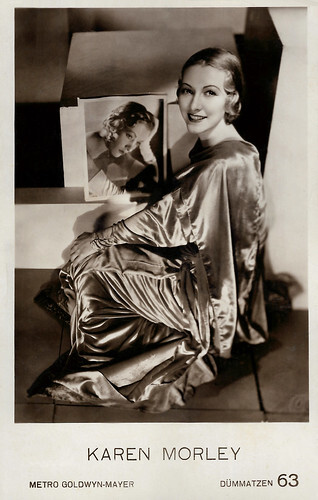
Spanish postcard by Dümmatzen, no. 63. Photo: Metro Goldwyn Mayer.
Karen Morley (1909-2003) was an American film actress whose career was broken in 1947 by the House Committee on Un-American Activities.
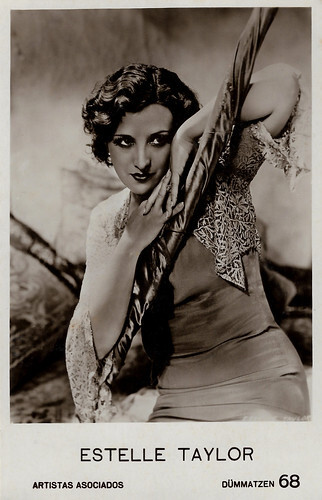
Spanish postcard by Dümmatzen, no. 68. Photo: United Artists.
Estelle Taylor (1894–1958) was an American actress, singer, model, and animal rights activist. With "dark-brown, almost black hair, and brown eyes", she was regarded as one of the most beautiful silent film stars of the 1920s.
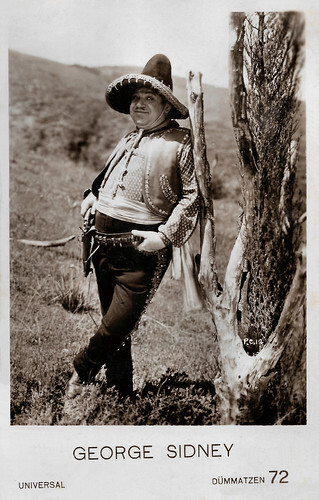
Spanish postcard by Dümmatzen, no. 72. Photo: Universal.
George Sidney (1877-1945) was a Hungarian-born film actor and comedian with long vaudeville experience. He starred in the popular The Cohens and Kellys comedy series opposite Charles Murray.
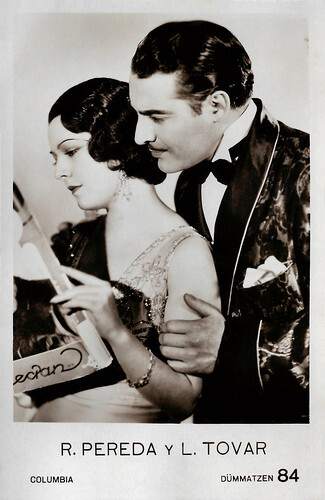
Spanish postcard by Dümmatzen, no. 84. Photo: Columbia. Lupita Tovar and Ramón Pereda in Carne de cabaret (Eduardo Arozamena, Christy Cabanne (as William Cababa), 1931). They read the magazine L'ecran. Carne de Cabaret was the Spanish-language version of Ten Cents a Dance (Lionel Barrymore, Edward Buzzell, 1931).
Mexican-American actress Lupita Tovar (1910-2016) was best known for her starring role in the Spanish-language version of Drácula (1931). It was filmed in Los Angeles by Universal at night using the same sets as the Bela Lugosi version but with a different cast and director. She also starred in Santa (1932), one of the first Mexican sound films, and one of the first commercial Spanish-language sound films. At the time of her death, she was the oldest living actress and among the last surviving stars of the Golden Ages of both Mexican cinema and Hollywood.
Ramón Pereda (1897–1986) was a Spanish-Mexican actor, screenwriter, film producer and film director. He appeared in the Spanish-language version of the Revue film Paramount on Parade (1930).
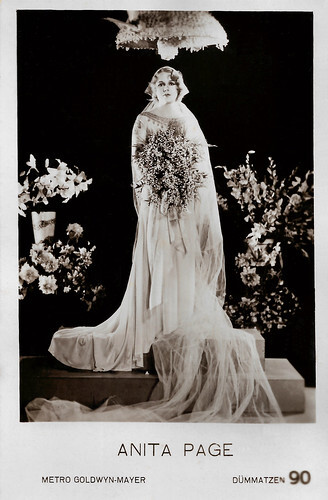
Spanish postcard by Dümmatzen, no. 90. Photo: Metro Goldwyn Mayer. Anita Page in Our Blushing Brides (Harry Beaumont, 1930).
Beautiful Anita Page (1910–2008) was one of the most popular leading ladies of Hollywood during the last years of the silent screen and the first years of the sound era. According to MGM, she received the most fan mail then and her nickname was "the girl with the most beautiful face in Hollywood".
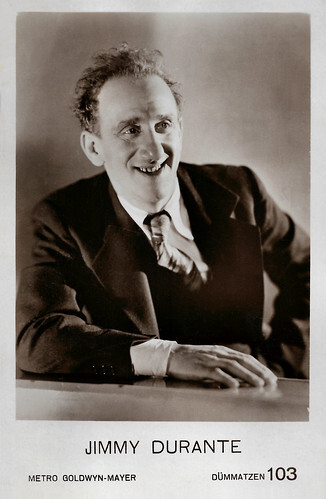
Spanish postcard by Dümmatzen no. 103. Photo: Metro Goldwyn Mayer.
Jimmy Durante (1893-1980) was an American singer, pianist, comedian, writer, and actor. His famous nickname was 'The Great Schnozzola', referencing his big nose. He was also known for his deep raspy voice when he said "Ha-Cha-Cha-Chaaaaa!". He won an Emmy Award in 1952.
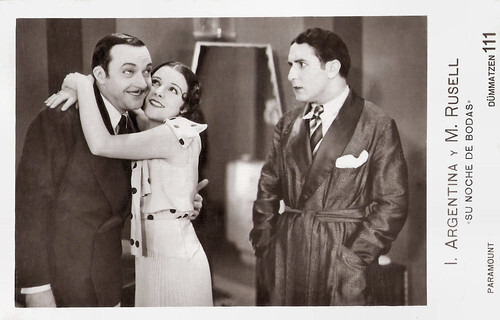
Spanish postcard by Dümmatzen, no. 111. Photo: Paramount. Publicity still of Imperio Argentina, Manuel Russell and Pepe Romeu in Su noche de bodas/Her Wedding Night (Louis Mercanton, Florián Rey, 1931).
Imperio Argentina (1906-2003) was a singer, dancer and actress, who appeared in more than 30 films. Although she was born in Buenos Aires, Argentina and was successful all over South America, she was a Spanish citizen. Besides in Spain and South America, she also worked in France, Italy and Germany.
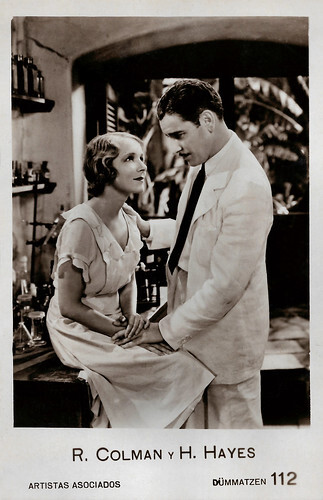
Spanish postcard by Dümmatzen, no. 112. Photo: United Artists. Ronald Colman and Helen Hayes in Arrowsmith (John Ford, 1931).
English gentleman-actor Ronald Colman (1891-1958) was a top box office draw in Hollywood films throughout the 1920s, 1930s and 1940s. ‘The Man with the Velvet Voice’ was nominated for four Academy Awards. In 1948 he finally won the Oscar for his splendid portrayal of a tormented actor in A Double Life (1947).
American film and stage actress Helen Hayes (1900-1993) had a long and successful career in American show business. She won the 1932 Academy Award for Best Actress in a Leading Role for her performance in The Sin of Madelon Claudet, and another Academy Award for her supporting role in the disaster film Airport. She also won several Tony Awards for her theatre work, the Emmy Award and the Grammy. This makes her one of the few people to win all four major awards in the US entertainment industry.
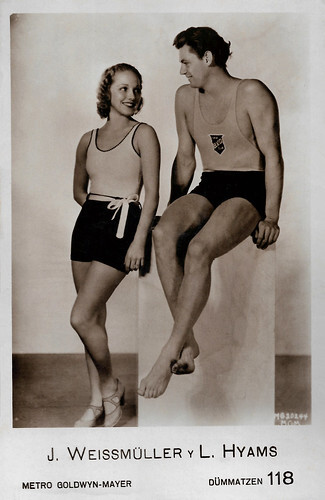
Spanish postcard by Dümmatzen, no. 118. Photo: Metro Goldwyn Mayer.
Charming American model, vaudeville and film actress Leila Hyams (1905-1977) was one of Hollywood's top leading ladies of the early talkie pre-code years. She had spark, personality, charisma, and a touch of down-to-earthness and naturalness that won over movie fans; they could relate to her. She is best known for her roles in the classic horror features Freaks (1932) and Island of Lost Souls (1932). Her career lasted little more than a decade.
German-American competition swimmer and actor Johnny Weissmuller (1904-1984) is best known for playing Tarzan in films of the 1930s and 1940s and for having one of the best competitive swimming records of the 20th century. Weissmuller was one of the world's fastest swimmers in the 1920s, winning five Olympic gold medals for swimming and one bronze medal for water polo. He won fifty-two US National Championships, set sixty-seven world records and was purportedly undefeated in official competition for the entirety of his competitive career. After his swimming career, he became the sixth actor to portray Edgar Rice Burroughs's ape man, Tarzan, a role he played in twelve films.
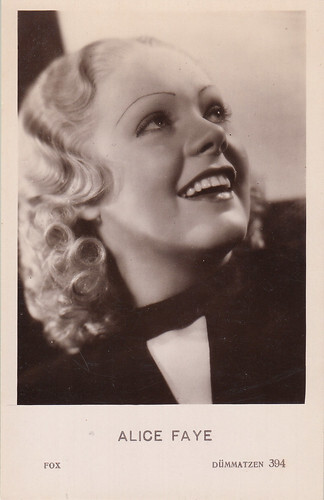
Spanish postcard by Dümmatzen, no. 394. Foto: Fox. Collection: Marlène Pilaete.
In the second half of the 1930s and the first half of the 1940s, Alice Faye (1915-1998) was a name to reckon with in the world of Hollywood musicals. Her compelling voice, her remarkable ability to put over a song and her endearing screen persona made her a top star.
Source: Carlos Pascual del Cose (El Cartofilo Empedernido - Spanish) , Wikipedia (Spanish and English) and .

Spanish postcard by Dümmatzen, no. 8. Photo: Universal.
Vivacious blonde June Clyde (1909-1987) was an American actress, singer and dancer. She was known for roles in such pre-Code films as A Strange Adventure (1932), Tess of the Storm Country (1932) and A Study in Scarlet (1933), with Reginald Owen as Sherlock Holmes. In 1934, Clyde moved to England with her husband Thornton Freeland and appeared in several British films and stage productions.

Spanish postcard by Dümmatzen, no. 11. Photo: Fox.
American actress and Ziegfeld Girl Peggy Shannon (1907- 1941) was promoted as 'the New Clara Bow'' but her Hollywood career was soon over and she moved to Broadway. A serious drinking problem finished her career and ended her life at only 34.

German postcard by Dümmatzen, no. 15. Photo: Metro-Goldwyn-Mayer.
Charming American model, vaudeville and film actress Leila Hyams (1905-1977) was one of Hollywood's top leading ladies of the early talkie pre-code years. She had spark, personality, charisma, and a touch of down-to-earthness and naturalness that won over movie fans; they could relate to her. She is best known for her roles in the classic horror features Freaks (1932) and Island of Lost Souls (1932). Her career lasted little more than a decade.

Spanish postcard by Dümmatzen, no. 18. Photo: United Artists.
American actor Chester Morris (1901-1970) was a Broadway star who billed himself as "the youngest leading man in the country". With his dark, good looks and chiselled jaw, he became a film star in the sound era. Morris was Oscar-nominated for Alibi (1929), but his greatest success was The Big House (1930). However, his star dimmed and by the end of the decade, he was appearing in B-pictures, From 1941, the Boston Blackie series at Columbia Pictures revived his career. In all, he appeared in 14 films as the detective.
French-born actress Yola d'Avril (1907-1984) arrived in Hollywood at the end of the silent era. She became close friends with Gloria Swanson, who guided her career. First National dropped her due to her French accent. Still, she co-starred with Joan Blondell in God's Gift to Women (1931) and worked with Spencer Tracy in Sky Devils (1932). Although she appeared in more than seventy films, she never became a major star.

Spanish postcard by Dümmatzen, no. 19. Photo: Universal. Harry Carey in Law and Order (Edward L. Cahn, 1932).
American actor and cowboy Harry Carey (1878-1947) was one of the silent film's earliest superstars. He was the father of Harry Carey Jr., who was also a prominent actor.

Spanish postcard by Dümmatzen, no. 21. Photo: Paramount. Ernesto Vilches.
Spanish artist, theatre director and actor Ernesto Vilches (1879-1954) worked in Spain, Argentina, Mexico and other Latin American countries. He had his own company and was one of the first Spanish actors who became a star in Hollywood.

Spanish postcard by Dümmatzen, no. 22. Photo: Universal.
Blue-eyed, dark-haired Rose Hobart (1906-2000) was an American stage and film actress and a Screen Actors Guild official. She appeared in more than 40 films. Her career screeched to a halt after she was questioned by the House Un-American Activities Committee and black-listed in 1949.

Spanish postcard by Dümmatzen, no. 24. Photo: Fox.
Marian Nixon (1904-1983), aka Marion Nixon, was an American actress, who acted in over 70 films.

Spanish postcard by PD / Imp. Cinematograficas Dümmatzen, no. 32. Diana Karenne in Le Collier de la reine/The Queen's Necklace (Tony Lekain, Gaston Ravel, 1929).
Polish actress Diana Karenne (1888-1940) was one of the divas of Italian silent cinema. Between 1916 and 1920, Karenne fascinated audiences with her eccentric dresses and make-up, and with her primadonna behaviour. Afterwards, she had a career in German and French silent cinema.

Spanish postcard by Dümmatzen, no. 38. Photo: Columbia.
Spanish-American film actress and Flamenco dancer Maria Alba (1905-1999) was one of Hollywood's Latin stars. She appeared in Hollywood films between 1927 and 1935.
One of the most beautiful and mythologised of Spanish postcards
Paul Dümmatzen was born around 1878 in Hamburg, Germany. At the beginning of 1900, he settled in Malaga, Spain, where 'Pablo' Dúmmtazen began to manufacture and distribute canned fried anchovies. How this business went is unknown, but that same year, he had a series of lithographic postcards printed in a German graphic arts workshop with Spanish views.
Remarkable was that when viewed against the light, the transparent views became night scenes, in which the moon, the windows and the illuminated street lamps stood out. This patented system was known as ‘meteor’. Carlos Pascual del Cose considers Dümmatzen 's initial series of eleven postcards, as "one of the most beautiful and mythologised of Spanish postcards". The views are from the cities of Madrid, Seville, Tangiers (with two views each), Malaga, Granada, Cordoba, Cadiz and Jerez de la Frontera. The postcards are of course in great demand.
In 1903 Pablo Dümmatzen made a major professional turn. Although he continued to produce postcards of cities, he devoted himself mainly to fantasy, beauty, greetings, humour, etc. from then on. He also moved his business to Barcelona, first in Calle Conde de Asalto number 7, and finally, around 1910, in Plaza de Tetuán number 4.
In 1907 he married Emma Hauke from Hungary, with whom he probably had no children. In 1922, Pablo Dümmatzen placed an advertisement in the newspaper La Vanguardia that explained how he worked. In the advertisement, he called for postcard models: ‘Children in military costumes, nurses, barmaids and others of great luxury. Please contact Pablo Dümmatzen. Plaza Tetuán, 4, dressed in costume, from 10 to 12.'
In Barcelona, Pablo Dümmatzen produced hundreds of thousands of postcards, including the film star series series. It is an interesting series that presents several Spanish and Mexican actors like Ernesto Vilches and Maria Alba who starred in Spanish-language versions of Hollywood films during the early sound era. Dümmatzen published the series from around 1931. 394 was the highest number we could find. The star on this card is Alice Faye and the photo was made for Fox. Fox only offered Faye a contract in 1934. So the series must have continued for several years. In 1971, Pablo Dümmatzen passed away in Barcelona, at the age of 93.

Spanish postcard by Dümmatzen, no. 63. Photo: Metro Goldwyn Mayer.
Karen Morley (1909-2003) was an American film actress whose career was broken in 1947 by the House Committee on Un-American Activities.

Spanish postcard by Dümmatzen, no. 68. Photo: United Artists.
Estelle Taylor (1894–1958) was an American actress, singer, model, and animal rights activist. With "dark-brown, almost black hair, and brown eyes", she was regarded as one of the most beautiful silent film stars of the 1920s.

Spanish postcard by Dümmatzen, no. 72. Photo: Universal.
George Sidney (1877-1945) was a Hungarian-born film actor and comedian with long vaudeville experience. He starred in the popular The Cohens and Kellys comedy series opposite Charles Murray.

Spanish postcard by Dümmatzen, no. 84. Photo: Columbia. Lupita Tovar and Ramón Pereda in Carne de cabaret (Eduardo Arozamena, Christy Cabanne (as William Cababa), 1931). They read the magazine L'ecran. Carne de Cabaret was the Spanish-language version of Ten Cents a Dance (Lionel Barrymore, Edward Buzzell, 1931).
Mexican-American actress Lupita Tovar (1910-2016) was best known for her starring role in the Spanish-language version of Drácula (1931). It was filmed in Los Angeles by Universal at night using the same sets as the Bela Lugosi version but with a different cast and director. She also starred in Santa (1932), one of the first Mexican sound films, and one of the first commercial Spanish-language sound films. At the time of her death, she was the oldest living actress and among the last surviving stars of the Golden Ages of both Mexican cinema and Hollywood.
Ramón Pereda (1897–1986) was a Spanish-Mexican actor, screenwriter, film producer and film director. He appeared in the Spanish-language version of the Revue film Paramount on Parade (1930).

Spanish postcard by Dümmatzen, no. 90. Photo: Metro Goldwyn Mayer. Anita Page in Our Blushing Brides (Harry Beaumont, 1930).
Beautiful Anita Page (1910–2008) was one of the most popular leading ladies of Hollywood during the last years of the silent screen and the first years of the sound era. According to MGM, she received the most fan mail then and her nickname was "the girl with the most beautiful face in Hollywood".

Spanish postcard by Dümmatzen no. 103. Photo: Metro Goldwyn Mayer.
Jimmy Durante (1893-1980) was an American singer, pianist, comedian, writer, and actor. His famous nickname was 'The Great Schnozzola', referencing his big nose. He was also known for his deep raspy voice when he said "Ha-Cha-Cha-Chaaaaa!". He won an Emmy Award in 1952.

Spanish postcard by Dümmatzen, no. 111. Photo: Paramount. Publicity still of Imperio Argentina, Manuel Russell and Pepe Romeu in Su noche de bodas/Her Wedding Night (Louis Mercanton, Florián Rey, 1931).
Imperio Argentina (1906-2003) was a singer, dancer and actress, who appeared in more than 30 films. Although she was born in Buenos Aires, Argentina and was successful all over South America, she was a Spanish citizen. Besides in Spain and South America, she also worked in France, Italy and Germany.

Spanish postcard by Dümmatzen, no. 112. Photo: United Artists. Ronald Colman and Helen Hayes in Arrowsmith (John Ford, 1931).
English gentleman-actor Ronald Colman (1891-1958) was a top box office draw in Hollywood films throughout the 1920s, 1930s and 1940s. ‘The Man with the Velvet Voice’ was nominated for four Academy Awards. In 1948 he finally won the Oscar for his splendid portrayal of a tormented actor in A Double Life (1947).
American film and stage actress Helen Hayes (1900-1993) had a long and successful career in American show business. She won the 1932 Academy Award for Best Actress in a Leading Role for her performance in The Sin of Madelon Claudet, and another Academy Award for her supporting role in the disaster film Airport. She also won several Tony Awards for her theatre work, the Emmy Award and the Grammy. This makes her one of the few people to win all four major awards in the US entertainment industry.

Spanish postcard by Dümmatzen, no. 118. Photo: Metro Goldwyn Mayer.
Charming American model, vaudeville and film actress Leila Hyams (1905-1977) was one of Hollywood's top leading ladies of the early talkie pre-code years. She had spark, personality, charisma, and a touch of down-to-earthness and naturalness that won over movie fans; they could relate to her. She is best known for her roles in the classic horror features Freaks (1932) and Island of Lost Souls (1932). Her career lasted little more than a decade.
German-American competition swimmer and actor Johnny Weissmuller (1904-1984) is best known for playing Tarzan in films of the 1930s and 1940s and for having one of the best competitive swimming records of the 20th century. Weissmuller was one of the world's fastest swimmers in the 1920s, winning five Olympic gold medals for swimming and one bronze medal for water polo. He won fifty-two US National Championships, set sixty-seven world records and was purportedly undefeated in official competition for the entirety of his competitive career. After his swimming career, he became the sixth actor to portray Edgar Rice Burroughs's ape man, Tarzan, a role he played in twelve films.

Spanish postcard by Dümmatzen, no. 394. Foto: Fox. Collection: Marlène Pilaete.
In the second half of the 1930s and the first half of the 1940s, Alice Faye (1915-1998) was a name to reckon with in the world of Hollywood musicals. Her compelling voice, her remarkable ability to put over a song and her endearing screen persona made her a top star.
Source: Carlos Pascual del Cose (El Cartofilo Empedernido - Spanish) , Wikipedia (Spanish and English) and .
Published on December 05, 2024 22:00
December 4, 2024
Ernst Tautenhayn
Austrian actor and operetta singer Ernst Tautenhayn (1874–1944) appeared in silent films of the late 1910s and early 1920s. The tenor often was engaged as an operetta singer. He was a popular artist and he performed at numerous stages.
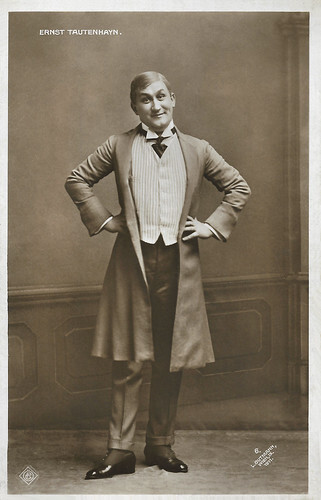
German postcard by P.R.A. - Verein Photographischer Reproduktions-Anstalten GmbH, Berlin, no. 6. Photo: L. Guttmann, Wien, 1911.
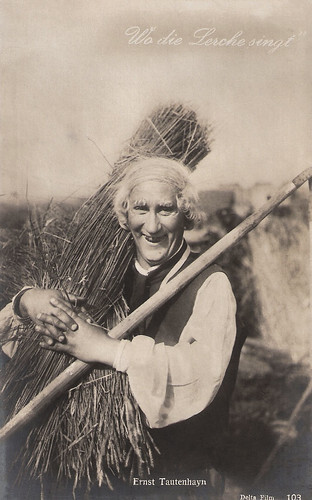
Austrian postcard by B.K.W.I. (Brüder Kohn, Wien), no. 103. Photo: Delta-Film. Ernst Tautenhayn in Wo die Lerche singt/Where the Lark Sings (Hubert Marischka, 1918).
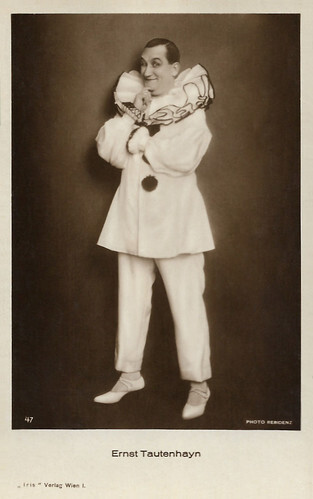
Austrian postcard by Iris Verlag, Wien, no. 47. Photo: Residenz.
A natural entertainer
Ernst Maximilian Tautenhayn was born in 1873 or 1874 (sources differ) in Vienna, Austria-Hungary. He was the son of the sculptor Josef Hermann Tautenhayn and Eleonore Eufrosina Tautenhayn.
The boy was a natural entertainer who was able to gain a foothold at the theatre in 1893 although he did not get acting or singing lessons. He debuted at the Lindentheater (or Theater Unter den Linden and later named Metropol-Theater) in Berlin.
From 1893 to 1895 he worked as a singer and actor in Graz and at the Carltheater in a suburb of Vienna, Leopoldstadt. Then he performed at the Landestheater in Linz and was a member of the Deutsches Theater in Prague.
From 1910 to 1920 he was an operetta tenor at the Theater an der Wien and later at the Bürger-, Carl- and Johann Strauß-Theater in Vienna.
Ernst Tautenhayn also performed at the Wiener Volksoper, the Vienna People's Opera. In the years up to and through the First World War the Volksoper attained a position as Vienna's second prestige opera house. In 1919, Felix Weingartner became artistic director and principal conductor.
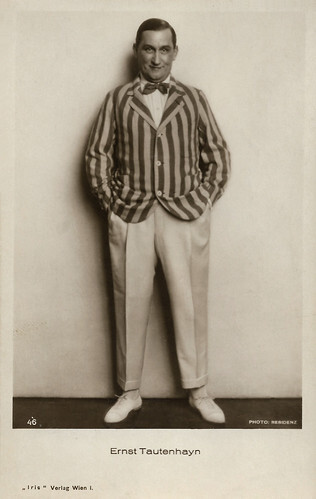
Austrian postcard by Iris Verlag, Wien, no. 46. Photo: Residenz.
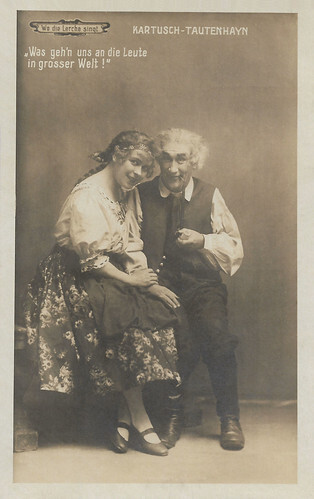
German postcard by B.K.W.L. Photo: L. Gutmann, 1918. Louise Kartusch and Ernst Tautenhayn in the stage operetta 'Wo die Lerche singt' (1918) by Franz Léhar.
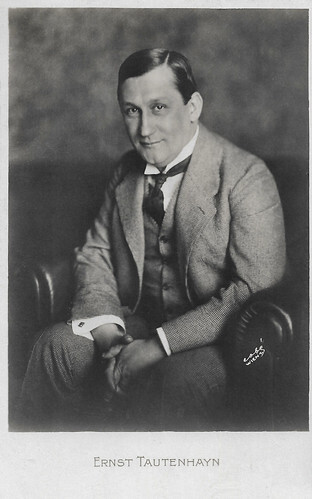
Austrian postcard by "Oce" Kunstverlag, Wien, 1919. Photo: Cobé, Wien.
Leading roles in Franz Lehár operettas
Ernst Tautenhayn appeared in four silent Austrian films. These included Mir kommt keiner aus/Nobody comes from (Jakob Fleck, Luise Kolm, 1917) with Liane Haid , Wo die Lerche singt/Where the Lark Sings (Hubert Marischka, 1918) with Louise Kartousch and Töte sie!/Kill Her (Ernst Marischka, 1920).
His fourth anbd last film was Dorala (N.N., 1921) with Lily Marischka, Hubert Marischka and Muck de Jary. He sang almost all the leading roles in Franz Lehár operettas on Viennese stages and became an audience favourite. Occasionally he also appeared in Prater establishments, e.g. Bundestheater im Kaisergarten.
On the occasion of the ‘referendum’ after the annexation of Austria in 1938, he wrote: ‘For me, this “yes” is the most beautiful “yes” of my life.’ In 1941, he became a professor at the newly opened Vienna Operetta School. Ernst Tautenhayn remained active as an artist till his death.
For a long time, he had only appeared in guest roles, but finally, the Vienna Opera House engaged him again for his earlier starring roles and organised a festive performance of ‘Die Fledermaus’ (The Bat) on the occasion of his 70th birthday in 1943, in which he appeared as Frosch for the last time.
Ernst Tautenhayn died in 1944 in Zlabings (Slavonice), Czechoslovakia, at 71. He was married to the singer Therese Schiner (Theresia Tautenhayn) and they had a daughter, Wilhelmine Tautenhayn. His grave, dedicated in his honour, is located in the Vienna Central Cemetery.
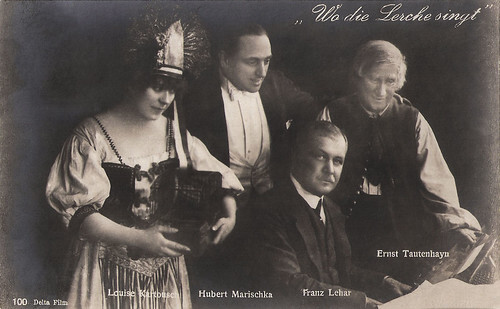
Austrian postcard by B.K.W.I. (Brüder Kohn, Wien), no. 100. Photo: Delta-Film. Louise Kartousch, Hubert Marischka, Franz Lehar and Ernst Tautenhayn on a publicity still for Wo die Lerche singt/Where the Lark Sings (Hubert Marischka, 1918).
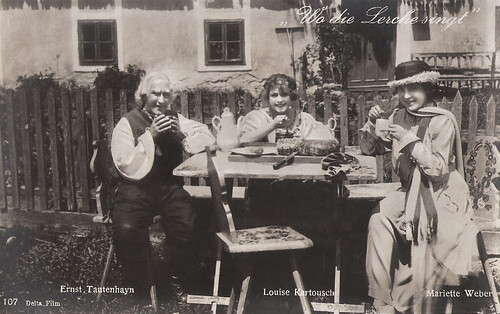
Austrian postcard by B.K.W.I. (Brüder Kohn, Wien), no. 107. Photo: Delta-Film. Ernst Tautenhayn, Louise Kartousch and Mariette Weber in Wo die Lerche singt/Where the Lark Sings (Hubert Marischka, 1918).
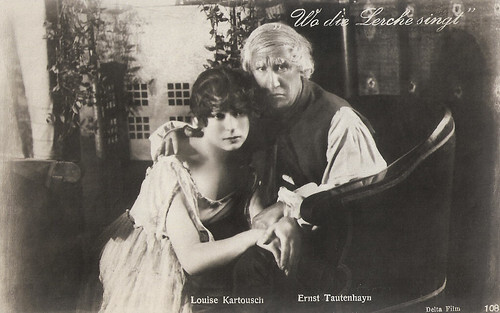
Austrian postcard by B.K.W.I. (Brüder Kohn, Wien), no. 108. Photo: Delta-Film. Louise Kartousch and Ernst Tautenhayn in Wo die Lerche singt/Where the Lark Sings (Hubert Marischka, 1918).
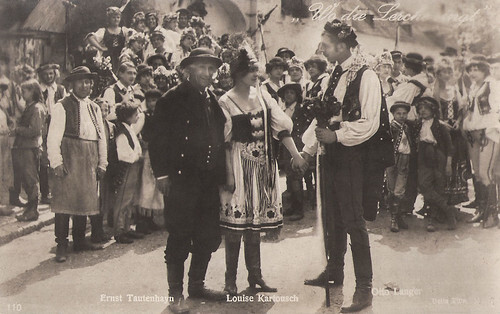
Austrian postcard by B.K.W.I. (Brüder Kohn, Wien), no. 110. Photo: Delta-Film. Ernst Tautenhayn, Louise Kartousch and Otto Langer in Wo die Lerche singt/Where the Lark Sings (Hubert Marischka, 1918).
Sources: Wien Geschichte Wiki (German), Geni, Wikipedia (German and English) and ,

German postcard by P.R.A. - Verein Photographischer Reproduktions-Anstalten GmbH, Berlin, no. 6. Photo: L. Guttmann, Wien, 1911.

Austrian postcard by B.K.W.I. (Brüder Kohn, Wien), no. 103. Photo: Delta-Film. Ernst Tautenhayn in Wo die Lerche singt/Where the Lark Sings (Hubert Marischka, 1918).

Austrian postcard by Iris Verlag, Wien, no. 47. Photo: Residenz.
A natural entertainer
Ernst Maximilian Tautenhayn was born in 1873 or 1874 (sources differ) in Vienna, Austria-Hungary. He was the son of the sculptor Josef Hermann Tautenhayn and Eleonore Eufrosina Tautenhayn.
The boy was a natural entertainer who was able to gain a foothold at the theatre in 1893 although he did not get acting or singing lessons. He debuted at the Lindentheater (or Theater Unter den Linden and later named Metropol-Theater) in Berlin.
From 1893 to 1895 he worked as a singer and actor in Graz and at the Carltheater in a suburb of Vienna, Leopoldstadt. Then he performed at the Landestheater in Linz and was a member of the Deutsches Theater in Prague.
From 1910 to 1920 he was an operetta tenor at the Theater an der Wien and later at the Bürger-, Carl- and Johann Strauß-Theater in Vienna.
Ernst Tautenhayn also performed at the Wiener Volksoper, the Vienna People's Opera. In the years up to and through the First World War the Volksoper attained a position as Vienna's second prestige opera house. In 1919, Felix Weingartner became artistic director and principal conductor.

Austrian postcard by Iris Verlag, Wien, no. 46. Photo: Residenz.

German postcard by B.K.W.L. Photo: L. Gutmann, 1918. Louise Kartusch and Ernst Tautenhayn in the stage operetta 'Wo die Lerche singt' (1918) by Franz Léhar.

Austrian postcard by "Oce" Kunstverlag, Wien, 1919. Photo: Cobé, Wien.
Leading roles in Franz Lehár operettas
Ernst Tautenhayn appeared in four silent Austrian films. These included Mir kommt keiner aus/Nobody comes from (Jakob Fleck, Luise Kolm, 1917) with Liane Haid , Wo die Lerche singt/Where the Lark Sings (Hubert Marischka, 1918) with Louise Kartousch and Töte sie!/Kill Her (Ernst Marischka, 1920).
His fourth anbd last film was Dorala (N.N., 1921) with Lily Marischka, Hubert Marischka and Muck de Jary. He sang almost all the leading roles in Franz Lehár operettas on Viennese stages and became an audience favourite. Occasionally he also appeared in Prater establishments, e.g. Bundestheater im Kaisergarten.
On the occasion of the ‘referendum’ after the annexation of Austria in 1938, he wrote: ‘For me, this “yes” is the most beautiful “yes” of my life.’ In 1941, he became a professor at the newly opened Vienna Operetta School. Ernst Tautenhayn remained active as an artist till his death.
For a long time, he had only appeared in guest roles, but finally, the Vienna Opera House engaged him again for his earlier starring roles and organised a festive performance of ‘Die Fledermaus’ (The Bat) on the occasion of his 70th birthday in 1943, in which he appeared as Frosch for the last time.
Ernst Tautenhayn died in 1944 in Zlabings (Slavonice), Czechoslovakia, at 71. He was married to the singer Therese Schiner (Theresia Tautenhayn) and they had a daughter, Wilhelmine Tautenhayn. His grave, dedicated in his honour, is located in the Vienna Central Cemetery.

Austrian postcard by B.K.W.I. (Brüder Kohn, Wien), no. 100. Photo: Delta-Film. Louise Kartousch, Hubert Marischka, Franz Lehar and Ernst Tautenhayn on a publicity still for Wo die Lerche singt/Where the Lark Sings (Hubert Marischka, 1918).

Austrian postcard by B.K.W.I. (Brüder Kohn, Wien), no. 107. Photo: Delta-Film. Ernst Tautenhayn, Louise Kartousch and Mariette Weber in Wo die Lerche singt/Where the Lark Sings (Hubert Marischka, 1918).

Austrian postcard by B.K.W.I. (Brüder Kohn, Wien), no. 108. Photo: Delta-Film. Louise Kartousch and Ernst Tautenhayn in Wo die Lerche singt/Where the Lark Sings (Hubert Marischka, 1918).

Austrian postcard by B.K.W.I. (Brüder Kohn, Wien), no. 110. Photo: Delta-Film. Ernst Tautenhayn, Louise Kartousch and Otto Langer in Wo die Lerche singt/Where the Lark Sings (Hubert Marischka, 1918).
Sources: Wien Geschichte Wiki (German), Geni, Wikipedia (German and English) and ,
Published on December 04, 2024 22:00
December 3, 2024
Ross Verlag, Part 13: XXL cards
During the 1930s, Ross Verlag published film star cards in several formats: you could collect postcards in different sizes, but also very small cigarette cards and so-called 'Film Grossbilder'. Ross produced these collector cards in an XXL format (each measuring 5 1/4" x 7" or 13 x 18 cm) in 1936-1937 for Union Cigarettenfabrik (Union Cigarette Factory). These large cigarette cards were available to those who purchased Romana cigarettes. They were printed in black and white and had no text or lines on the flip side. Here is a series of 15 of these extra-extra-large cards with glamorous female film stars and starlets.
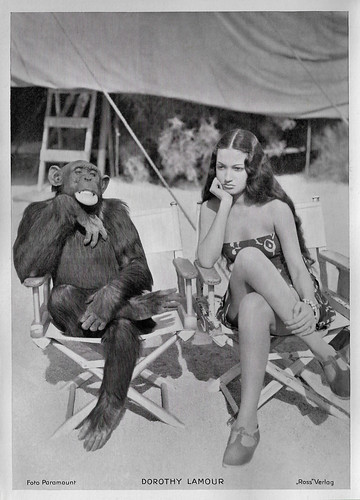
Big German card by Ross Verlag. Photo: Paramount.
American actress and singer Dorothy Lamour (1914-1996) is best remembered for appearing in the Road to... comedies, starring Bing Crosby and Bob Hope. During World War II, Lamour was among the most popular pin-up girls among American servicemen.
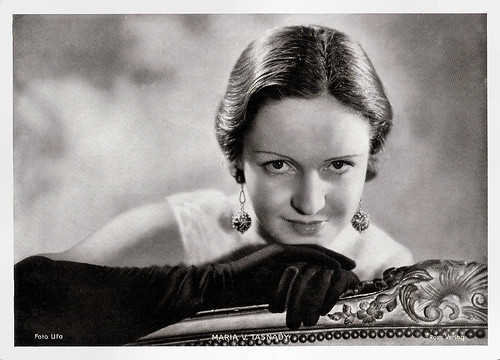
Big German card by Ross Verlag. Photo: Ufa.
Maria von Tasnady (1911-2001) was a Hungarian singer, stage, and film actress. She started her career as the Hungarian entrant at the 1931 Miss Europe pageant and then appeared in 25 German, Hungarian, and Italian films.
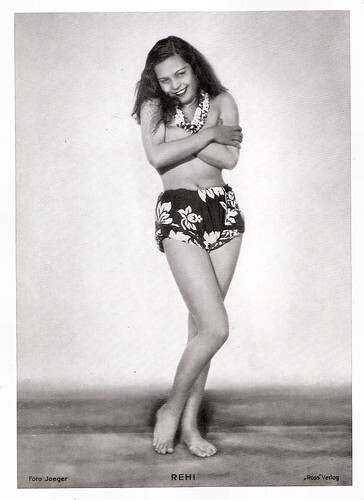
Big German card by Ross Verlag. Photo: Jaeger.
Reri was born as Anna Chevalier in 1912 in Bora-Bora, Tahiti. She was discovered by director Friedrich Wilhelm Murnau, who gave her the lead in his final film Tabu: A Story of the South Seas (1931). It is the tale of two young lovers on Bora Bora, the idyllic island in the South Pacific. Later she also appeared in the Polish film Czarna perla/Black Pearl (Michal Waszynski, 1934) and The Hurricane (John Ford, 1937). She died in 1977.
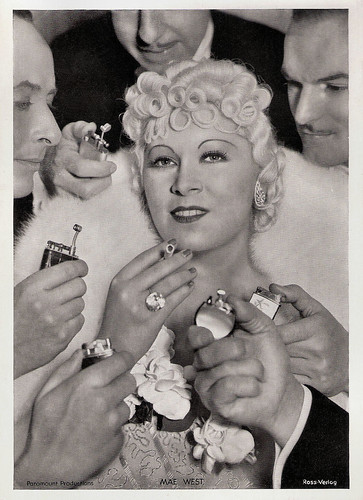
Big German card by Ross Verlag. Photo: Paramount Pictures.
Blonde Mae West (1895-1982) was a seductive, overdressed, endearing, intelligent, and sometimes vulgar American actress and sex symbol. She featured a come-hither voice, aggressive sexuality, and a comedy genius. West started in Vaudeville and on the stage in New York, and later moved to Hollywood to star in such films as I’m No Angel (1933), She Done Him Wrong (1933), and Klondike Annie (1936). She was one of the first women in the cinema to consistently write the films she starred in.
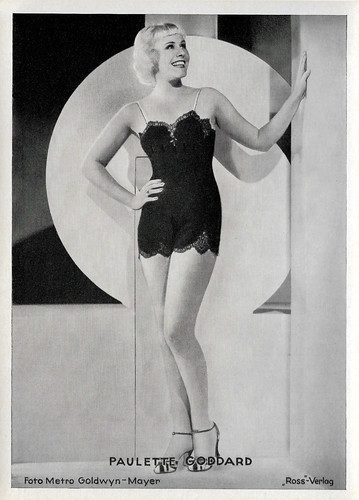
Big German card by Ross Verlag. Photo: Metro-Goldwyn-Mayer.
American actress Paulette Goddard (1905-1990) started her career as a fashion model and as a Ziegfeld Girl in several Broadway shows. In the 1940s, she became a major star of Paramount Pictures. She was Charlie Chaplin's leading lady in Modern Times (1936), and The Great Dictator. Goddard was nominated for an Oscar for Best Supporting Actress for So Proudly We Hail! (1943). Her husbands included Chaplin, Burgess Meredith, and Erich Maria Remarque.
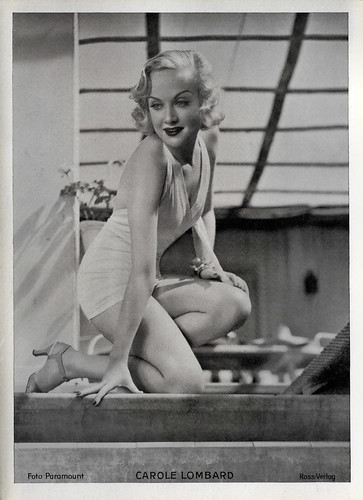
Big German card by Ross Verlag. Photo: Paramount.
American film actress Carole Lombard (1908–1942) was the highest-paid star in Hollywood in the late 1930s. She was particularly noted for her energetic, ditzy, and often off-beat roles in screwball comedies of the 1930s.
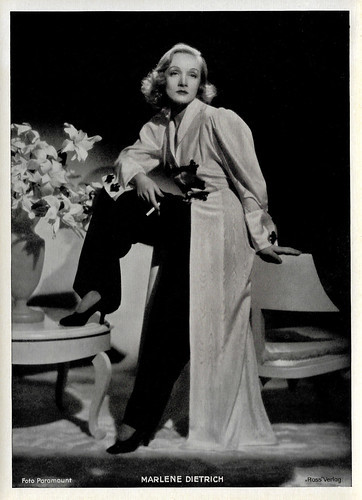
Big German card by Ross Verlag. Photo: Paramount.
Marlene Dietrich (1901-1992) is regarded as the first German actress to become successful in Hollywood. Throughout her long career, she constantly re-invented herself, starting as a cabaret singer, chorus girl, and film actress in 1920s Berlin, she became a Hollywood movie star in the 1930s, a World War II frontline entertainer, and finally an international stage show performer from the 1950s to the 1970s. Eventually, she became one of the entertainment icons of the 20th century.
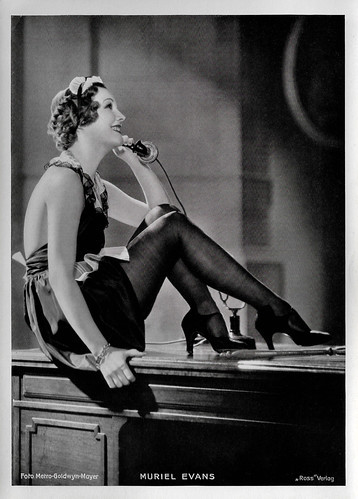
Big German card by Ross Verlag. Photo: Metro-Goldwyn-Mayer.
Lovely, blonde Muriel Evans (1910-2000) was an innocent-eyed actress of the late 1920s and 1930s She was best known for her many appearances in popular B-Westerns alongside Tom Mix, John Wayne, and Buck Jones. For this, she won a Golden Boot Award.
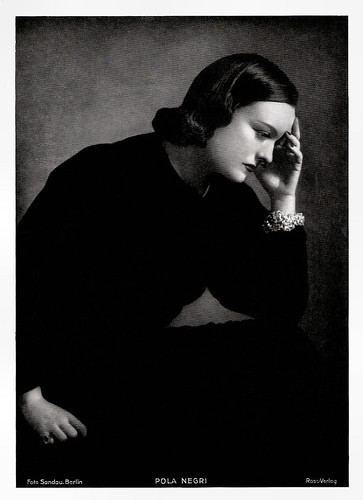
Big German card by Ross Verlag. Photo: Ernst Sandau, Berlin.
Polish film actress Pola Negri (1897-1987) achieved fame and notoriety as a femme fatale in German and American silent films between the 1910s and 1930s. Negri was an overnight sensation in Ernst Lubitsch's Madame du Barry/Passion (1919). She moved to Hollywood where she became a star and lived in a palace, modeled after the White House.
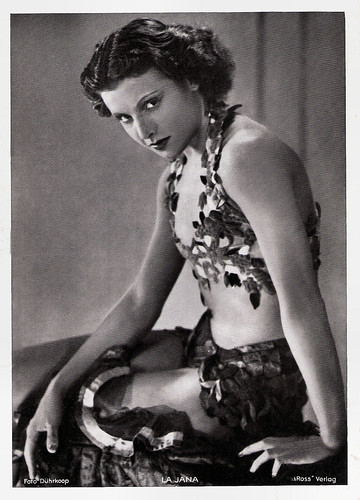
Big German card by Ross Verlag. Photo: Dührkoop.
Sexy German dancer and film actress La Jana (1905-1940) was the most popular showgirl in Berlin in the 1930s. She appeared in 25 European films, often dancing in exotic costumes. In 1940, she suddenly died of pneumonia and pleurisy.
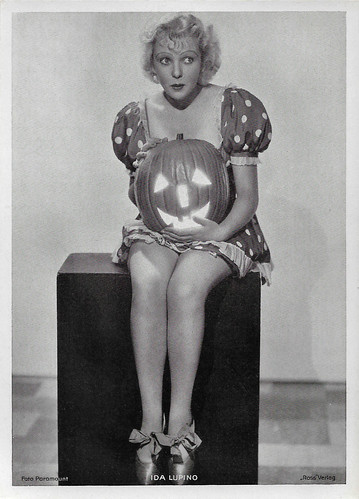
Big German card by Ross Verlag. Photo: Paramount.
Ida Lupino (1918-1995) was an English-American actress and singer, who became a pioneering director and producer—the only woman working within the 1950s Hollywood studio system to do so. With her independent production company, she co-wrote and co-produced several of her own social-message films, and was the first woman to direct a Film Noir, The Hitch-Hiker (1953). In her 48-year career, she acted in 59 films and directed 8, mostly in the United States, where she became a citizen in 1948. The majority of her later career as an actress, writer, and director was in television, where she directed more than 100 episodes of productions ranging across Westerns, supernatural tales, situation comedies, murder mysteries, and gangster stories.
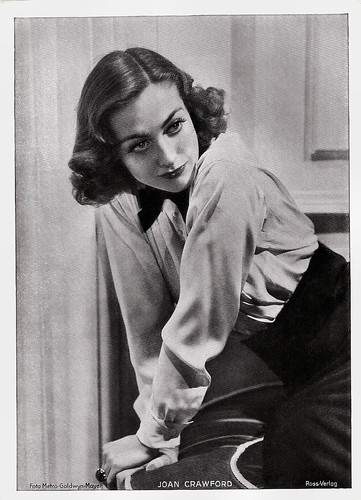
Big German card by Ross Verlag. Photo: Metro-Goldwyn-Mayer (MGM).
American actress Joan Crawford (1905-1977) became nationally known as a flapper by the end of the 1920s. In the 1930s, her fame rivalled, and later outlasted, MGM colleagues Norma Shearer and Greta Garbo. Crawford often played hardworking young women who found romance and success. These 'rags-to-riches' stories were well received by Depression-era audiences and were popular with women. Crawford became one of Hollywood's most prominent movie stars and one of the highest-paid women in the United States, but her films began losing money and by the end of the 1930s she was labelled 'Box Office Poison'. But her career gradually improved in the early 1940s, and she made a major comeback in 1945 by starring in Mildred Pierce, for which she won the Academy Award for Best Actress.
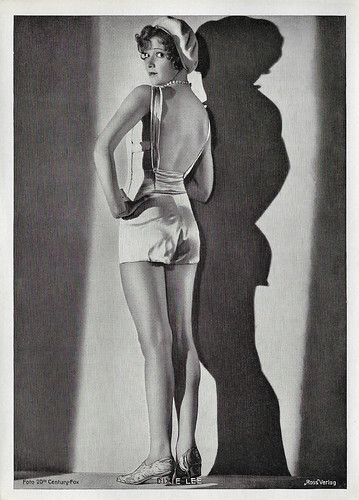
Big German card by Ross Verlag. Photo: 20th Century Fox.
Dixie Lee (1911–1952) was an American actress, dancer, and singer. She was the first wife of singer Bing Crosby. Her most notable films are probably the comedies The Big Party (1930) and Love in Bloom (1935) with George Burns and Gracie Allen.
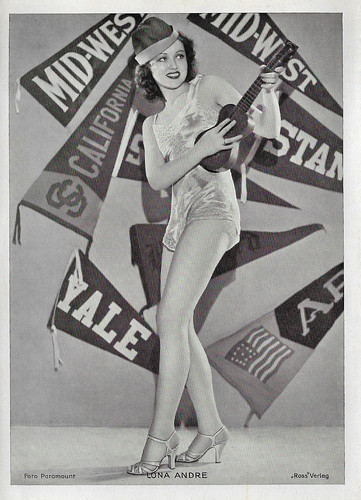
Big German card by Ross Verlag. Photo: Paramount.
Lona Andre (1915-1992) was an American film actress, golfer, and businesswoman. During the 1930s, she played in around 50 B-films. The major feature of the attractive actress was her cute dimples.
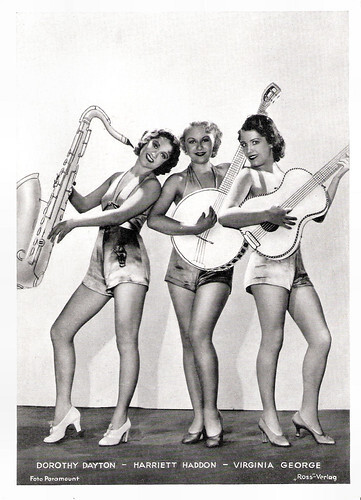
Big German card by Ross Verlag. Photo: Paramount.
From left to right the American chorus girls Dorothy Dayton (1908–1997), Harriett Haddon (1915–1999) and Virginia George. They all appeared - uncredited - in College Rhythm (Norman Taurog, 1934).
Our Ross Verlag tribute will be continued. In the meanwhile, please check out our Flickr album Ross Verlag XXL.

Big German card by Ross Verlag. Photo: Paramount.
American actress and singer Dorothy Lamour (1914-1996) is best remembered for appearing in the Road to... comedies, starring Bing Crosby and Bob Hope. During World War II, Lamour was among the most popular pin-up girls among American servicemen.

Big German card by Ross Verlag. Photo: Ufa.
Maria von Tasnady (1911-2001) was a Hungarian singer, stage, and film actress. She started her career as the Hungarian entrant at the 1931 Miss Europe pageant and then appeared in 25 German, Hungarian, and Italian films.

Big German card by Ross Verlag. Photo: Jaeger.
Reri was born as Anna Chevalier in 1912 in Bora-Bora, Tahiti. She was discovered by director Friedrich Wilhelm Murnau, who gave her the lead in his final film Tabu: A Story of the South Seas (1931). It is the tale of two young lovers on Bora Bora, the idyllic island in the South Pacific. Later she also appeared in the Polish film Czarna perla/Black Pearl (Michal Waszynski, 1934) and The Hurricane (John Ford, 1937). She died in 1977.

Big German card by Ross Verlag. Photo: Paramount Pictures.
Blonde Mae West (1895-1982) was a seductive, overdressed, endearing, intelligent, and sometimes vulgar American actress and sex symbol. She featured a come-hither voice, aggressive sexuality, and a comedy genius. West started in Vaudeville and on the stage in New York, and later moved to Hollywood to star in such films as I’m No Angel (1933), She Done Him Wrong (1933), and Klondike Annie (1936). She was one of the first women in the cinema to consistently write the films she starred in.

Big German card by Ross Verlag. Photo: Metro-Goldwyn-Mayer.
American actress Paulette Goddard (1905-1990) started her career as a fashion model and as a Ziegfeld Girl in several Broadway shows. In the 1940s, she became a major star of Paramount Pictures. She was Charlie Chaplin's leading lady in Modern Times (1936), and The Great Dictator. Goddard was nominated for an Oscar for Best Supporting Actress for So Proudly We Hail! (1943). Her husbands included Chaplin, Burgess Meredith, and Erich Maria Remarque.

Big German card by Ross Verlag. Photo: Paramount.
American film actress Carole Lombard (1908–1942) was the highest-paid star in Hollywood in the late 1930s. She was particularly noted for her energetic, ditzy, and often off-beat roles in screwball comedies of the 1930s.

Big German card by Ross Verlag. Photo: Paramount.
Marlene Dietrich (1901-1992) is regarded as the first German actress to become successful in Hollywood. Throughout her long career, she constantly re-invented herself, starting as a cabaret singer, chorus girl, and film actress in 1920s Berlin, she became a Hollywood movie star in the 1930s, a World War II frontline entertainer, and finally an international stage show performer from the 1950s to the 1970s. Eventually, she became one of the entertainment icons of the 20th century.

Big German card by Ross Verlag. Photo: Metro-Goldwyn-Mayer.
Lovely, blonde Muriel Evans (1910-2000) was an innocent-eyed actress of the late 1920s and 1930s She was best known for her many appearances in popular B-Westerns alongside Tom Mix, John Wayne, and Buck Jones. For this, she won a Golden Boot Award.

Big German card by Ross Verlag. Photo: Ernst Sandau, Berlin.
Polish film actress Pola Negri (1897-1987) achieved fame and notoriety as a femme fatale in German and American silent films between the 1910s and 1930s. Negri was an overnight sensation in Ernst Lubitsch's Madame du Barry/Passion (1919). She moved to Hollywood where she became a star and lived in a palace, modeled after the White House.

Big German card by Ross Verlag. Photo: Dührkoop.
Sexy German dancer and film actress La Jana (1905-1940) was the most popular showgirl in Berlin in the 1930s. She appeared in 25 European films, often dancing in exotic costumes. In 1940, she suddenly died of pneumonia and pleurisy.

Big German card by Ross Verlag. Photo: Paramount.
Ida Lupino (1918-1995) was an English-American actress and singer, who became a pioneering director and producer—the only woman working within the 1950s Hollywood studio system to do so. With her independent production company, she co-wrote and co-produced several of her own social-message films, and was the first woman to direct a Film Noir, The Hitch-Hiker (1953). In her 48-year career, she acted in 59 films and directed 8, mostly in the United States, where she became a citizen in 1948. The majority of her later career as an actress, writer, and director was in television, where she directed more than 100 episodes of productions ranging across Westerns, supernatural tales, situation comedies, murder mysteries, and gangster stories.

Big German card by Ross Verlag. Photo: Metro-Goldwyn-Mayer (MGM).
American actress Joan Crawford (1905-1977) became nationally known as a flapper by the end of the 1920s. In the 1930s, her fame rivalled, and later outlasted, MGM colleagues Norma Shearer and Greta Garbo. Crawford often played hardworking young women who found romance and success. These 'rags-to-riches' stories were well received by Depression-era audiences and were popular with women. Crawford became one of Hollywood's most prominent movie stars and one of the highest-paid women in the United States, but her films began losing money and by the end of the 1930s she was labelled 'Box Office Poison'. But her career gradually improved in the early 1940s, and she made a major comeback in 1945 by starring in Mildred Pierce, for which she won the Academy Award for Best Actress.

Big German card by Ross Verlag. Photo: 20th Century Fox.
Dixie Lee (1911–1952) was an American actress, dancer, and singer. She was the first wife of singer Bing Crosby. Her most notable films are probably the comedies The Big Party (1930) and Love in Bloom (1935) with George Burns and Gracie Allen.

Big German card by Ross Verlag. Photo: Paramount.
Lona Andre (1915-1992) was an American film actress, golfer, and businesswoman. During the 1930s, she played in around 50 B-films. The major feature of the attractive actress was her cute dimples.

Big German card by Ross Verlag. Photo: Paramount.
From left to right the American chorus girls Dorothy Dayton (1908–1997), Harriett Haddon (1915–1999) and Virginia George. They all appeared - uncredited - in College Rhythm (Norman Taurog, 1934).
Our Ross Verlag tribute will be continued. In the meanwhile, please check out our Flickr album Ross Verlag XXL.
Published on December 03, 2024 22:00
December 1, 2024
Karin Baal (1940-2024)
On 26 November 20204, German film actress Karin Baal (1940-2024) passed away. She has appeared in over 90 films since 1956. Baal started as a teenage rebel in the cult film Die Halbstarken (1956) and became one of the brightest stars of the Wirtschaftswunder cinema. She was 84.

Austrian postcard by Lichtbild-Vertrieb Paula Weizmann, Wien, no. F 7. Photo: Interwest / Union-Film / Haenchen. Publicity still for Die Halbstarken/Teenage Wolfpack (Georg Tressler, 1956) with Horst Buchholz .
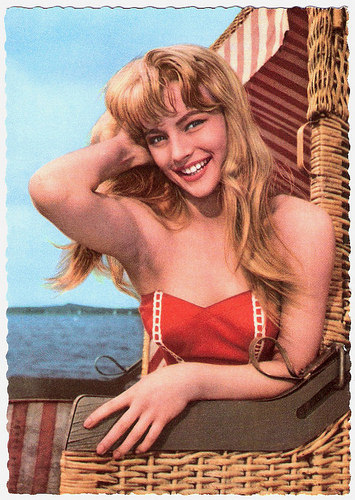
German postcard by Universum-Film Aktiengesellschaft (Ufa), Berlin-Tempelhof, no. CK 190. Retail price: 30 Pfg. Photo: Klaus Collignon / Ufa.
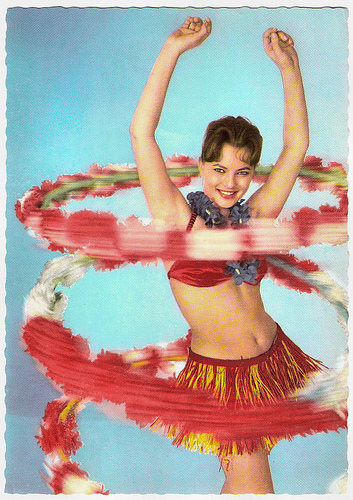
German postcard by Universum-Film Aktiengesellschaft (Ufa), Berlin-Tempelhof, no. CK 291. Retail price: 30 Pfg. Photo: Joe Niczky / Ufa.
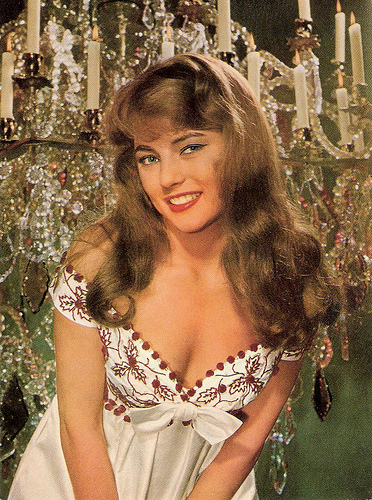
German postcard by Universum-Film Aktiengesellschaft (Ufa), Berlin-Tempelhof, no. CK 334. Photo: Klaus Collignon / Ufa.
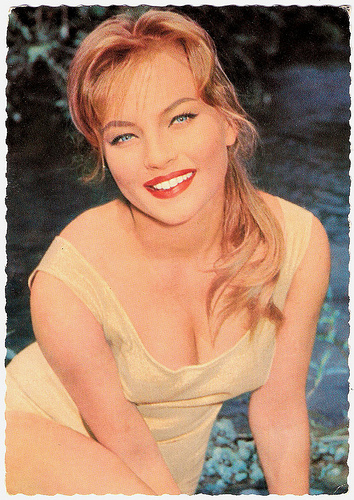
German postcard by Universum-Film Aktiengesellschaft (Ufa), Berlin-Tempelhof, no. CK 392. Retail price: 30 Pfg. Photo: Georg Michalke / Ufa.
Zeitgeist
Karin Baal was born as Karin Blauermel in Berlin, Germany, in 1940. Her mother was a seamstress. She and her brother grew up under difficult social conditions without a father and living with their grandmother. After finishing secondary school, she attended a school for fashion design.
In 1956, she learned that a young actress was sought for the film Die Halbstarken/The Hooligans (Georg Tressler, 1956), which embodied the so-called Zeitgeist. Without any acting training, the 16-year-old Baal was chosen out of 700 applicants to play the main female role opposite Horst Buchholz . She also got a three-year actor training contract. Filmportal.de : “In Georg Tressler's film, Baal made a convincing performance as the 15-year old Sissy Bohl, who – with her self-confidence and aplomb – is superior to the boys and in the end does not shy away from taking up arms.”
From then on she was cast in roles as a blonde rebel. She played a supporting role as a prostitute in Das Mädchen Rosemarie/The Girl Rosemarie (Rolf Thiele, 1958), a film adaptation of the scandalous life and death of the prostitute Rosemarie Nitribitt ( Nadja Tiller ).
She played another ‘loose girl’ in Arzt ohne Gewissen/Doctor Without Scruples (Falk Harnack, 1959), she was a teenage delinquent in Der Jugendrichter/The Judge and the Sinner (Paul Verhoeven, 1959) opposite Heinz Rühmann , and she seduced the father ( Rudolf Prack ) of her friend in Die junge Sünderin/The Young Sinner (Rudolf Jugert, 1960).
In 1959 she finished her acting training and had her first stage roles in München (Munich). From then on, she regularly appeared on stage. In 1959, she married boyfriend and fellow actor from Die Halbstarken, Karl Heinz Gaffkus, with whom she has a son, Thomas. They divorced two years later, and Baal married in 1962 with actor Helmuth Lohner. In 1967 their daughter Therese Lohner was born, who became an actress too.
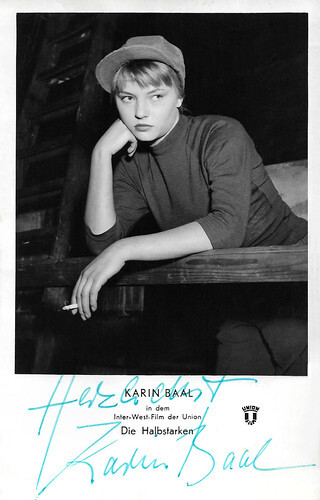
German autograph card by Labphoto. Photo: Inter-West Film / Union Film. Karin Baal in Die Halbstarken/The Hooligans (Georg Tressler, 1956).
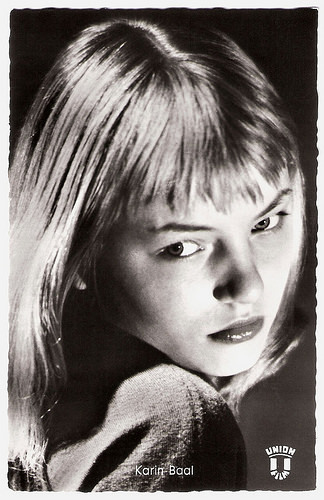
German postcard by Kolibri-Verlag, Minden/Westf., no. 2096. Photo: Interwest / Union. Publicity still for Die Halbstarken (1956).
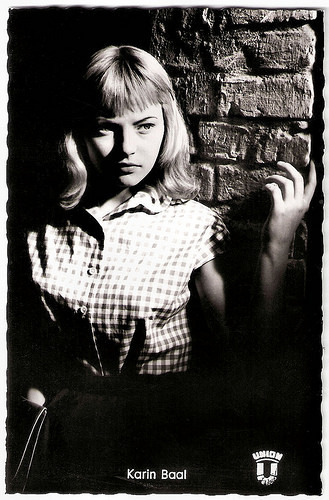
German postcard by Kolibri-Verlag, Minden/Westf. Photo: Interwest / Union / Haenchen. Publicity still for Die Halbstarken (1956).
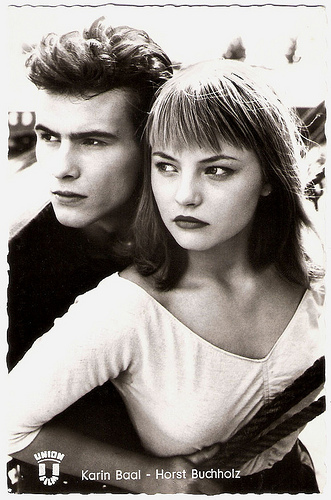
German postcard by Kolibri-Verlag, Minden/Westf., no. 2329. Photo: Interwest / Union / Haenchen. Publicity still for Die Halbstarken/The Hooligans (Georg Tressler, 1956) with Horst Buchholz .
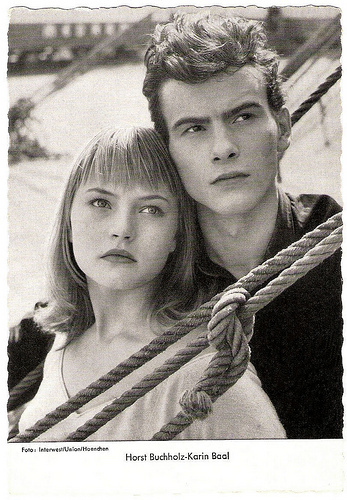
German postcard by WS-Druck, Wanne-Eickel. Photo: Interwest / Union / Haenchen. Publicity still for Die Halbstarken/The Hooligans (Georg Tressler, 1956) with Horst Buchholz .
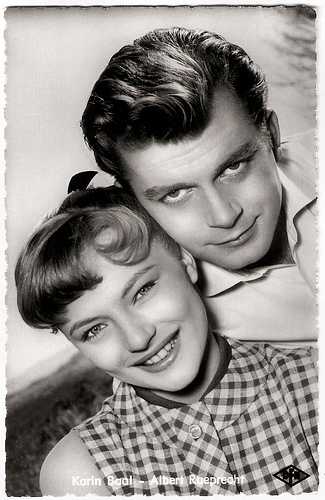
German postcard by Kolibri-Verlag, Minden/Westf., no. 2507. Photo: DFH / Lilo. Publicity still for Der müde Theodor/Tired Theodore (Géza von Cziffra, 1957) with Albert Rueprecht.
Threatened blonde innocence
In 1961 Karin Baal was awarded the Silver Bambi award and the prize of the German Film Critics for Best Young Actress. In the 1960s she appeared in several Edgar Wallace thrillers, including Die Toten Augen von London/The Dark Eyes of London (Alfred Vohrer, 1961) with Joachim Fuchsberger , and Der Hund von Blackwood Castle/The Hound of Blackwood Castle (Alfred Vohrer, 1967).
Her parts as the threatened blonde innocence in these thrillers were a break from the independent characters she had played in the 1950s. In 1966 she was again awarded, this time with the Golden Camera by the magazine Hörzu. She incidentally appeared in international films, such as the thriller Hannibal Brooks (Michael Winner, 1969) starring Oliver Reed .
From the 1970s on, Baal was offered fewer film roles and focused on television. She often guest-starred in such Krimi series as Der Kommissar/The Commissioner (1975), Tatort (1979 and 1990), Derrick (1980 and 1981), Die Männer vom K3/The Men from K3 (1987 and 1991), Ein Fall für Zwei/A Case for Two (1990 and 1995), Der Alte/The Old Man (1990), Marleneken (1990), Doppelter Einsatz/Double Down (1994), Rosa Roth (1995) and Polizeiruf 110/Police 110 (1996).
On TV she also played leading roles in the six-part series Ein Jahr ohne Sonntag/A Year Without Sundays (1970) opposite Götz George , and in the 13-part TV series Wenn Engel reisen/When Angels Travel (Uwe Friessner, 1993). She also worked in popular family TV shows like Liebling Kreuzberg (1985), Schwarzwaldklinik/Black Forest Clinic (1985), and Praxis Bülowbogen/Practice Bülowbogen (1990).
In Ula Stöckl's Erikas Leidenschaften/Erika's Passions (1976), a two-person film with Vera Tschechowa , Baal's role starts out as a 'little woman' but becomes more and more confident in the course of the film. In Desperado City (Vadim Glowna, 1980), Baal played a cab driver and was able to show her former strength once more as part of the personality of an elderly woman.
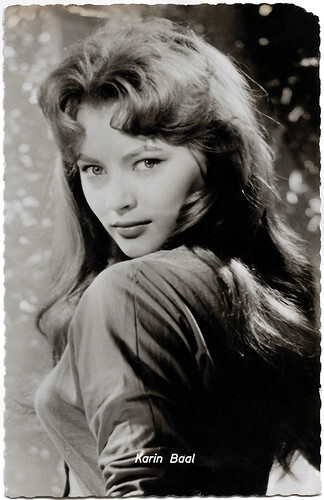
German postcard by Kolibri-Verlag G.m.b.H., Minden/Westf, no. 914. Photo: Weidenbaum.
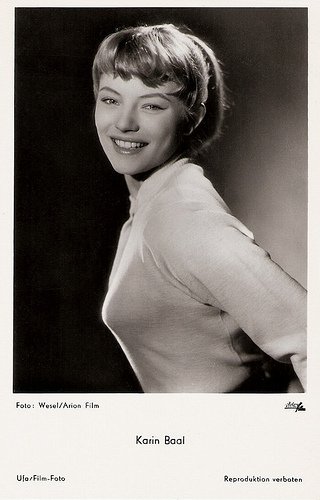
German postcard by Universum-Film Aktiengesellschaft (Ufa), Berlin-Tempelhof, no. FK 3567. Retail price: 25 Pfg. Photo: Wesel / Arion Film.
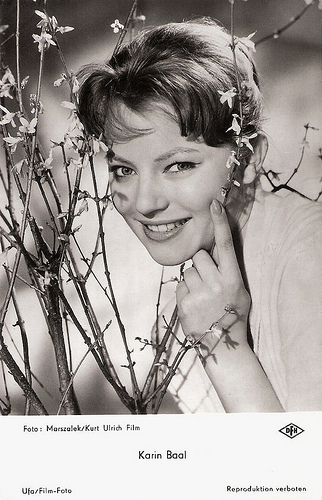
German postcard by Universum-Film Aktiengesellschaft (Ufa), Berlin-Tempelhof, no. 4489. Retail price: 25 Pfg. Photo: Mrszalek / Kurt Ulrich-Film/DFH. Publicity still for So angelt man keinen Mann/That's No Way to Land a Man (Hans Deppe, 1959).
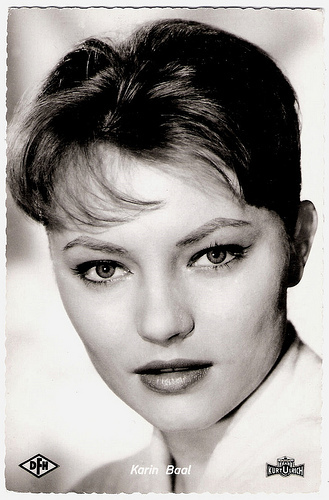
German postcard by Kolibri-Verlag, Minden/Westf., no. 626. Photo: Kurt Ulrich-Film / Dt. Film Hansa (DFH) / Marszalek. Publicity still for So angelt man keinen Mann/That's No Way to Land a Man (Hans Deppe, 1959).
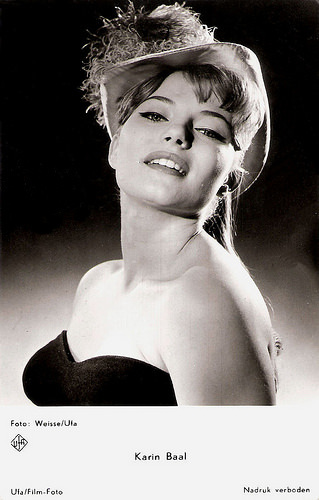
Dutch postcard by Gebr. Spanjersberg N.V., Rotterdam no. 1324. Photo: Weisse / Ufa.
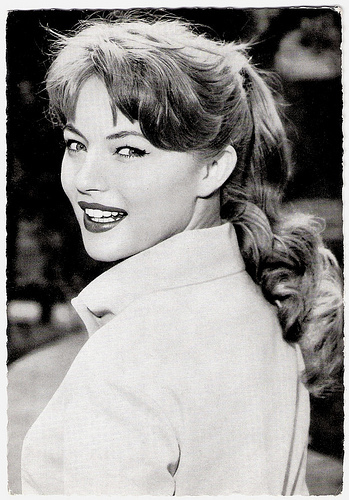
German postcard by Filmbilder-Vertrieb Ernst Freihoff, Essen no. 616. Photo: Erwin Schneider.
Alcohol problems and break-downs
Karin Baal collaborated three times with filmmaker Rainer Werner Fassbinder . She played Franz Biberkopf’s ( Günther Lamprecht ) sister-in-law in the monumental TV series Berlin Alexanderplatz (Rainer Werner Fassbinder, 1979), a resistance fighter in Lili Marleen (Rainer Werner Fassbinder, 1980) and Barbara Sukowa’s mother in Lola (Rainer Werner Fassbinder, 1981).
Other prominent film roles were her parts in Reinhard Hauff‘s Der Mann auf der Mauer/The Man at the Wall (1982), and Margarethe von Trotta‘s Rosa Luxemburg (1986) starring Barbara Sukowa. Highlights of her theatre work were the plays 'Die verlorene Ehre der Katharina Blum' (The Lost Honour of Katharina Blum, 1977) based on the novel by Heinrich Böll, 'Geschlossene Gesellschaft' (No Exit, 1986) based on Jean-Paul Sartre’s 'Huis Clos', and 'Mord um Mitternacht' (Murder at Midnight, 1986) based on the thriller by Francis Durbridge.
Baal divorced from Helmut Lohner in 1977. Her third husband was actor Volker Eckstein, who died of cancer in 1993. His death rushed her into a severe personal crisis for seven years. Alcohol problems and break-downs damaged her career. In 2006 she made her stage comeback with the play '8 Frauen' (8 Women) in which she appeared opposite her daughter, Therese Lohner. At the same time, she was honoured with a retrospective at the Düsseldorf Film Museum. In 2000 she married the 30-years-younger Kurdish actor Cevdet Çelik, from whom she lived separately since 2004.
Among her later films were Der Tunnel/The Tunnel (Roland Suso Richter, 2001) with Sebastian Koch , based on a true story about a group of East Berliners escaping to the West, and the drama Sieben Tage Sonntag/Seven Days Sunday (Niels Laupert, 2006) of two bored 16-year-old boys who murder an innocent human being.
Her final film was Vergiss nie, dass ich Dich Liebe/Remember I'll Always Love You (Carlo Rola, 2011). In 2012, she published her memoir 'Ungezähmt – Mein Leben' (Untamed - My Life). Karin Baal died on 26 November 2024 in Berlin, at the age of 84.
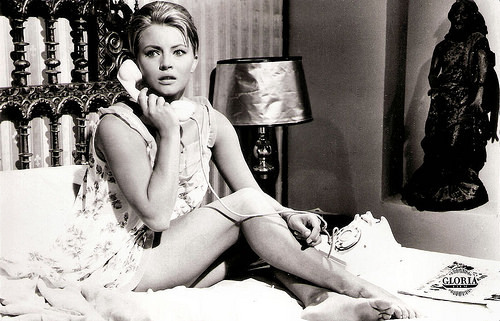
German postcard by Kolibri-Verlag, Minden/Westf, no. 1898. Photo: Rapid / Gloria / Guzman. Publicity still for Zwischen Schanghai und St. Pauli/Voyage to Danger (Roberto Bianchi Montero, Wolfgang Schleif, 1962).
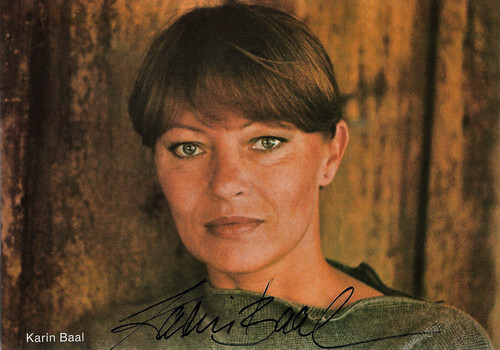
German postcard by Rüdel-Verlag, Hamburg. Photo: Virginia Schmidt.
Scene from Die Halbstarken (1956). Source: Susiedarling69 (YouTube).
Trailer for Lola (1981). Source: RialtoFilm (YouTube).
Sources: Stephanie D’heil (Steffi-line - German), Filmportal (German), Stiftung Haus der Geschichte der Bundesrepublik Deutschland (German), Prisma.de (German), Wikipedia (German) and .

Austrian postcard by Lichtbild-Vertrieb Paula Weizmann, Wien, no. F 7. Photo: Interwest / Union-Film / Haenchen. Publicity still for Die Halbstarken/Teenage Wolfpack (Georg Tressler, 1956) with Horst Buchholz .

German postcard by Universum-Film Aktiengesellschaft (Ufa), Berlin-Tempelhof, no. CK 190. Retail price: 30 Pfg. Photo: Klaus Collignon / Ufa.

German postcard by Universum-Film Aktiengesellschaft (Ufa), Berlin-Tempelhof, no. CK 291. Retail price: 30 Pfg. Photo: Joe Niczky / Ufa.

German postcard by Universum-Film Aktiengesellschaft (Ufa), Berlin-Tempelhof, no. CK 334. Photo: Klaus Collignon / Ufa.

German postcard by Universum-Film Aktiengesellschaft (Ufa), Berlin-Tempelhof, no. CK 392. Retail price: 30 Pfg. Photo: Georg Michalke / Ufa.
Zeitgeist
Karin Baal was born as Karin Blauermel in Berlin, Germany, in 1940. Her mother was a seamstress. She and her brother grew up under difficult social conditions without a father and living with their grandmother. After finishing secondary school, she attended a school for fashion design.
In 1956, she learned that a young actress was sought for the film Die Halbstarken/The Hooligans (Georg Tressler, 1956), which embodied the so-called Zeitgeist. Without any acting training, the 16-year-old Baal was chosen out of 700 applicants to play the main female role opposite Horst Buchholz . She also got a three-year actor training contract. Filmportal.de : “In Georg Tressler's film, Baal made a convincing performance as the 15-year old Sissy Bohl, who – with her self-confidence and aplomb – is superior to the boys and in the end does not shy away from taking up arms.”
From then on she was cast in roles as a blonde rebel. She played a supporting role as a prostitute in Das Mädchen Rosemarie/The Girl Rosemarie (Rolf Thiele, 1958), a film adaptation of the scandalous life and death of the prostitute Rosemarie Nitribitt ( Nadja Tiller ).
She played another ‘loose girl’ in Arzt ohne Gewissen/Doctor Without Scruples (Falk Harnack, 1959), she was a teenage delinquent in Der Jugendrichter/The Judge and the Sinner (Paul Verhoeven, 1959) opposite Heinz Rühmann , and she seduced the father ( Rudolf Prack ) of her friend in Die junge Sünderin/The Young Sinner (Rudolf Jugert, 1960).
In 1959 she finished her acting training and had her first stage roles in München (Munich). From then on, she regularly appeared on stage. In 1959, she married boyfriend and fellow actor from Die Halbstarken, Karl Heinz Gaffkus, with whom she has a son, Thomas. They divorced two years later, and Baal married in 1962 with actor Helmuth Lohner. In 1967 their daughter Therese Lohner was born, who became an actress too.

German autograph card by Labphoto. Photo: Inter-West Film / Union Film. Karin Baal in Die Halbstarken/The Hooligans (Georg Tressler, 1956).

German postcard by Kolibri-Verlag, Minden/Westf., no. 2096. Photo: Interwest / Union. Publicity still for Die Halbstarken (1956).

German postcard by Kolibri-Verlag, Minden/Westf. Photo: Interwest / Union / Haenchen. Publicity still for Die Halbstarken (1956).

German postcard by Kolibri-Verlag, Minden/Westf., no. 2329. Photo: Interwest / Union / Haenchen. Publicity still for Die Halbstarken/The Hooligans (Georg Tressler, 1956) with Horst Buchholz .

German postcard by WS-Druck, Wanne-Eickel. Photo: Interwest / Union / Haenchen. Publicity still for Die Halbstarken/The Hooligans (Georg Tressler, 1956) with Horst Buchholz .

German postcard by Kolibri-Verlag, Minden/Westf., no. 2507. Photo: DFH / Lilo. Publicity still for Der müde Theodor/Tired Theodore (Géza von Cziffra, 1957) with Albert Rueprecht.
Threatened blonde innocence
In 1961 Karin Baal was awarded the Silver Bambi award and the prize of the German Film Critics for Best Young Actress. In the 1960s she appeared in several Edgar Wallace thrillers, including Die Toten Augen von London/The Dark Eyes of London (Alfred Vohrer, 1961) with Joachim Fuchsberger , and Der Hund von Blackwood Castle/The Hound of Blackwood Castle (Alfred Vohrer, 1967).
Her parts as the threatened blonde innocence in these thrillers were a break from the independent characters she had played in the 1950s. In 1966 she was again awarded, this time with the Golden Camera by the magazine Hörzu. She incidentally appeared in international films, such as the thriller Hannibal Brooks (Michael Winner, 1969) starring Oliver Reed .
From the 1970s on, Baal was offered fewer film roles and focused on television. She often guest-starred in such Krimi series as Der Kommissar/The Commissioner (1975), Tatort (1979 and 1990), Derrick (1980 and 1981), Die Männer vom K3/The Men from K3 (1987 and 1991), Ein Fall für Zwei/A Case for Two (1990 and 1995), Der Alte/The Old Man (1990), Marleneken (1990), Doppelter Einsatz/Double Down (1994), Rosa Roth (1995) and Polizeiruf 110/Police 110 (1996).
On TV she also played leading roles in the six-part series Ein Jahr ohne Sonntag/A Year Without Sundays (1970) opposite Götz George , and in the 13-part TV series Wenn Engel reisen/When Angels Travel (Uwe Friessner, 1993). She also worked in popular family TV shows like Liebling Kreuzberg (1985), Schwarzwaldklinik/Black Forest Clinic (1985), and Praxis Bülowbogen/Practice Bülowbogen (1990).
In Ula Stöckl's Erikas Leidenschaften/Erika's Passions (1976), a two-person film with Vera Tschechowa , Baal's role starts out as a 'little woman' but becomes more and more confident in the course of the film. In Desperado City (Vadim Glowna, 1980), Baal played a cab driver and was able to show her former strength once more as part of the personality of an elderly woman.

German postcard by Kolibri-Verlag G.m.b.H., Minden/Westf, no. 914. Photo: Weidenbaum.

German postcard by Universum-Film Aktiengesellschaft (Ufa), Berlin-Tempelhof, no. FK 3567. Retail price: 25 Pfg. Photo: Wesel / Arion Film.

German postcard by Universum-Film Aktiengesellschaft (Ufa), Berlin-Tempelhof, no. 4489. Retail price: 25 Pfg. Photo: Mrszalek / Kurt Ulrich-Film/DFH. Publicity still for So angelt man keinen Mann/That's No Way to Land a Man (Hans Deppe, 1959).

German postcard by Kolibri-Verlag, Minden/Westf., no. 626. Photo: Kurt Ulrich-Film / Dt. Film Hansa (DFH) / Marszalek. Publicity still for So angelt man keinen Mann/That's No Way to Land a Man (Hans Deppe, 1959).

Dutch postcard by Gebr. Spanjersberg N.V., Rotterdam no. 1324. Photo: Weisse / Ufa.

German postcard by Filmbilder-Vertrieb Ernst Freihoff, Essen no. 616. Photo: Erwin Schneider.
Alcohol problems and break-downs
Karin Baal collaborated three times with filmmaker Rainer Werner Fassbinder . She played Franz Biberkopf’s ( Günther Lamprecht ) sister-in-law in the monumental TV series Berlin Alexanderplatz (Rainer Werner Fassbinder, 1979), a resistance fighter in Lili Marleen (Rainer Werner Fassbinder, 1980) and Barbara Sukowa’s mother in Lola (Rainer Werner Fassbinder, 1981).
Other prominent film roles were her parts in Reinhard Hauff‘s Der Mann auf der Mauer/The Man at the Wall (1982), and Margarethe von Trotta‘s Rosa Luxemburg (1986) starring Barbara Sukowa. Highlights of her theatre work were the plays 'Die verlorene Ehre der Katharina Blum' (The Lost Honour of Katharina Blum, 1977) based on the novel by Heinrich Böll, 'Geschlossene Gesellschaft' (No Exit, 1986) based on Jean-Paul Sartre’s 'Huis Clos', and 'Mord um Mitternacht' (Murder at Midnight, 1986) based on the thriller by Francis Durbridge.
Baal divorced from Helmut Lohner in 1977. Her third husband was actor Volker Eckstein, who died of cancer in 1993. His death rushed her into a severe personal crisis for seven years. Alcohol problems and break-downs damaged her career. In 2006 she made her stage comeback with the play '8 Frauen' (8 Women) in which she appeared opposite her daughter, Therese Lohner. At the same time, she was honoured with a retrospective at the Düsseldorf Film Museum. In 2000 she married the 30-years-younger Kurdish actor Cevdet Çelik, from whom she lived separately since 2004.
Among her later films were Der Tunnel/The Tunnel (Roland Suso Richter, 2001) with Sebastian Koch , based on a true story about a group of East Berliners escaping to the West, and the drama Sieben Tage Sonntag/Seven Days Sunday (Niels Laupert, 2006) of two bored 16-year-old boys who murder an innocent human being.
Her final film was Vergiss nie, dass ich Dich Liebe/Remember I'll Always Love You (Carlo Rola, 2011). In 2012, she published her memoir 'Ungezähmt – Mein Leben' (Untamed - My Life). Karin Baal died on 26 November 2024 in Berlin, at the age of 84.

German postcard by Kolibri-Verlag, Minden/Westf, no. 1898. Photo: Rapid / Gloria / Guzman. Publicity still for Zwischen Schanghai und St. Pauli/Voyage to Danger (Roberto Bianchi Montero, Wolfgang Schleif, 1962).

German postcard by Rüdel-Verlag, Hamburg. Photo: Virginia Schmidt.
Scene from Die Halbstarken (1956). Source: Susiedarling69 (YouTube).
Trailer for Lola (1981). Source: RialtoFilm (YouTube).
Sources: Stephanie D’heil (Steffi-line - German), Filmportal (German), Stiftung Haus der Geschichte der Bundesrepublik Deutschland (German), Prisma.de (German), Wikipedia (German) and .
Published on December 01, 2024 22:00
Paul van Yperen's Blog
- Paul van Yperen's profile
- 13 followers
Paul van Yperen isn't a Goodreads Author
(yet),
but they
do have a blog,
so here are some recent posts imported from
their feed.



